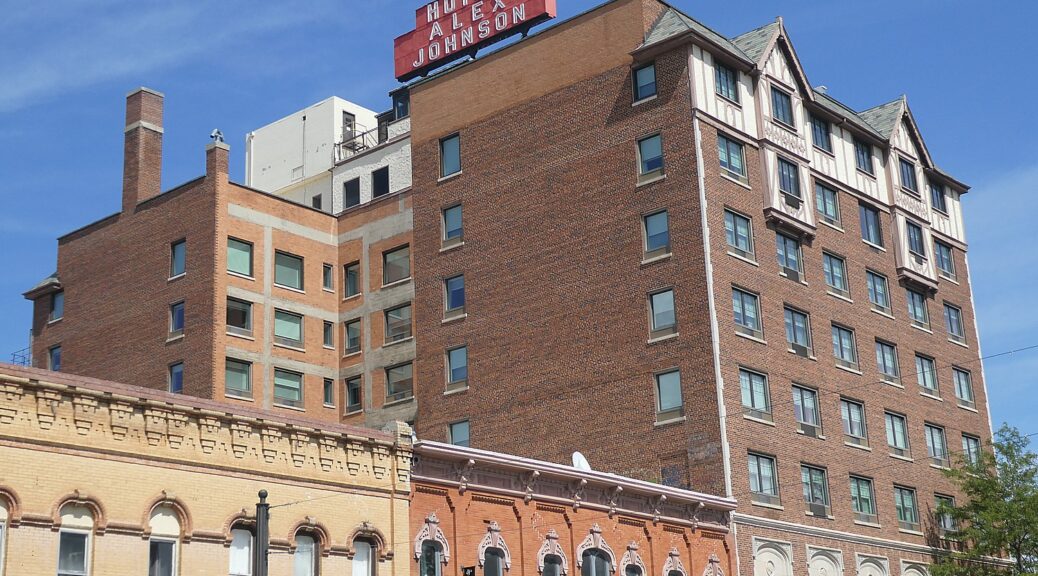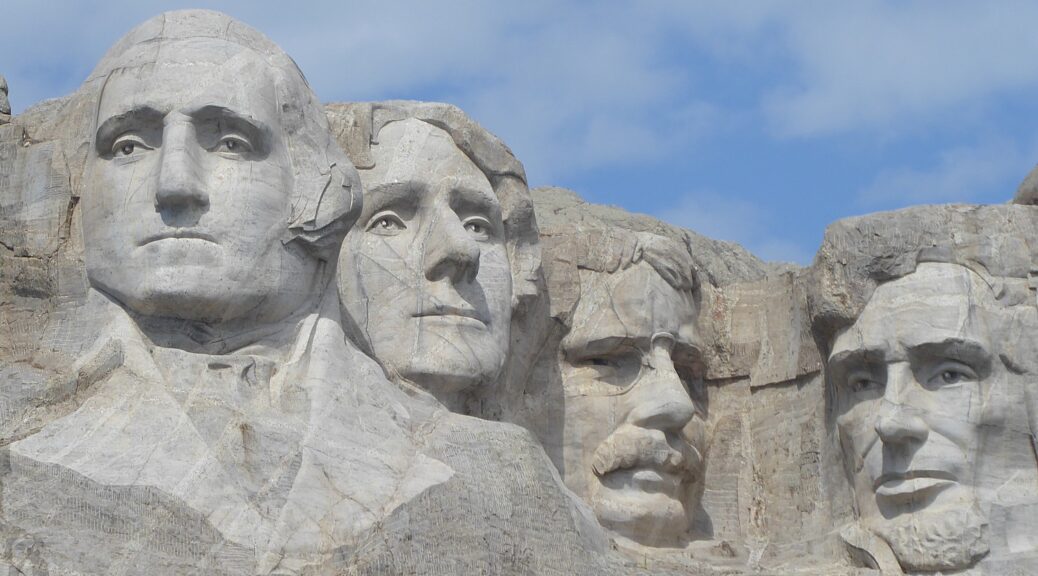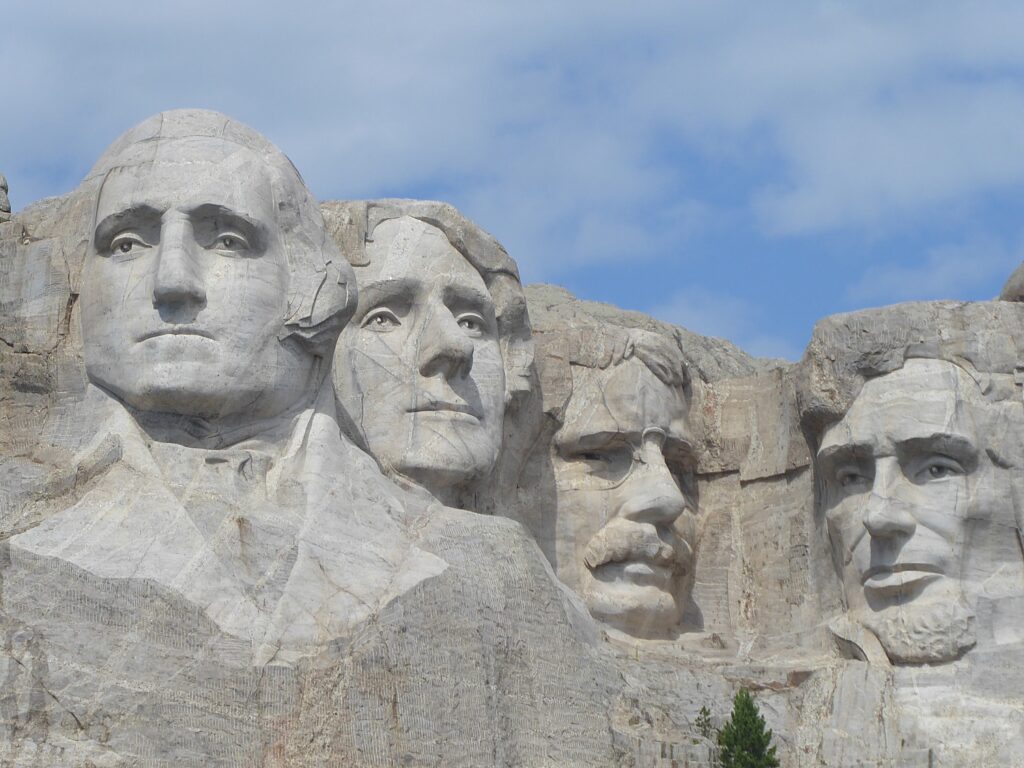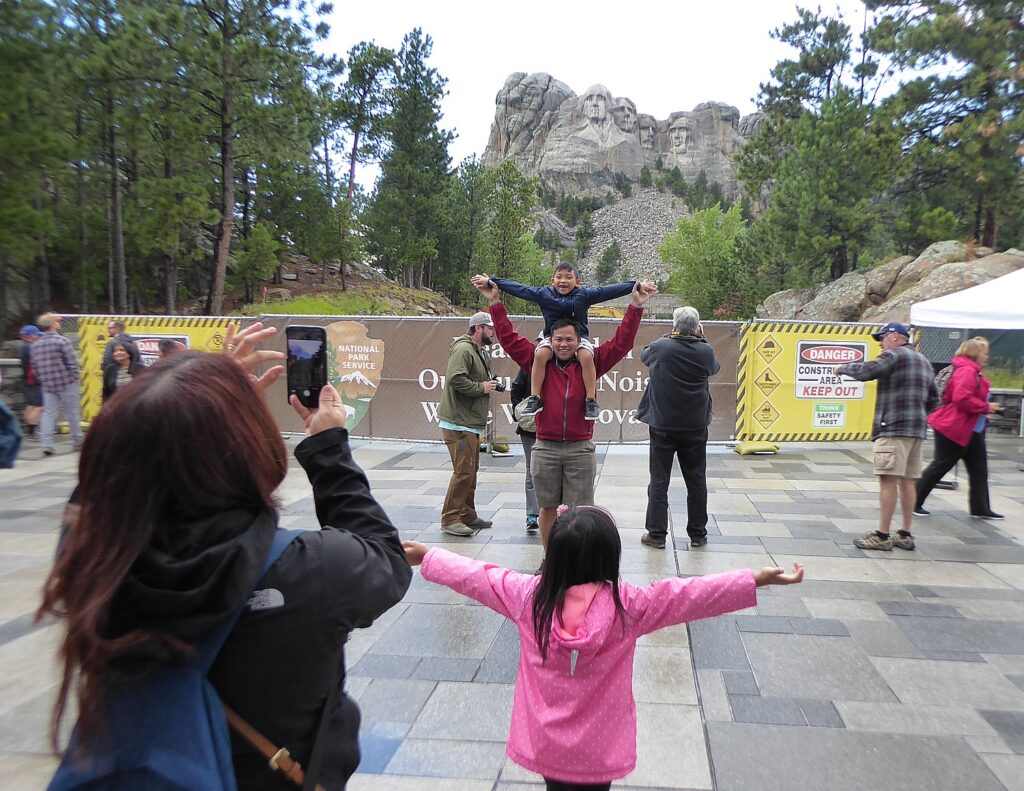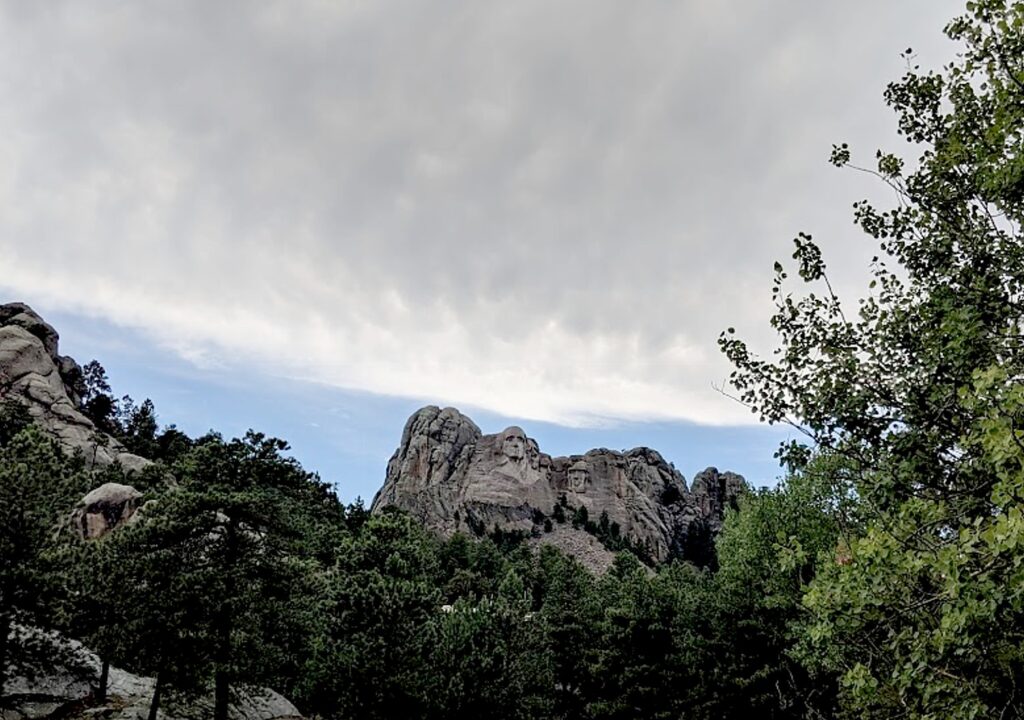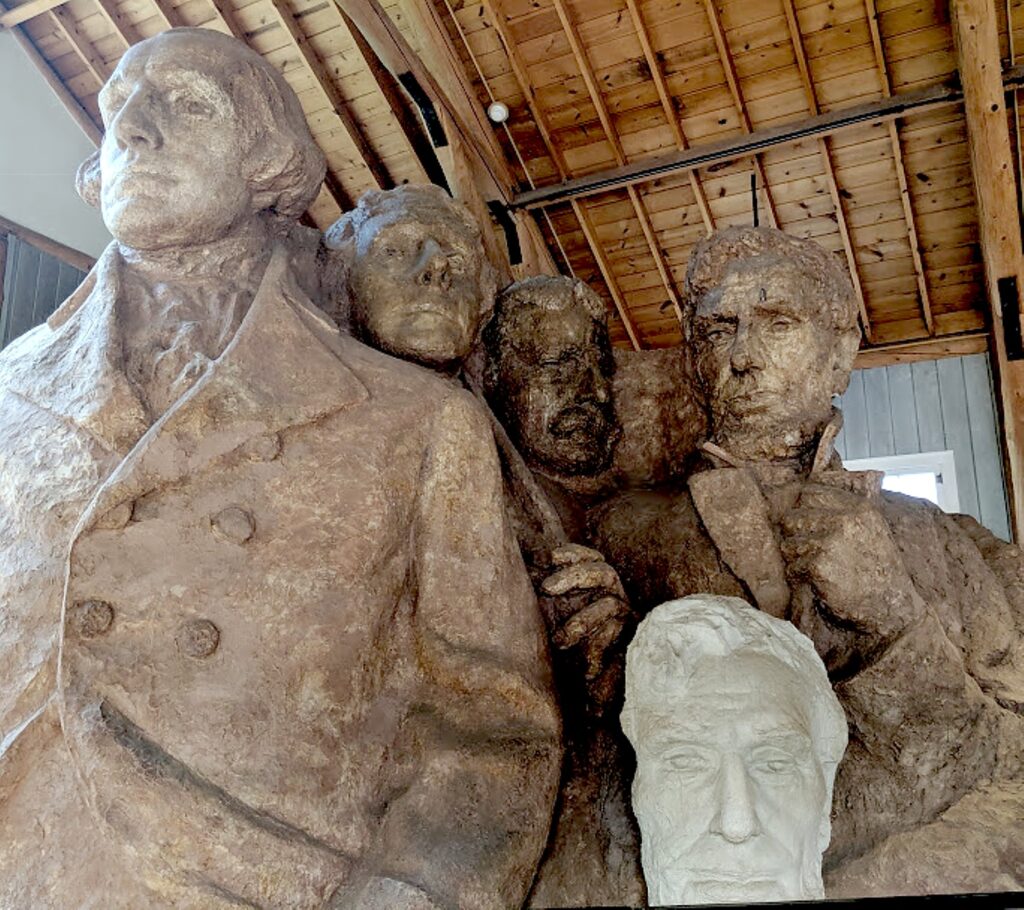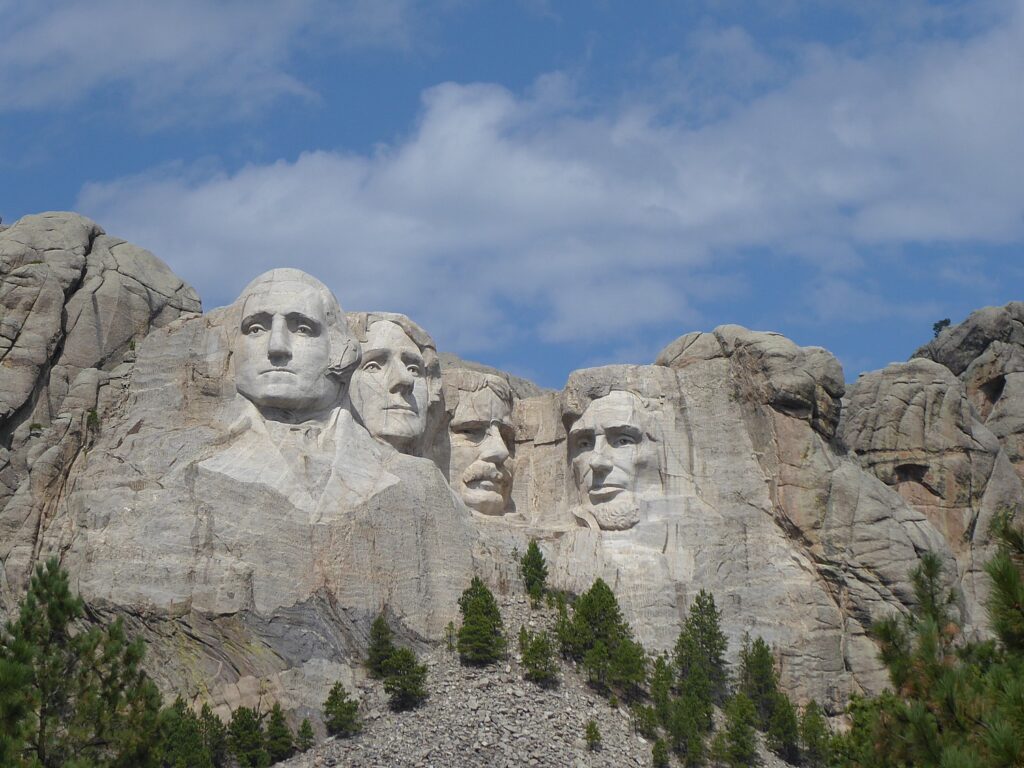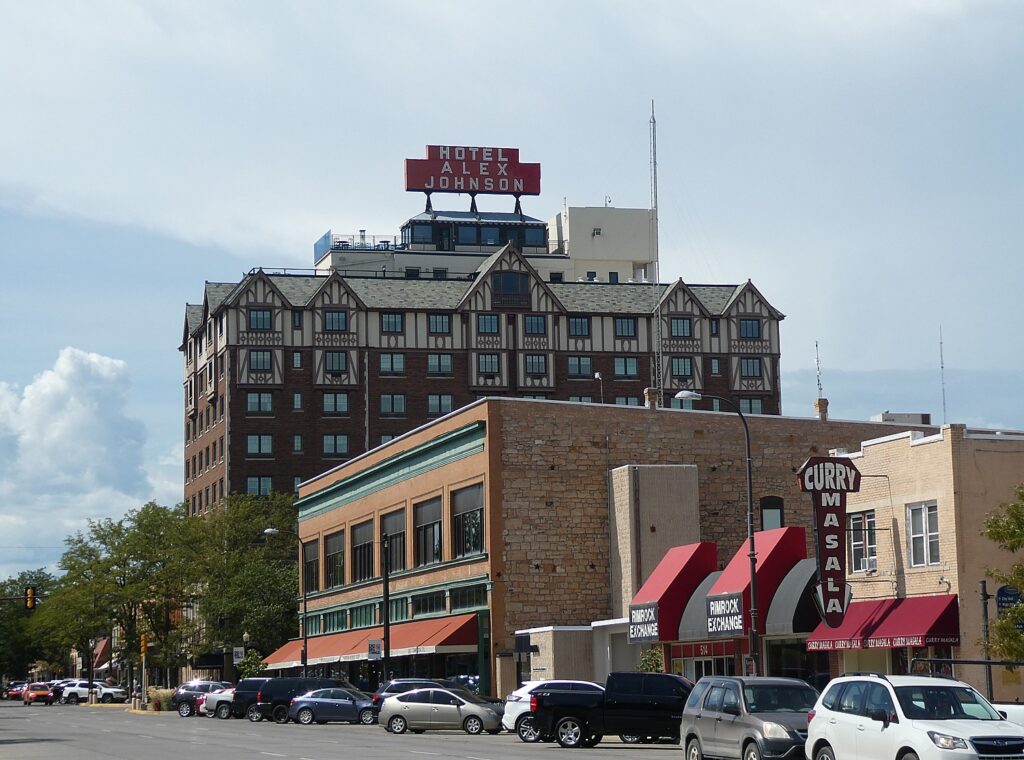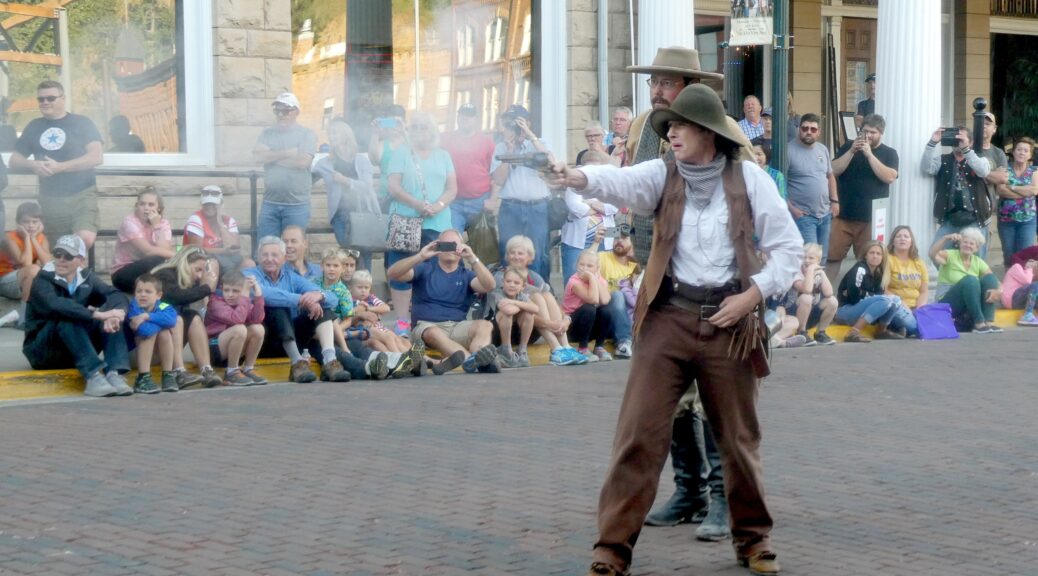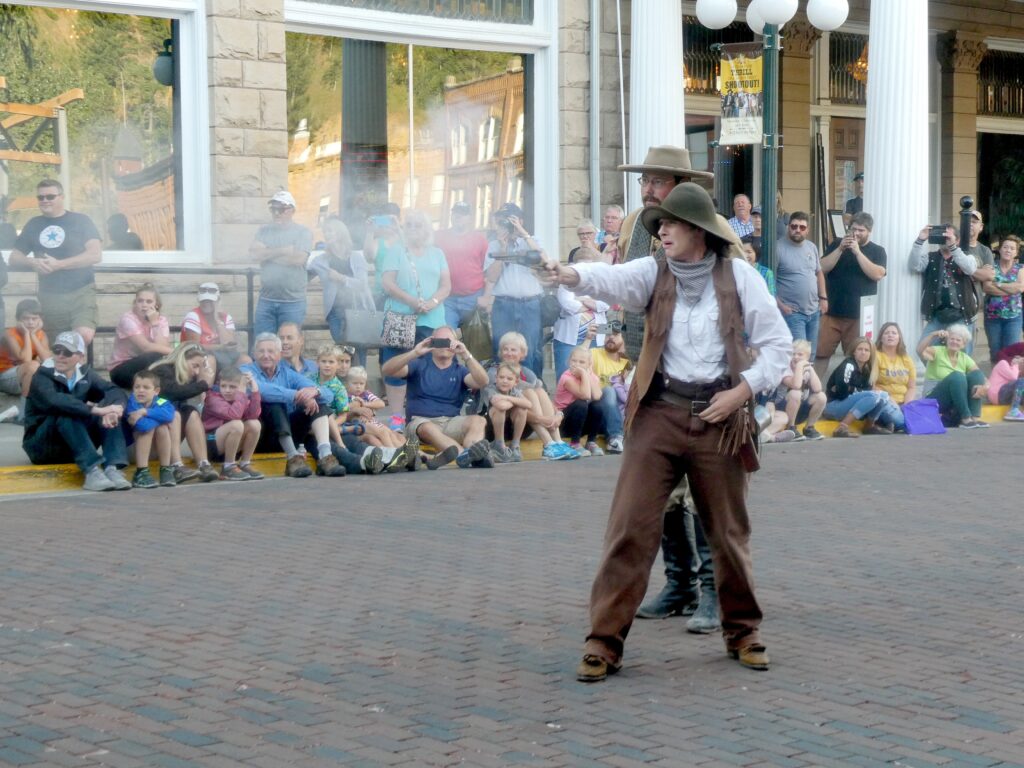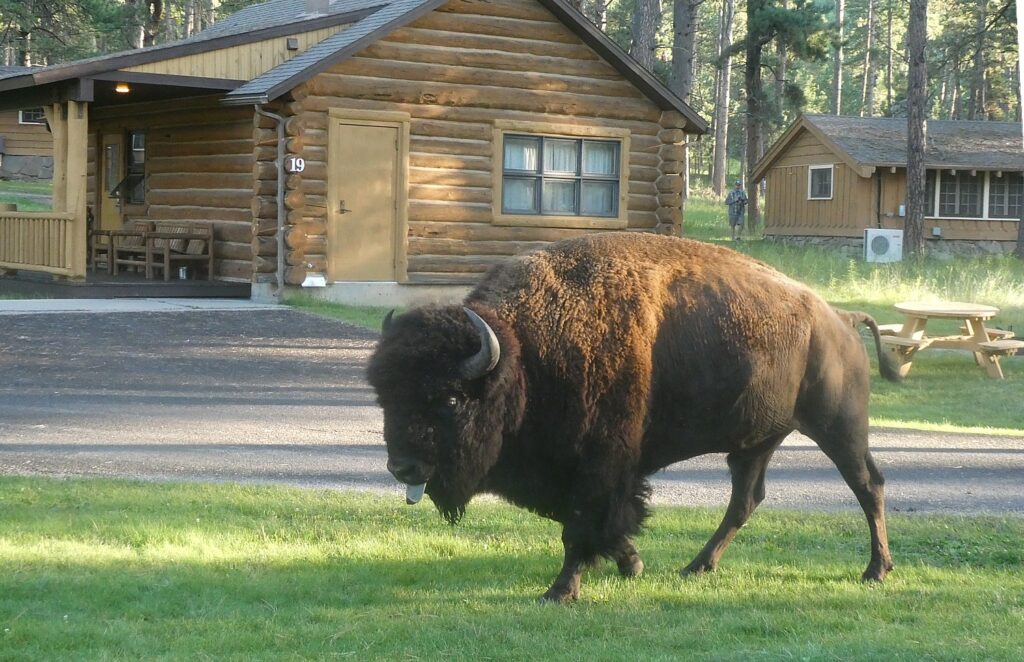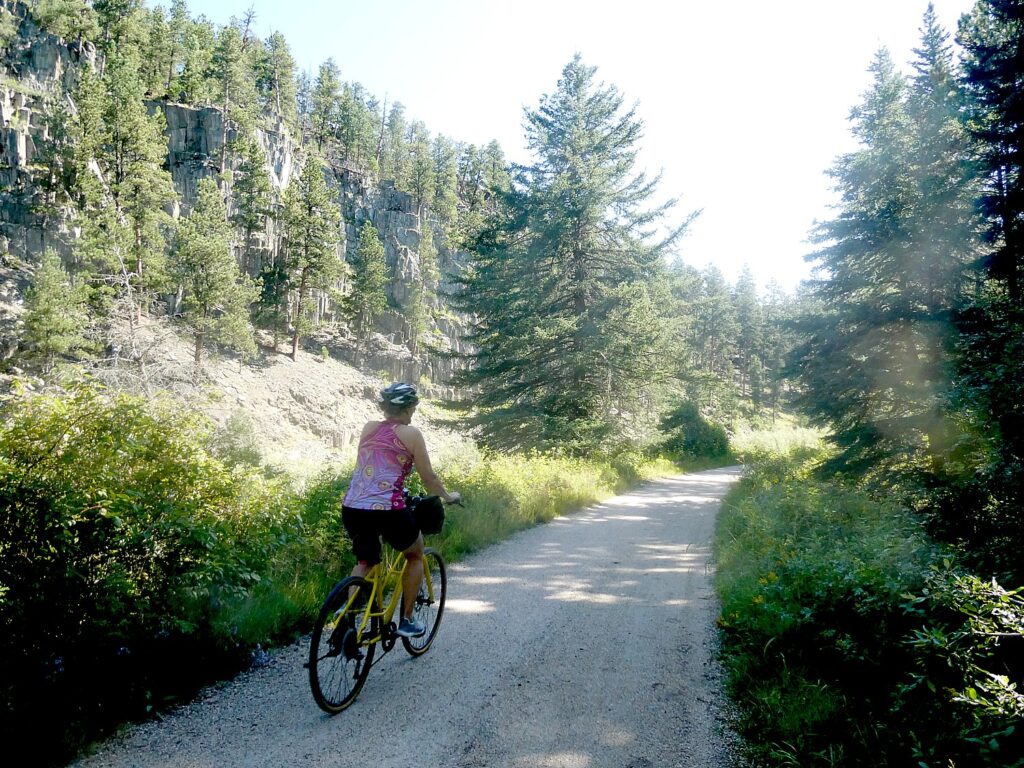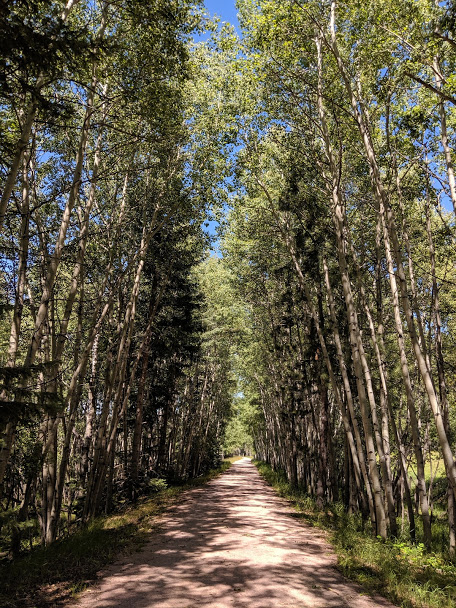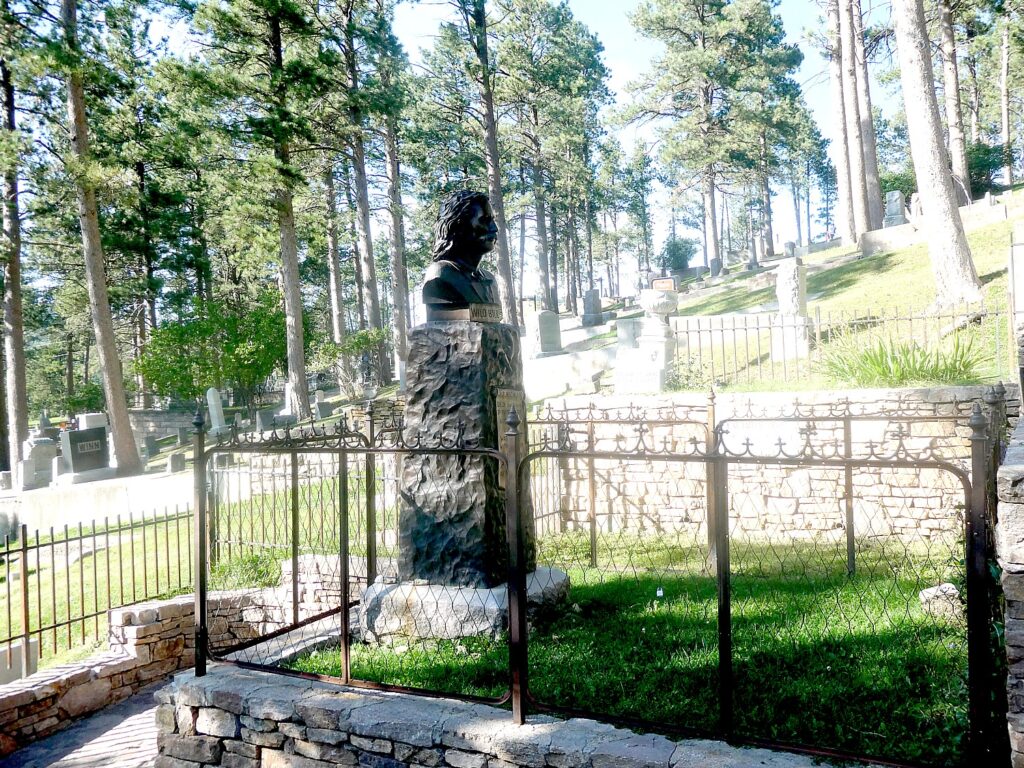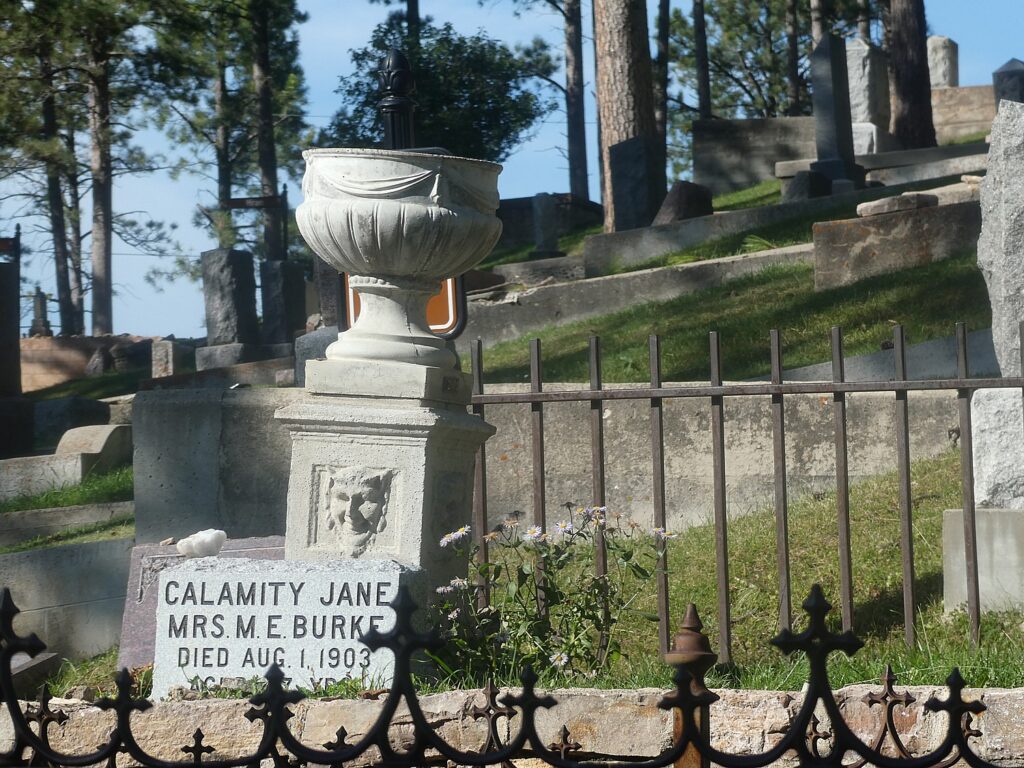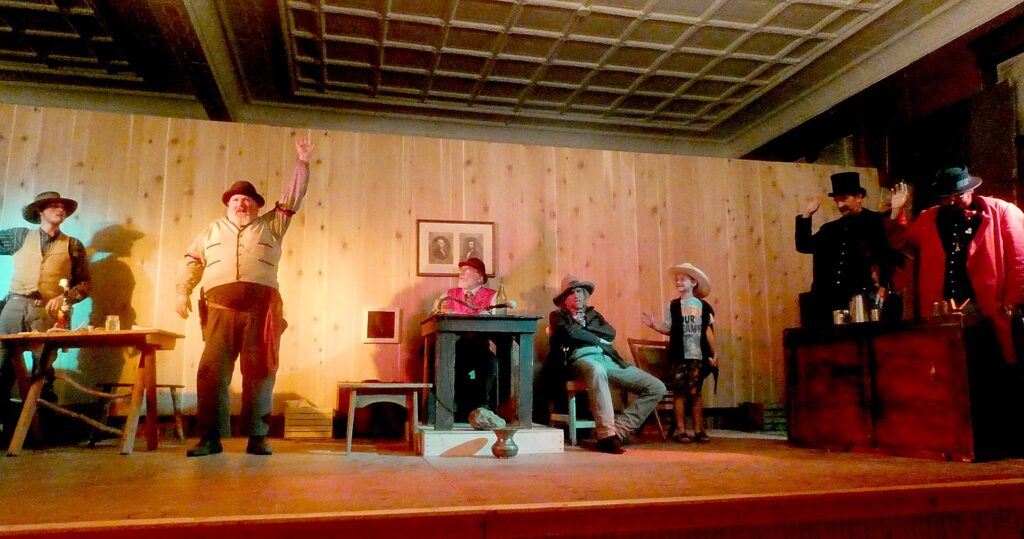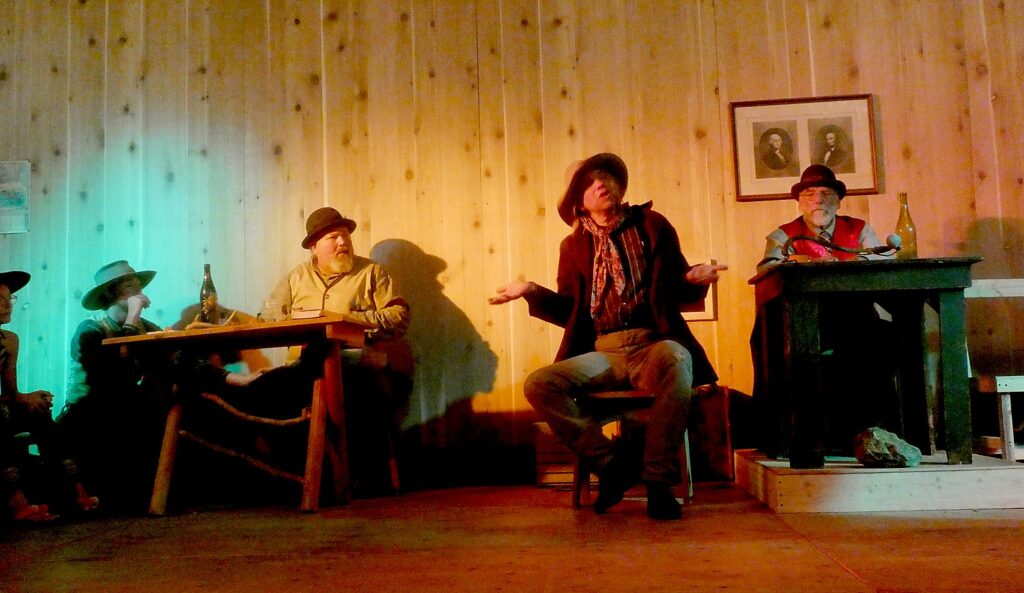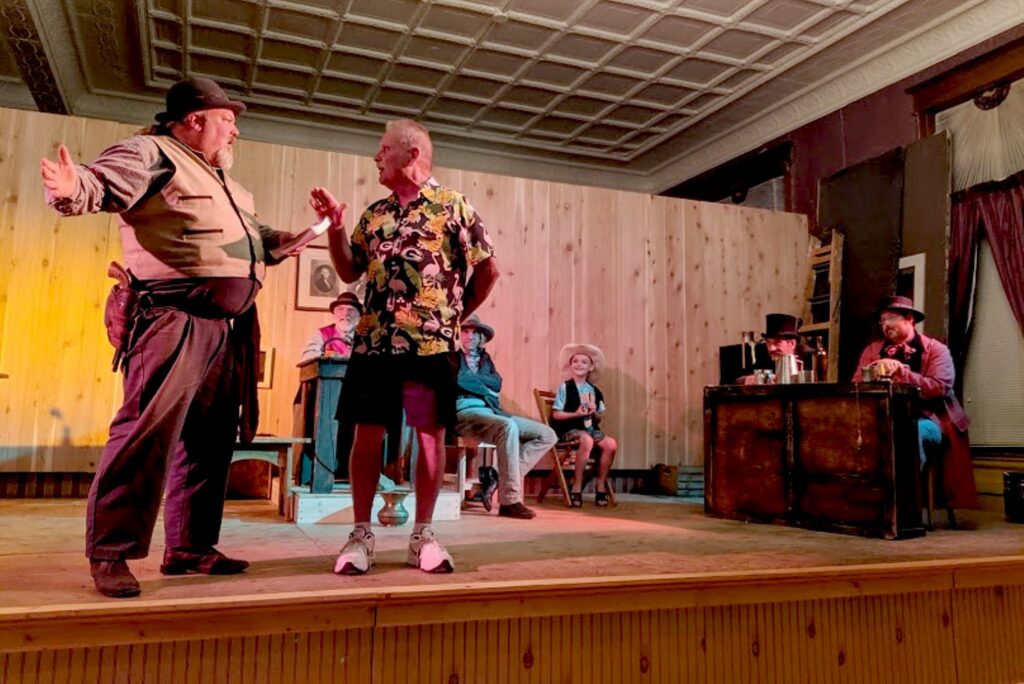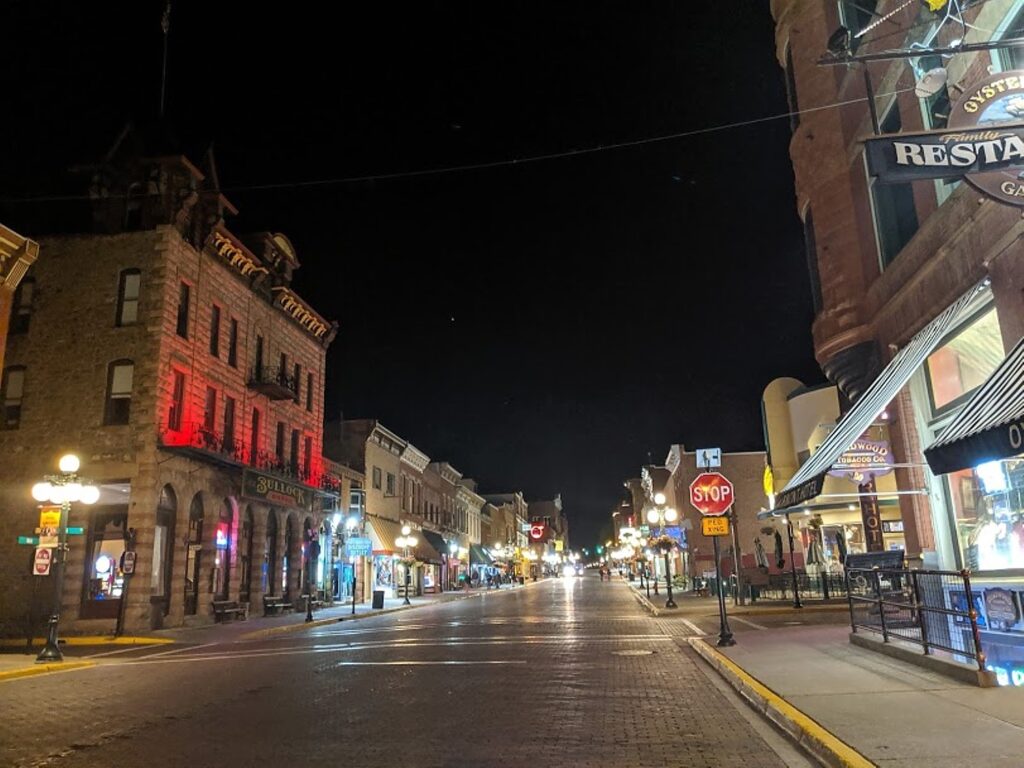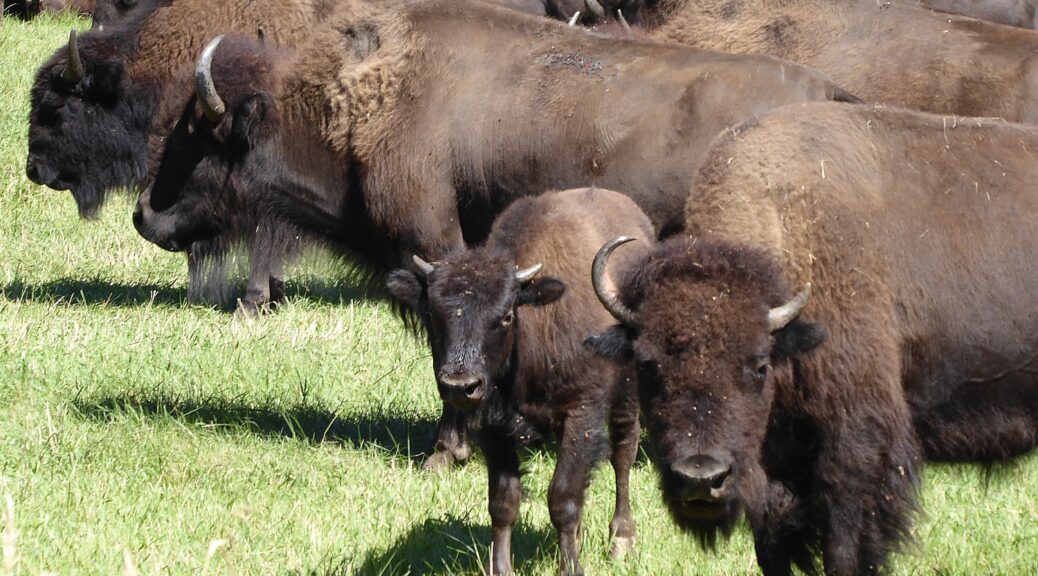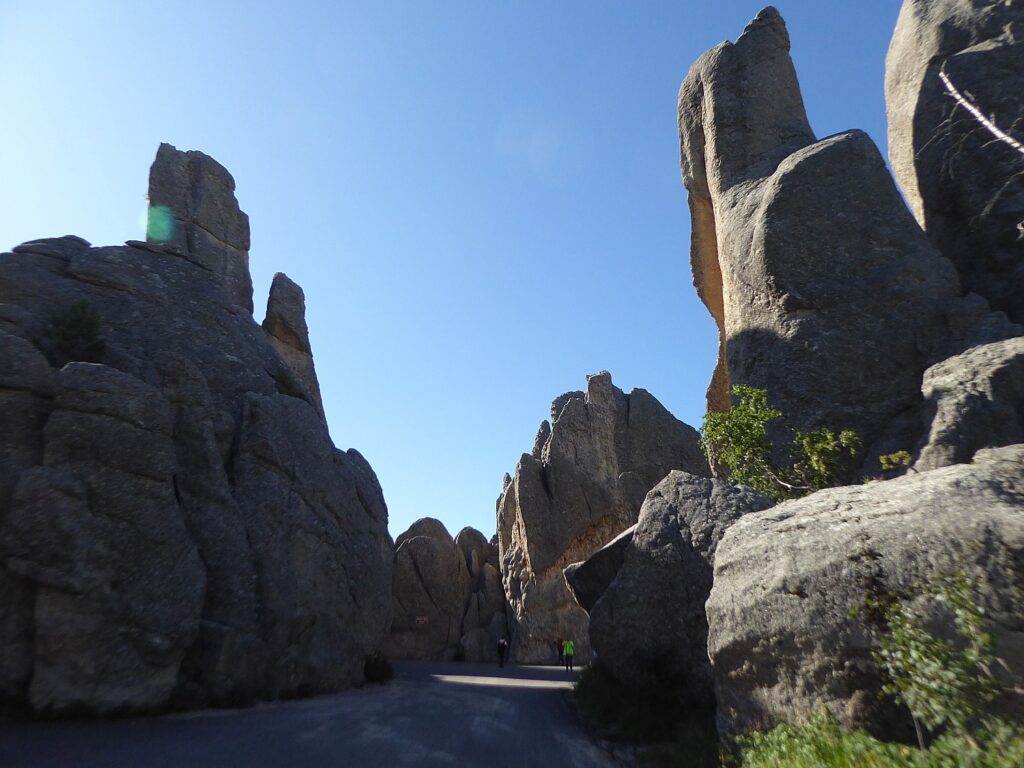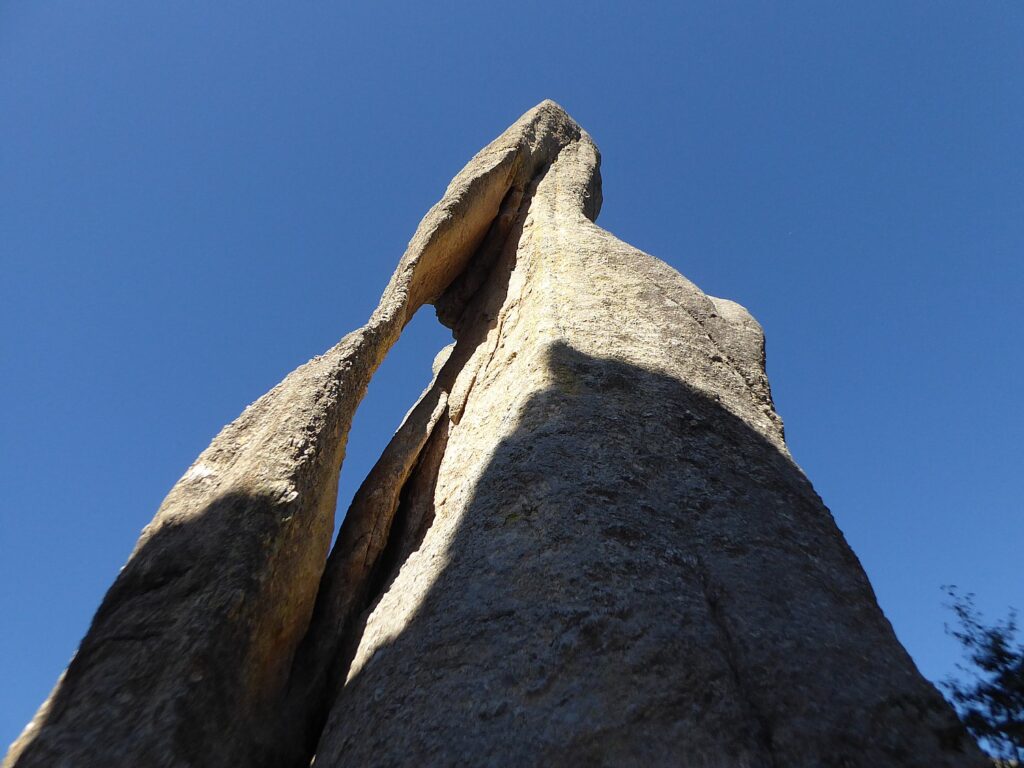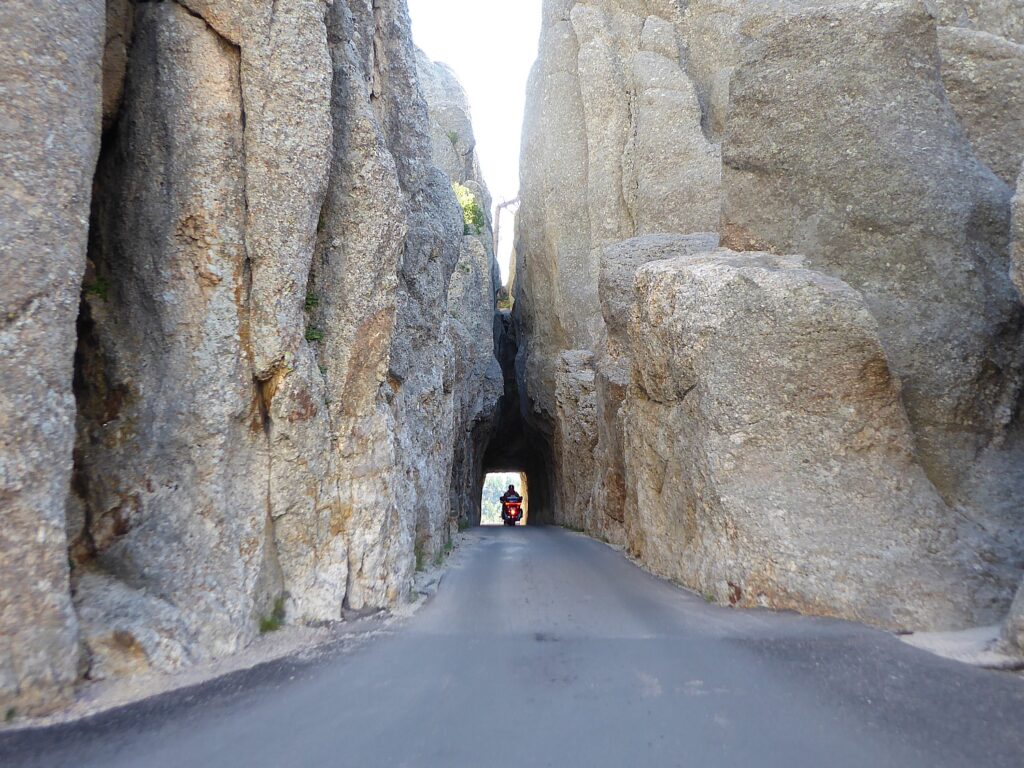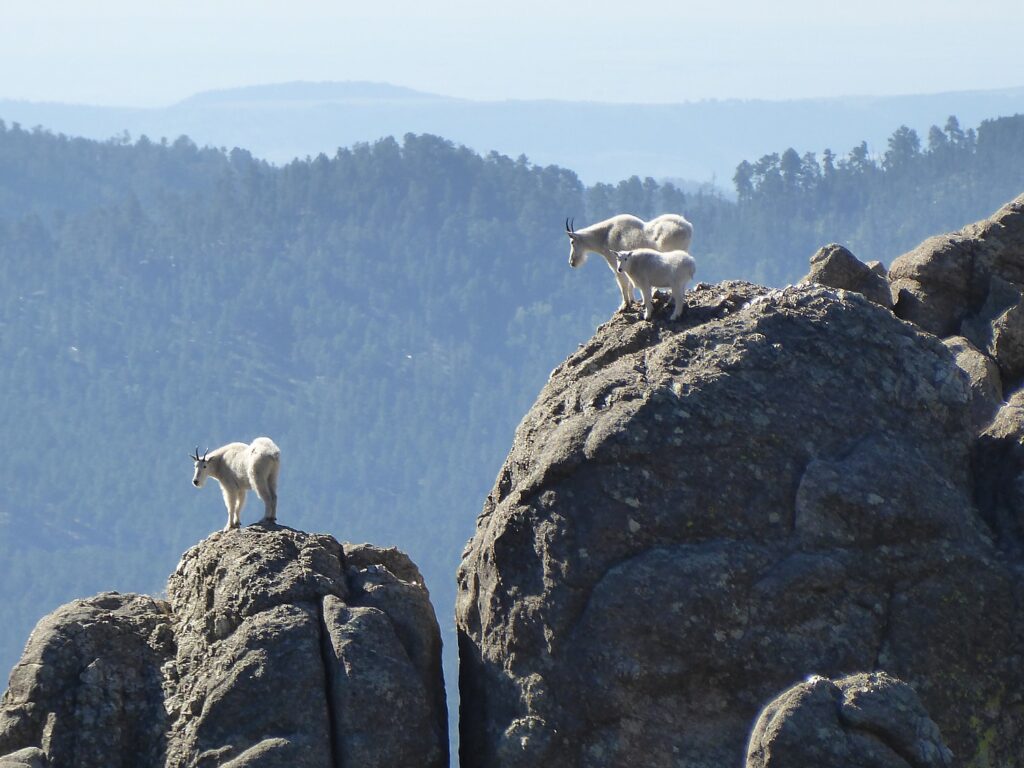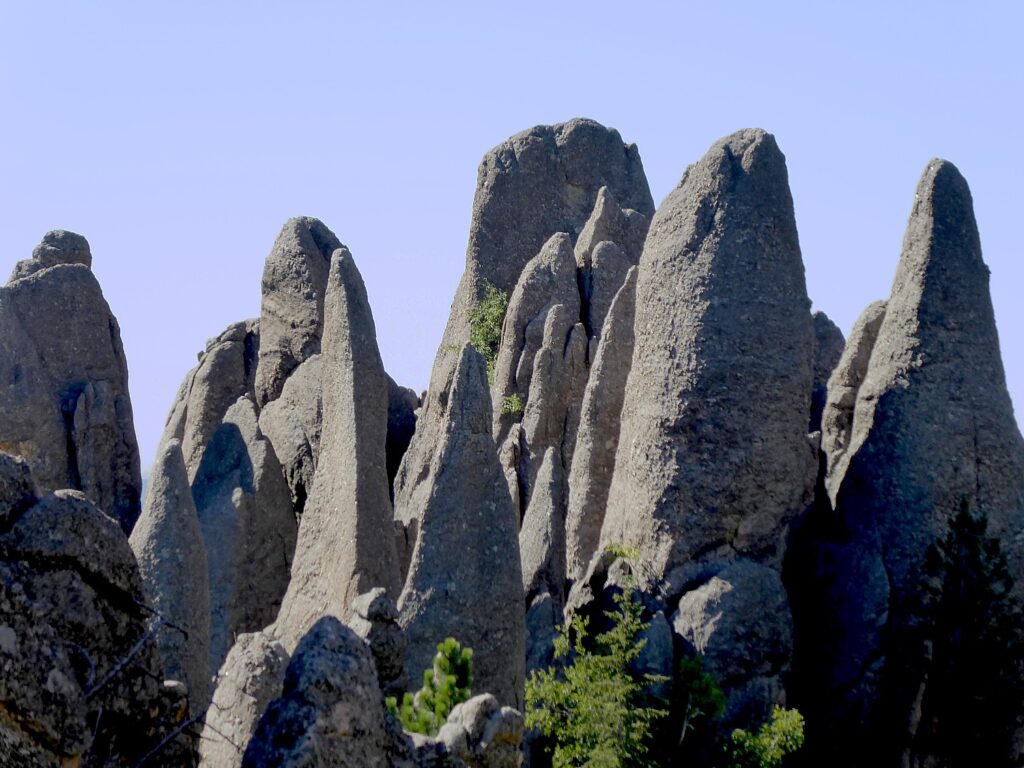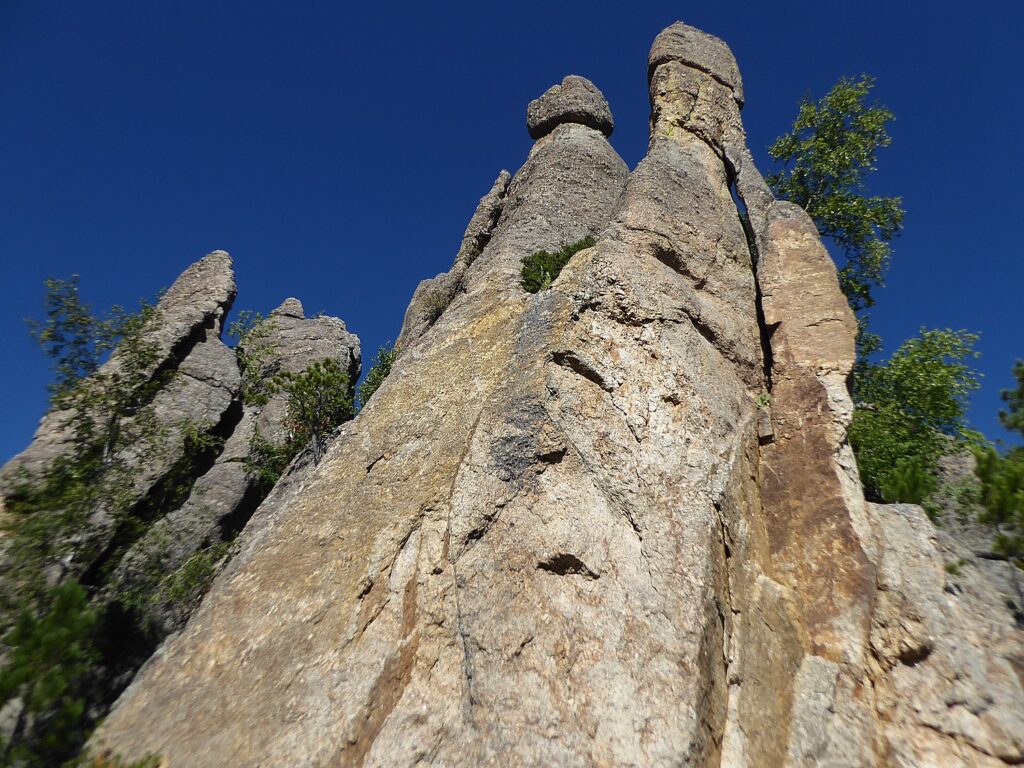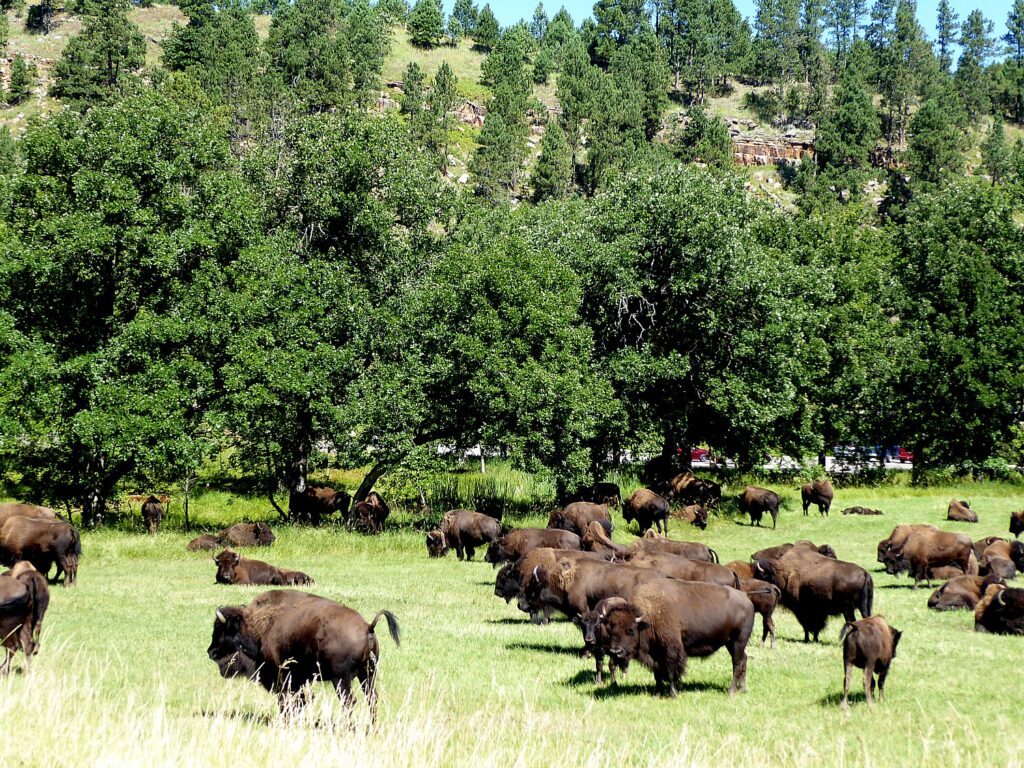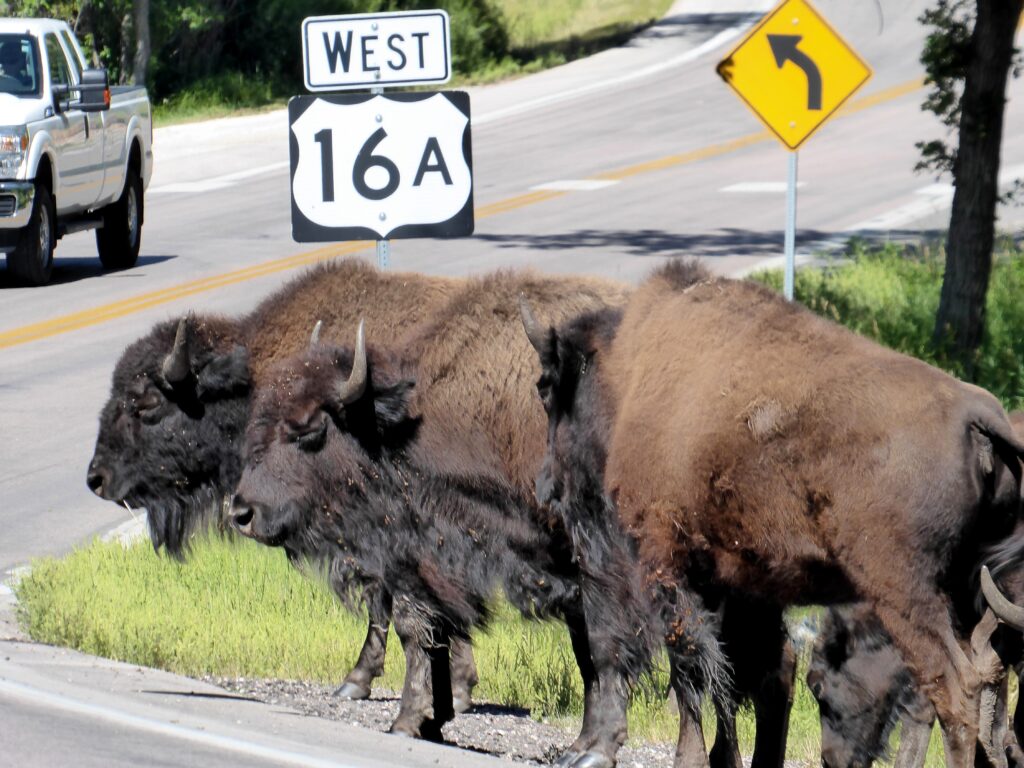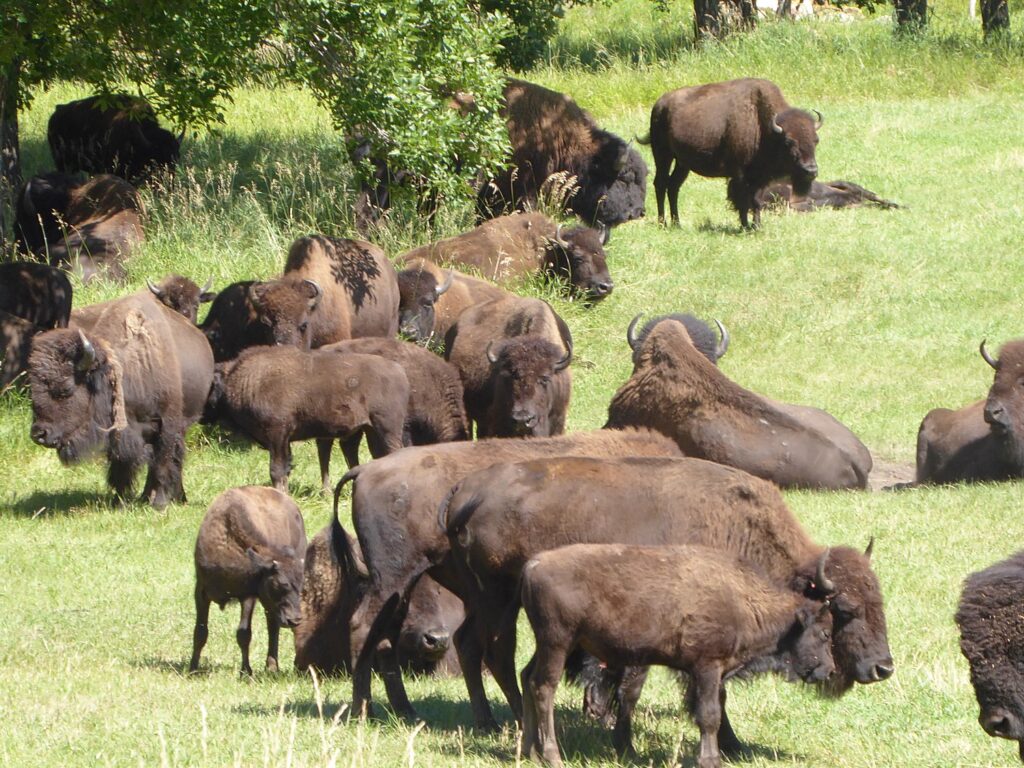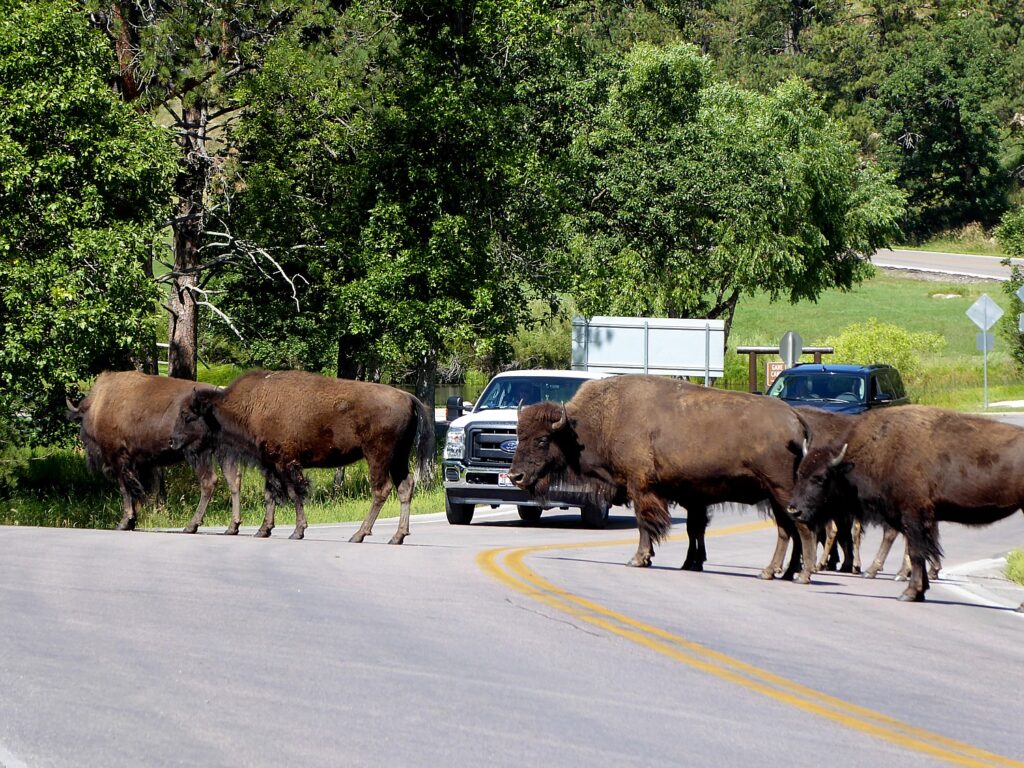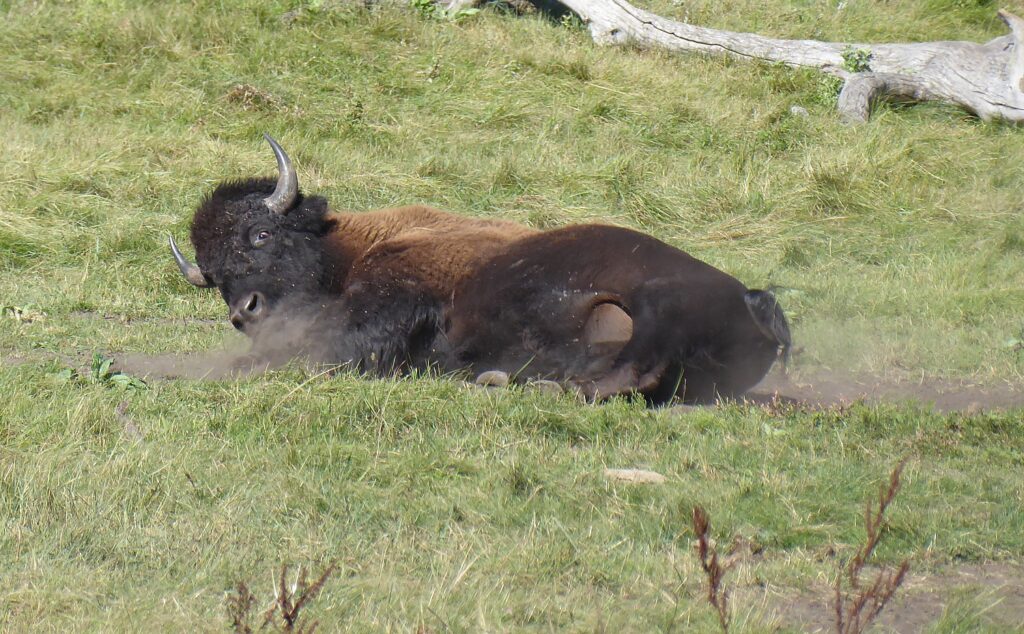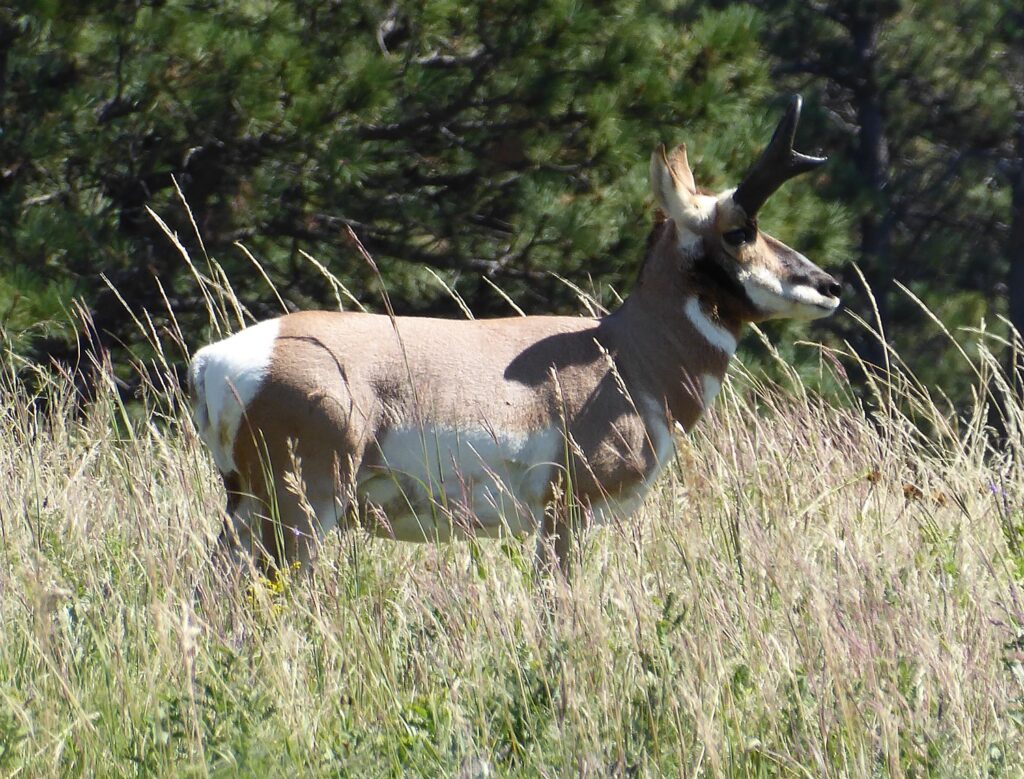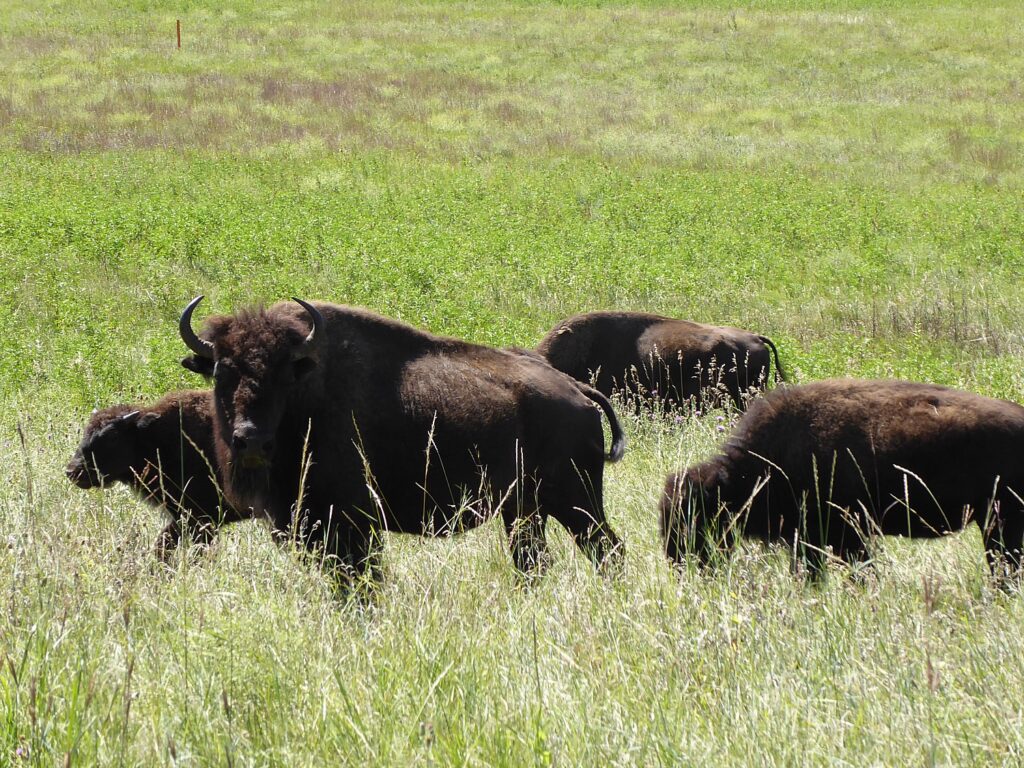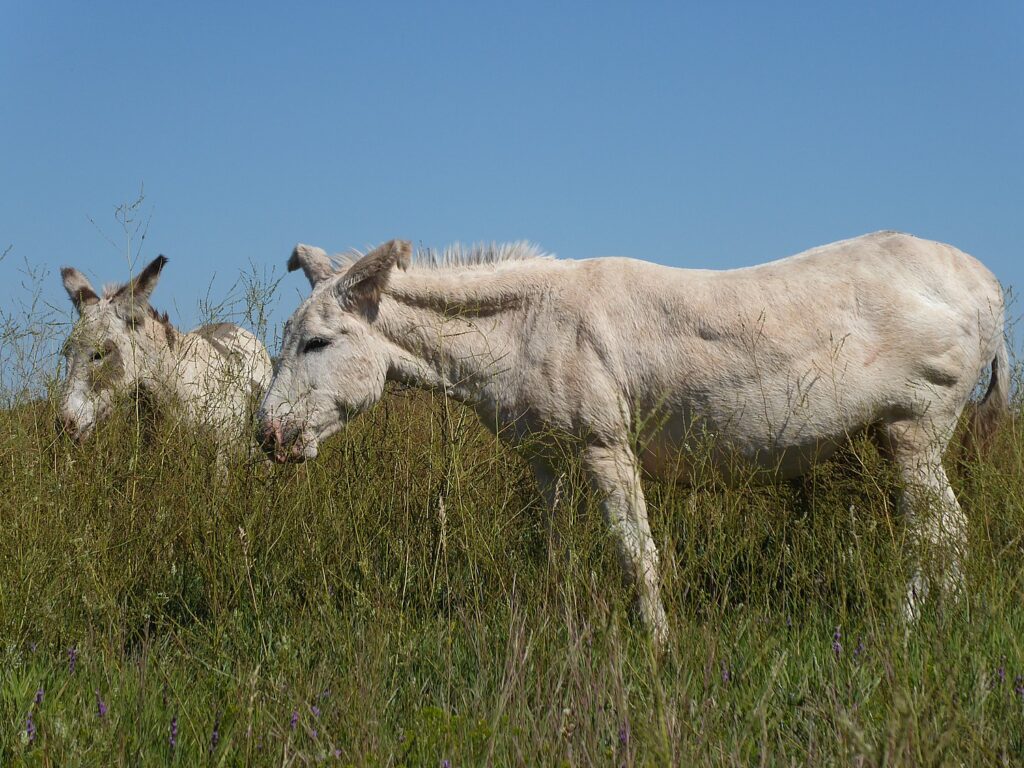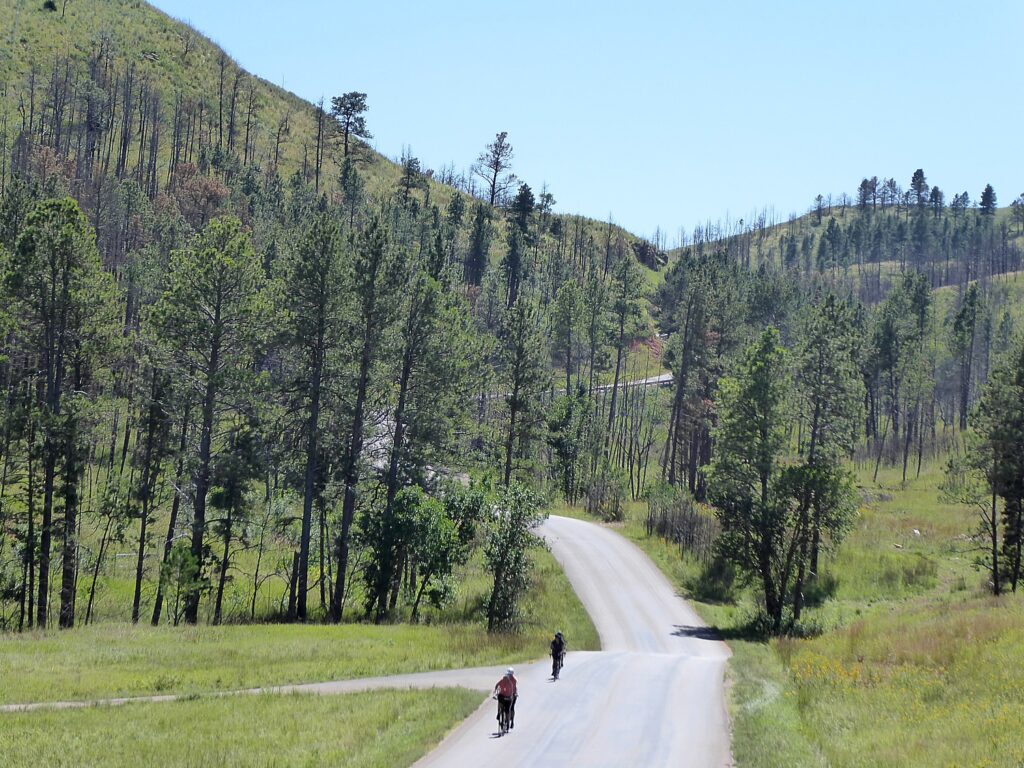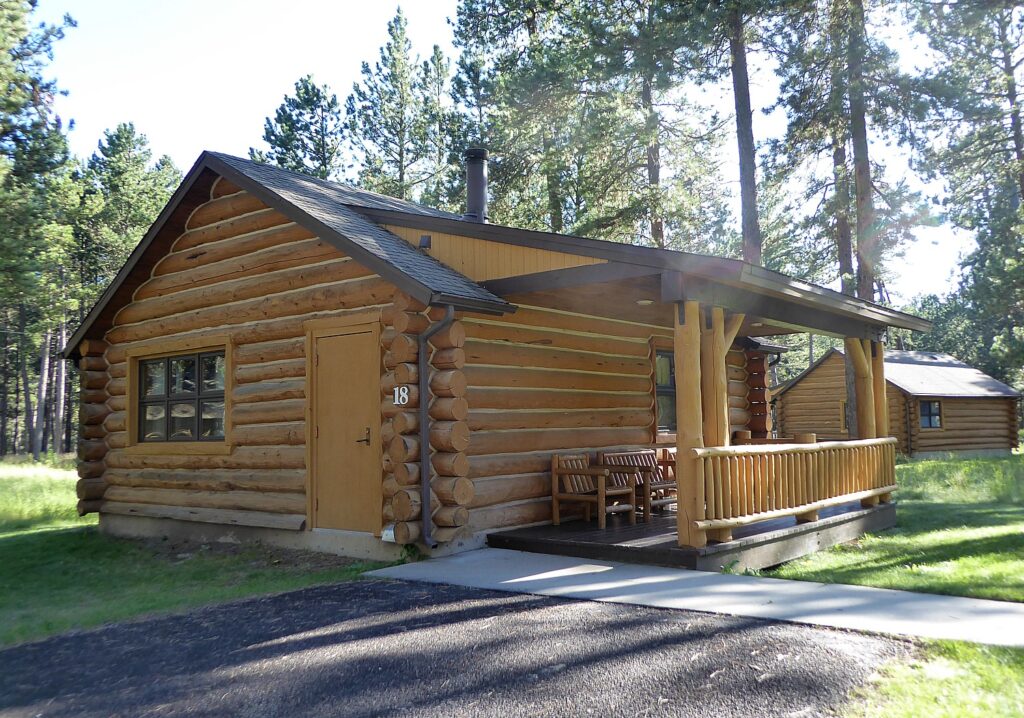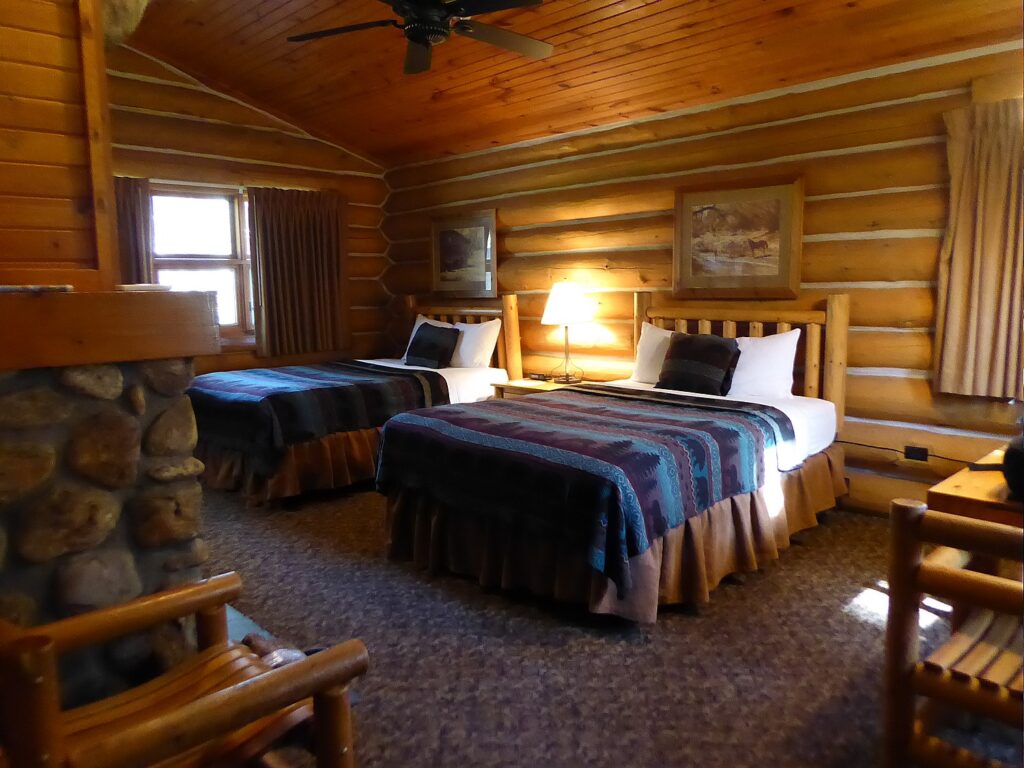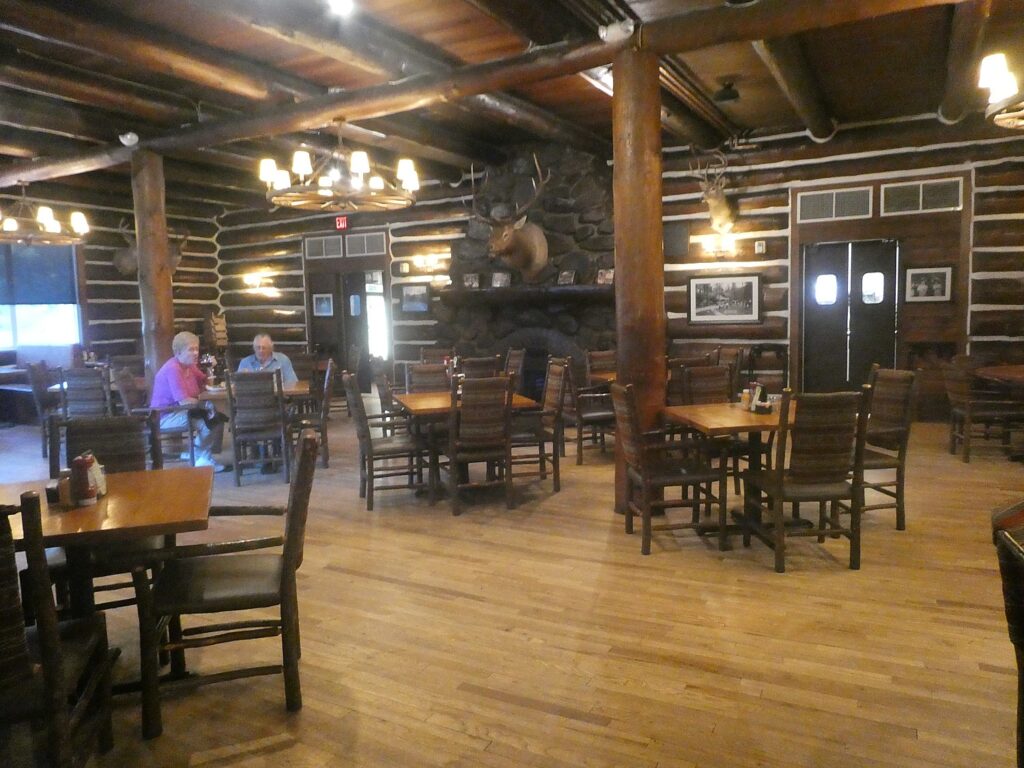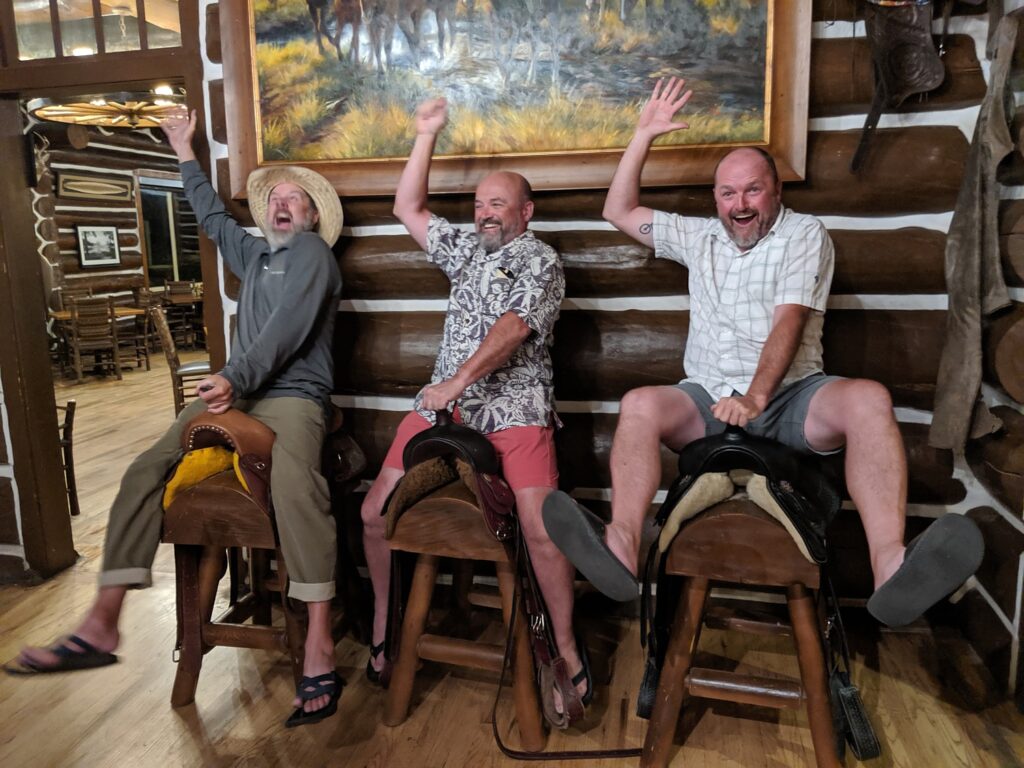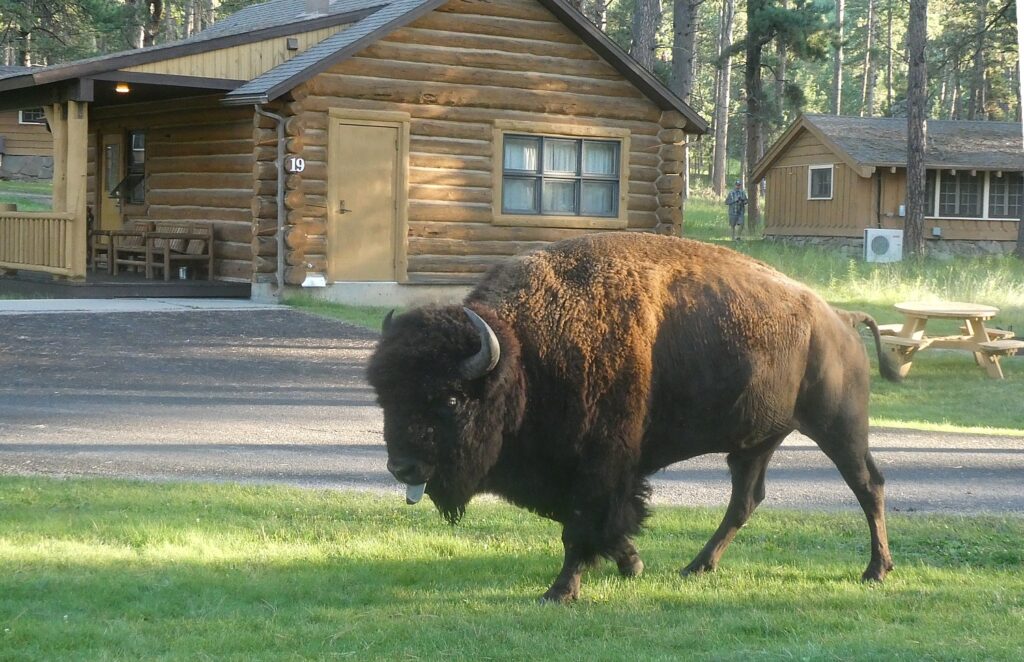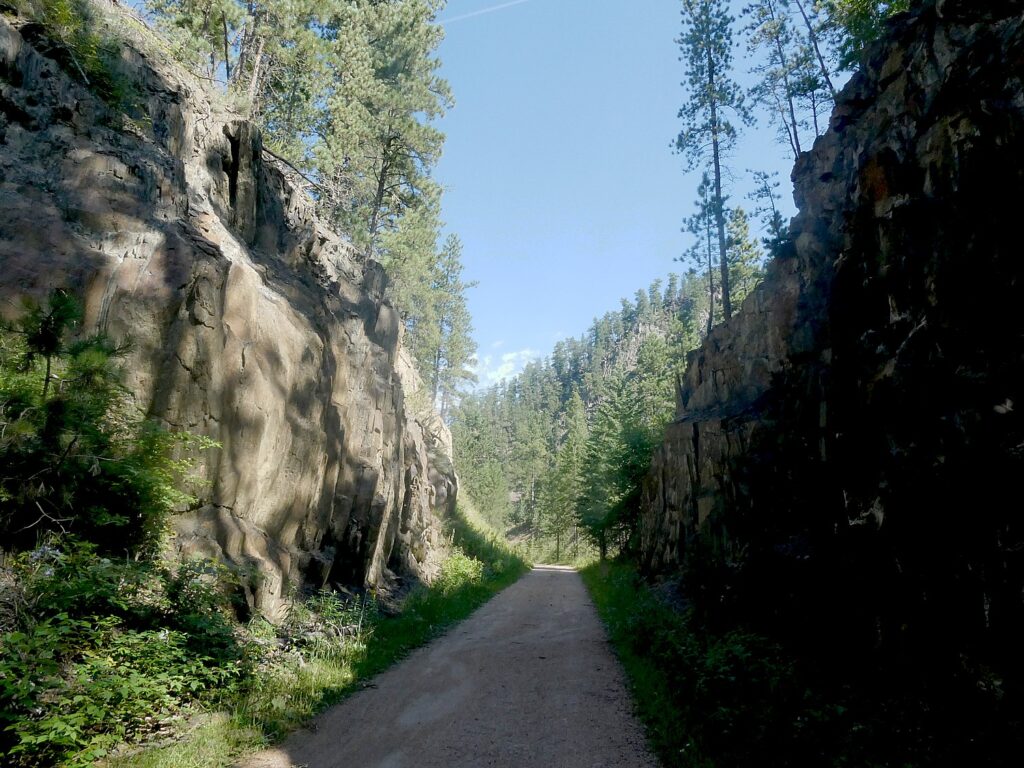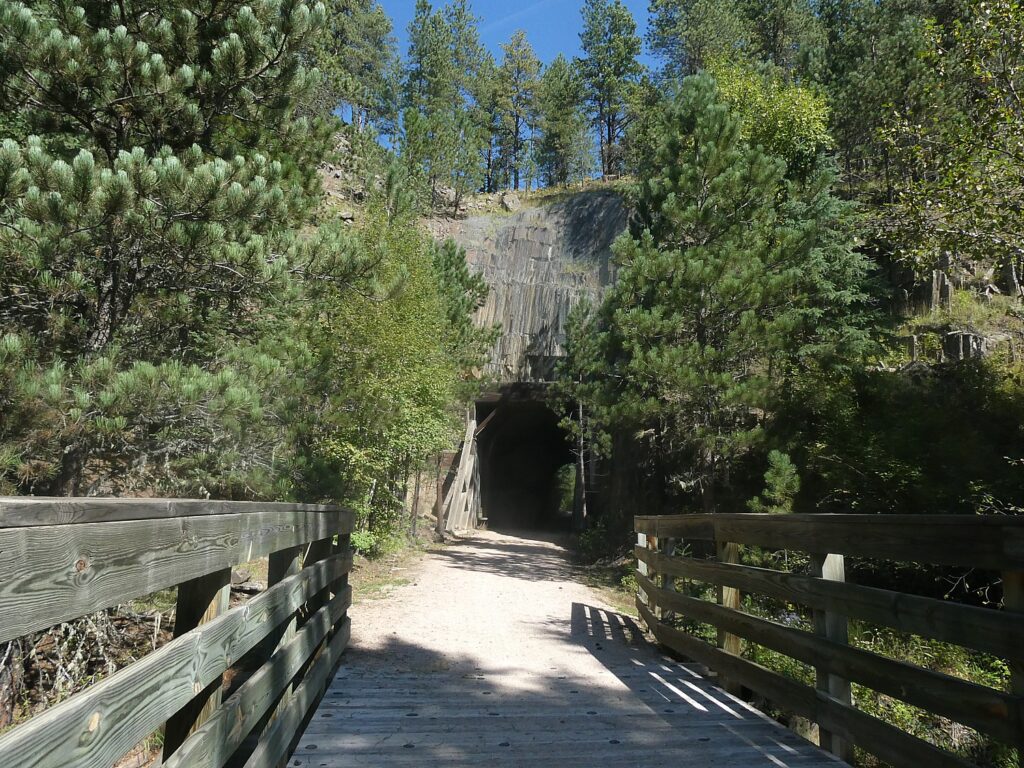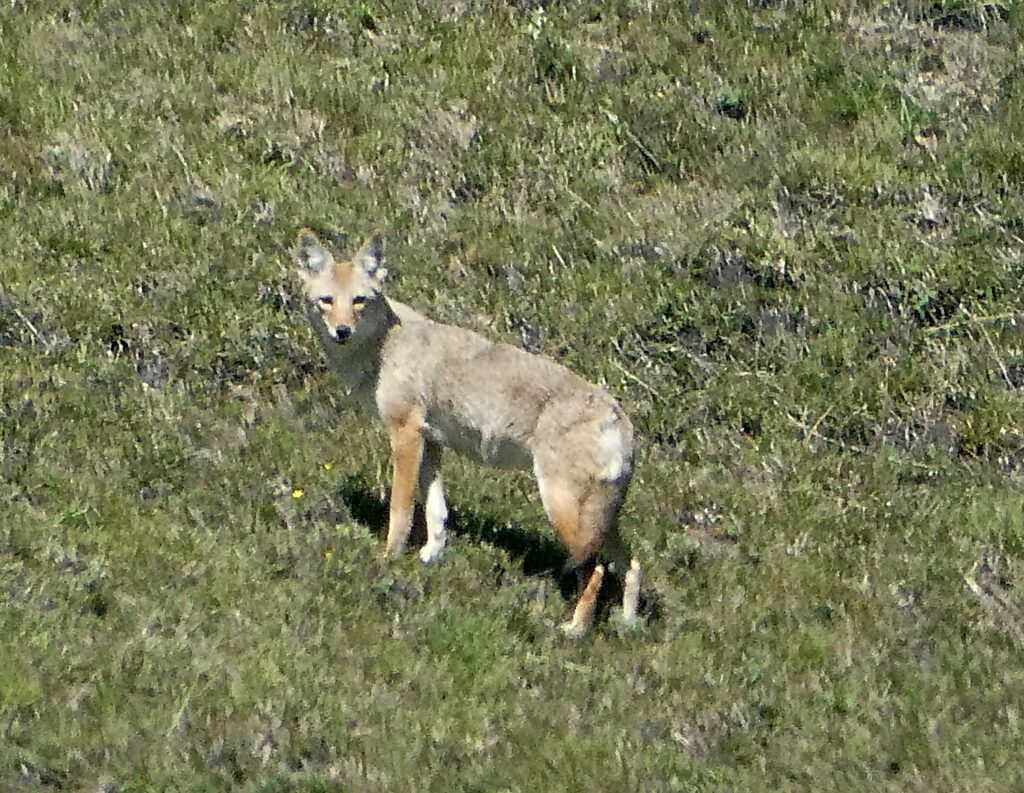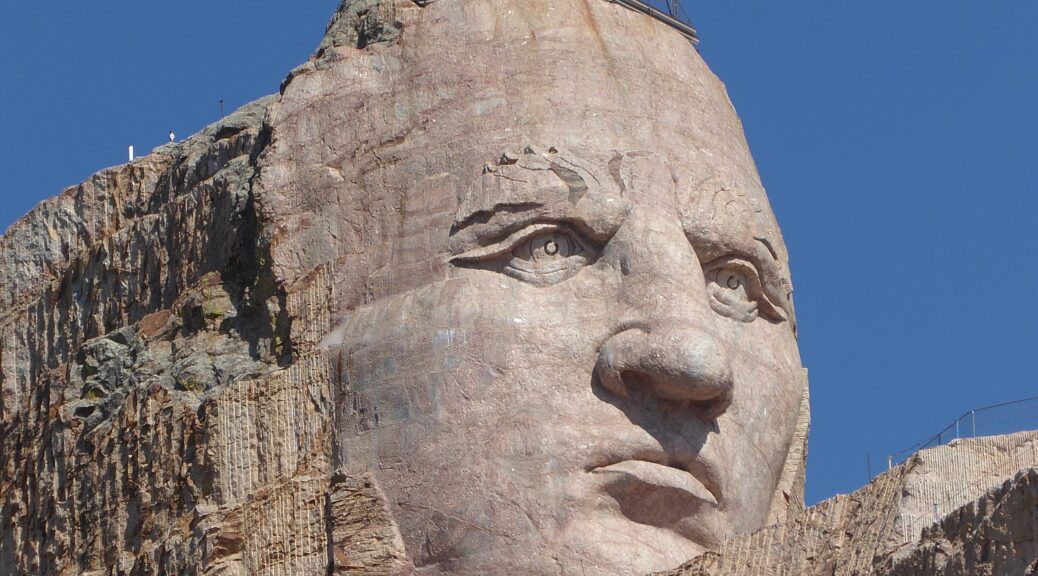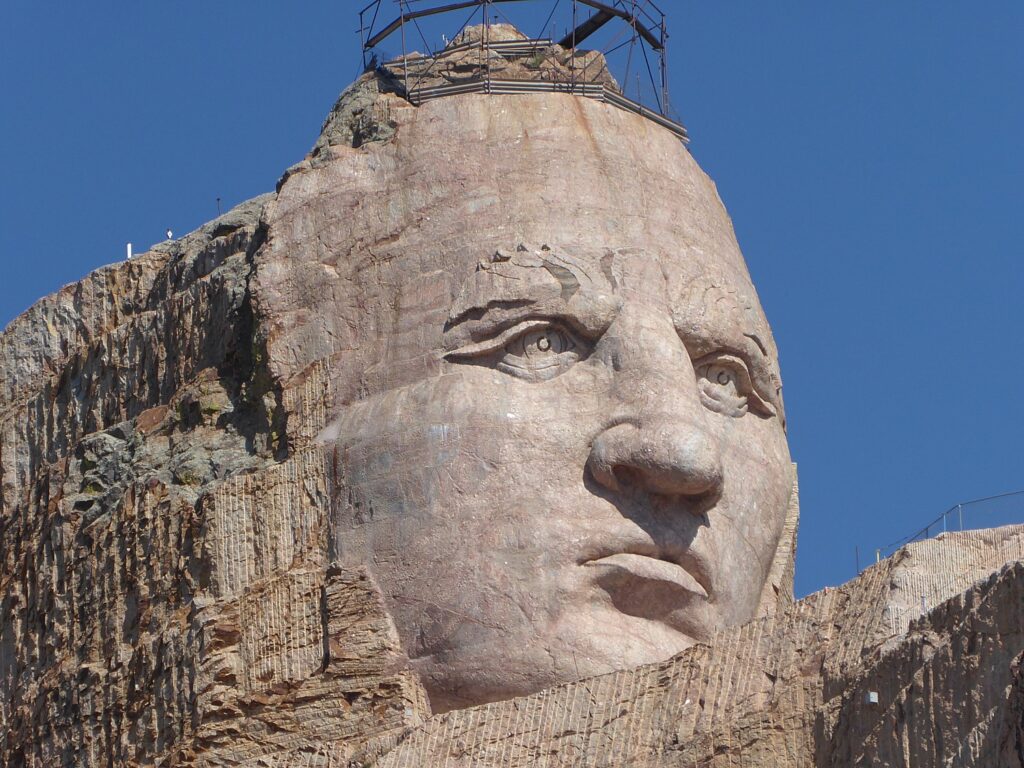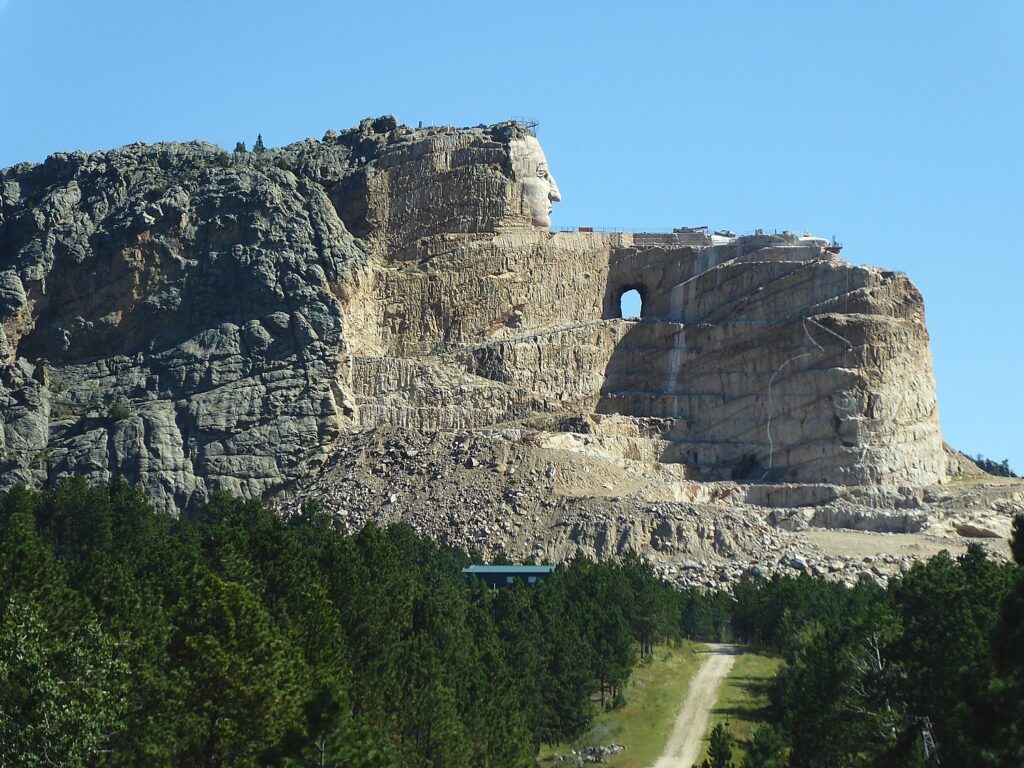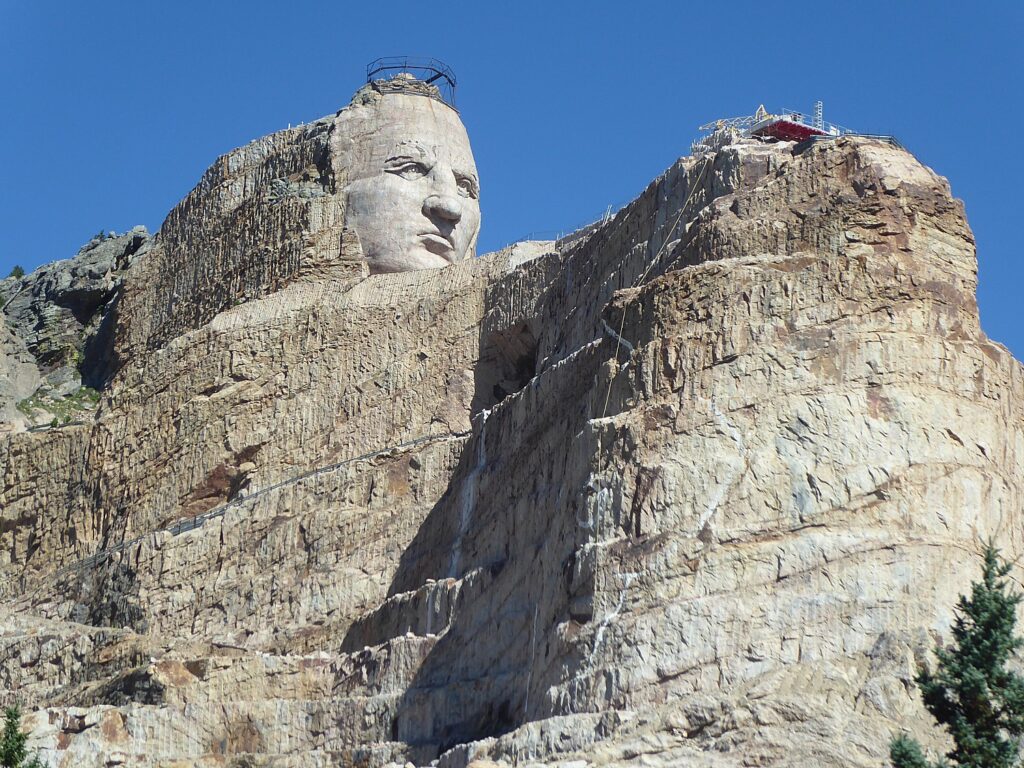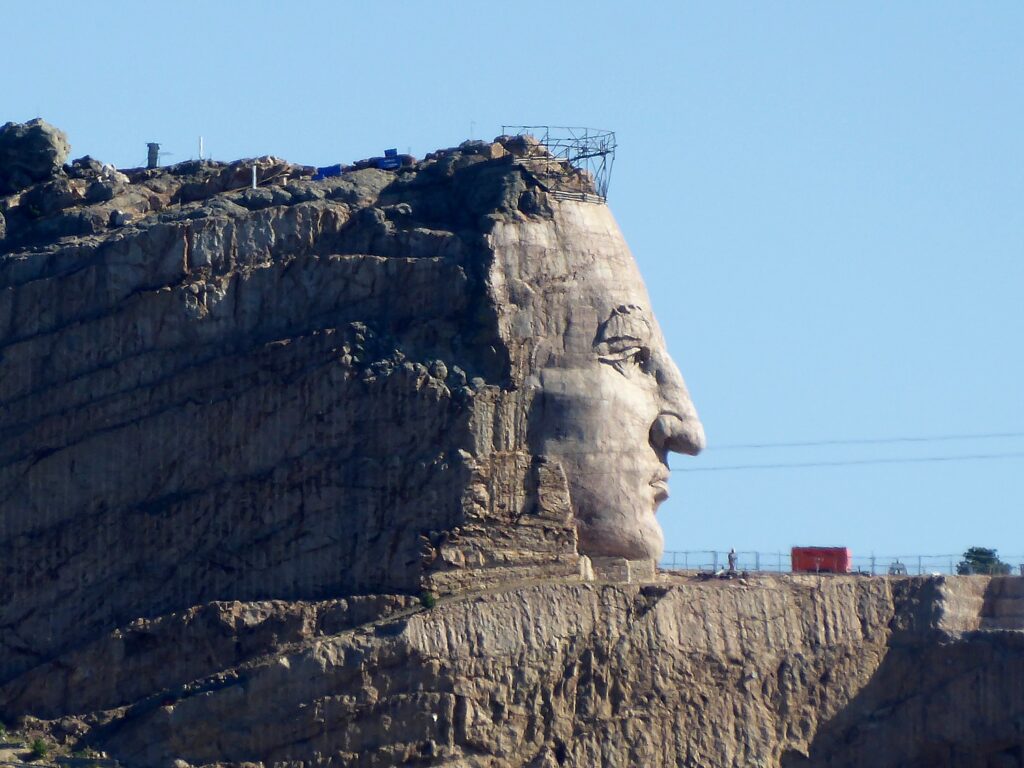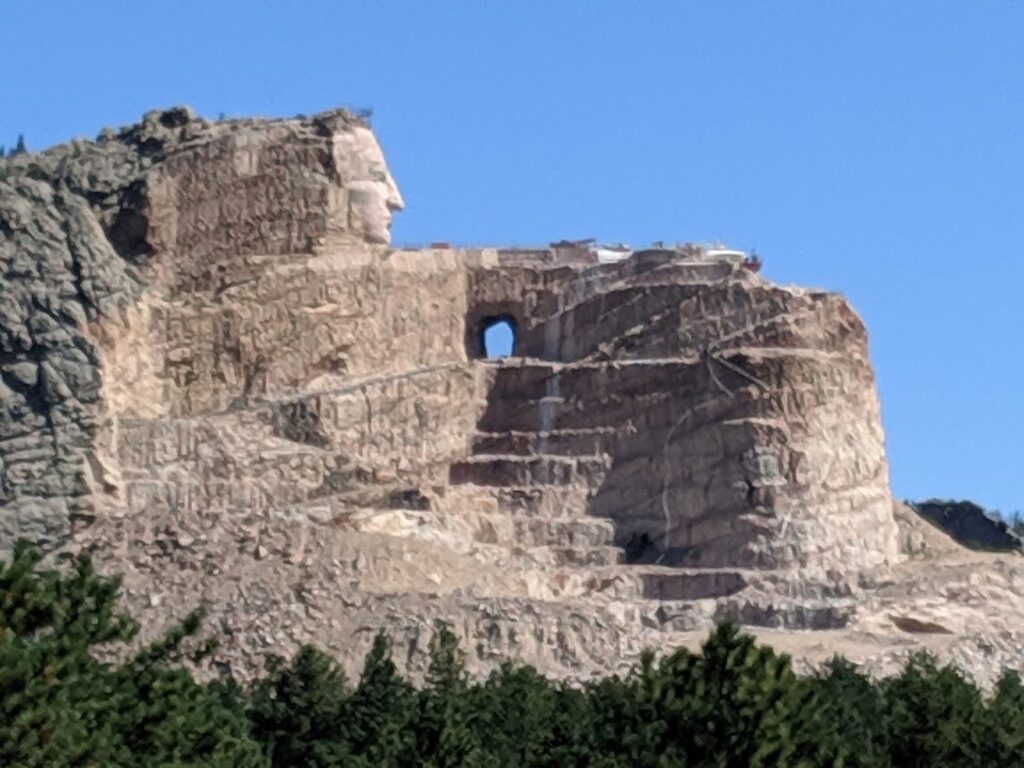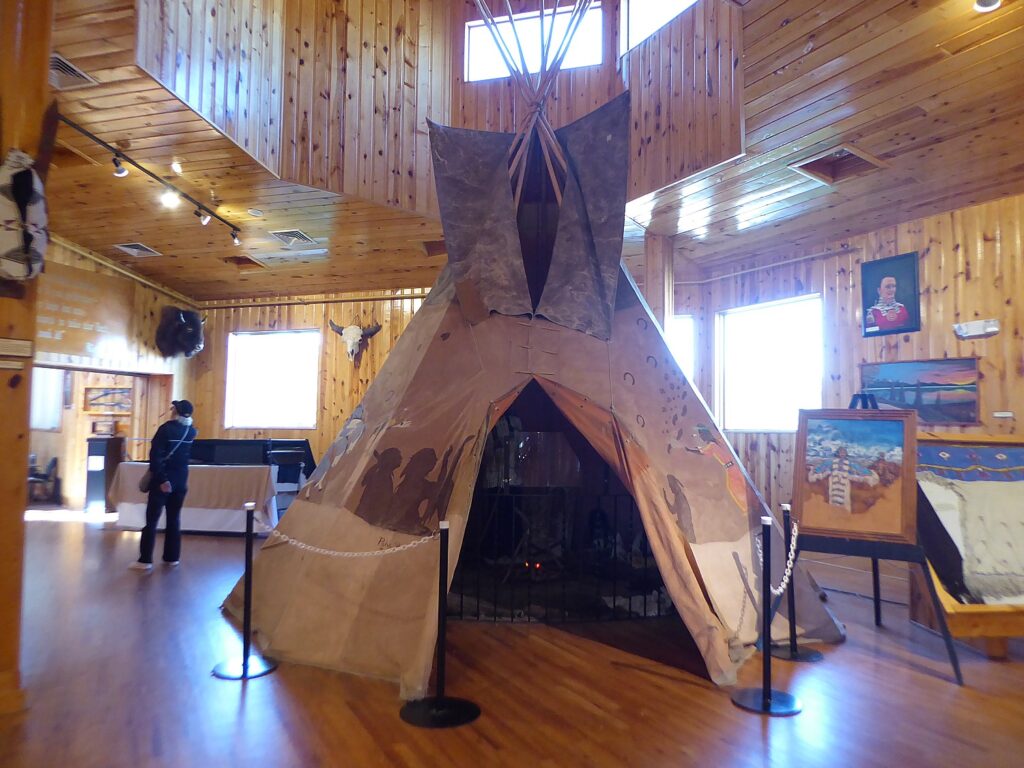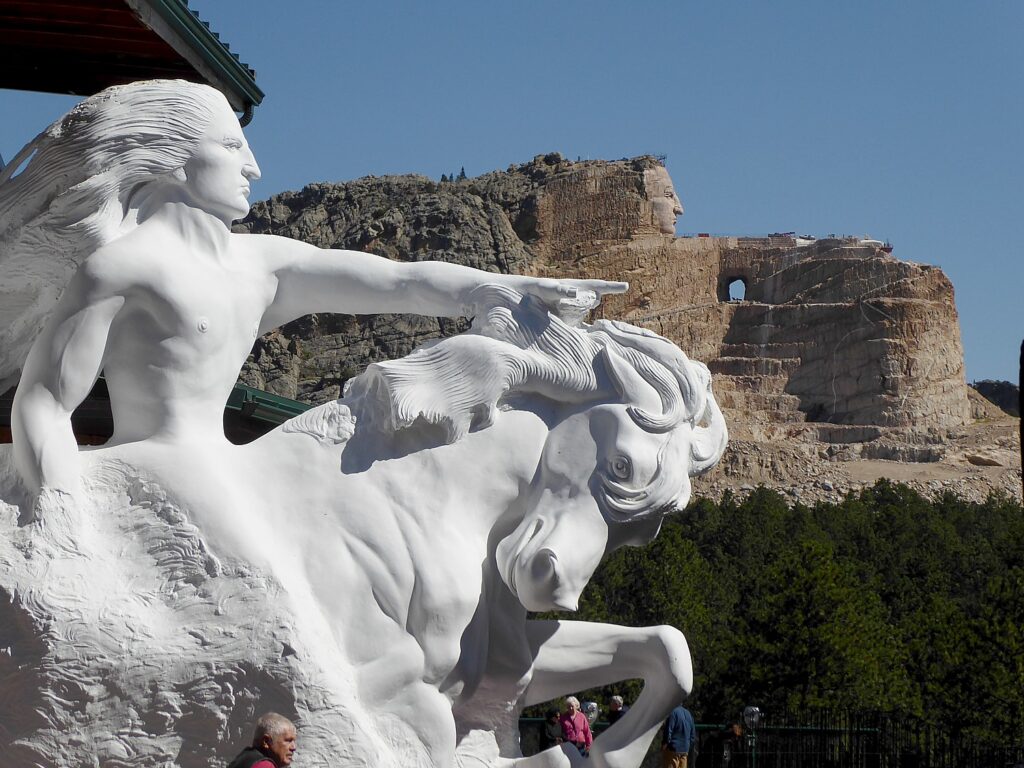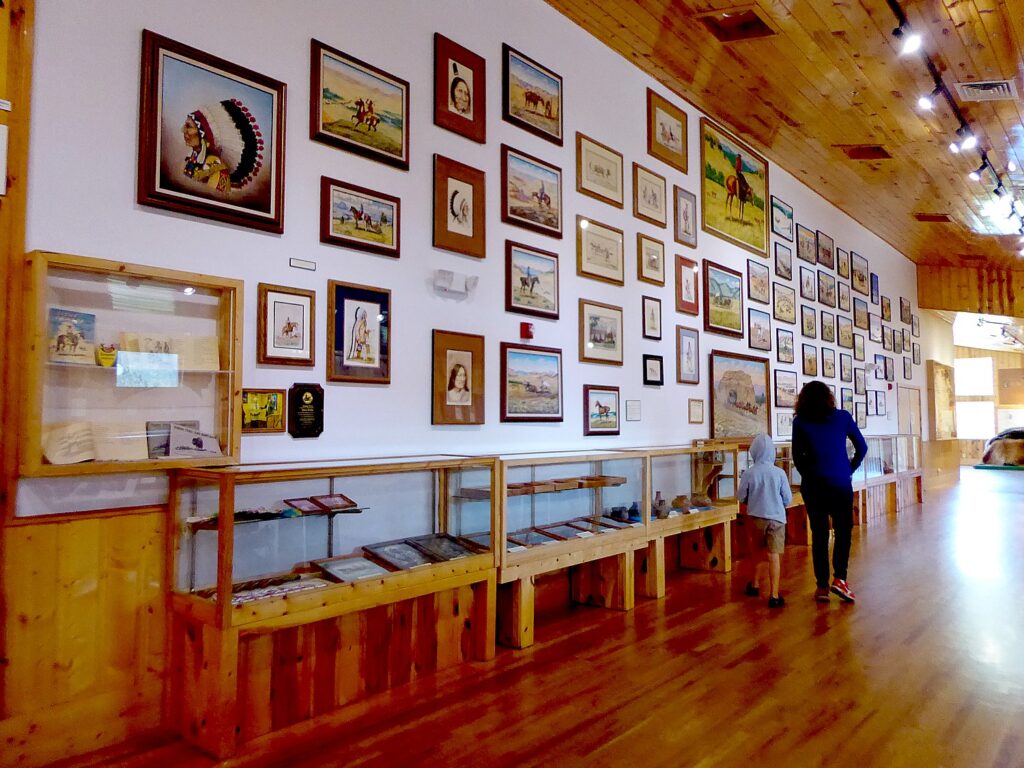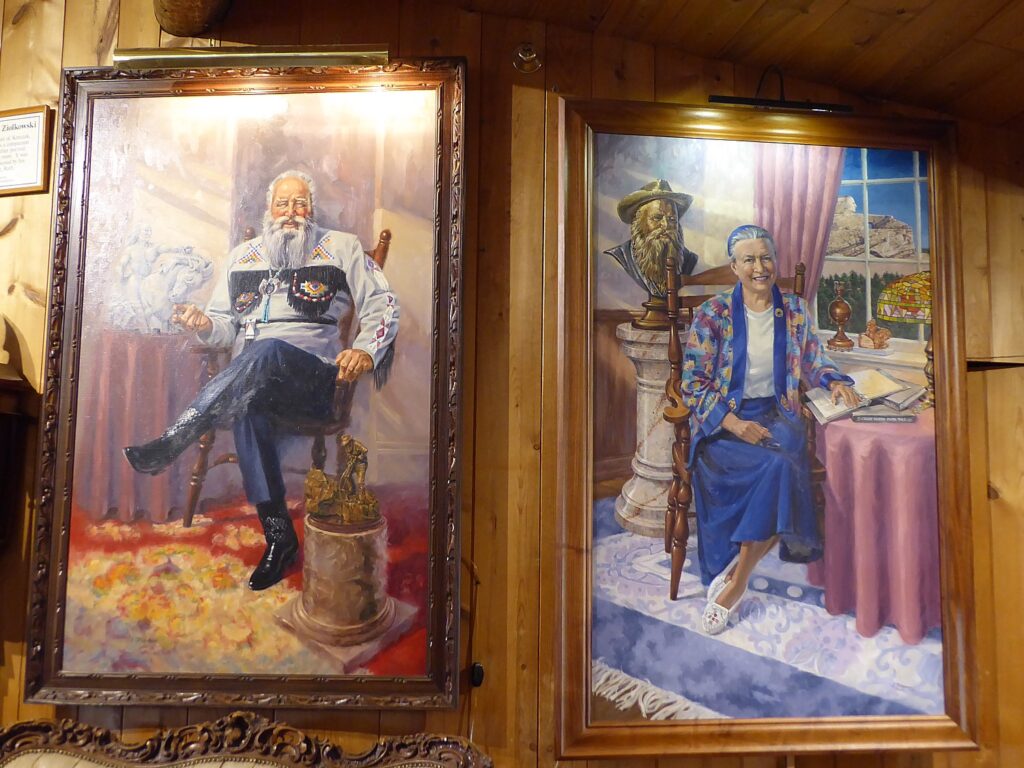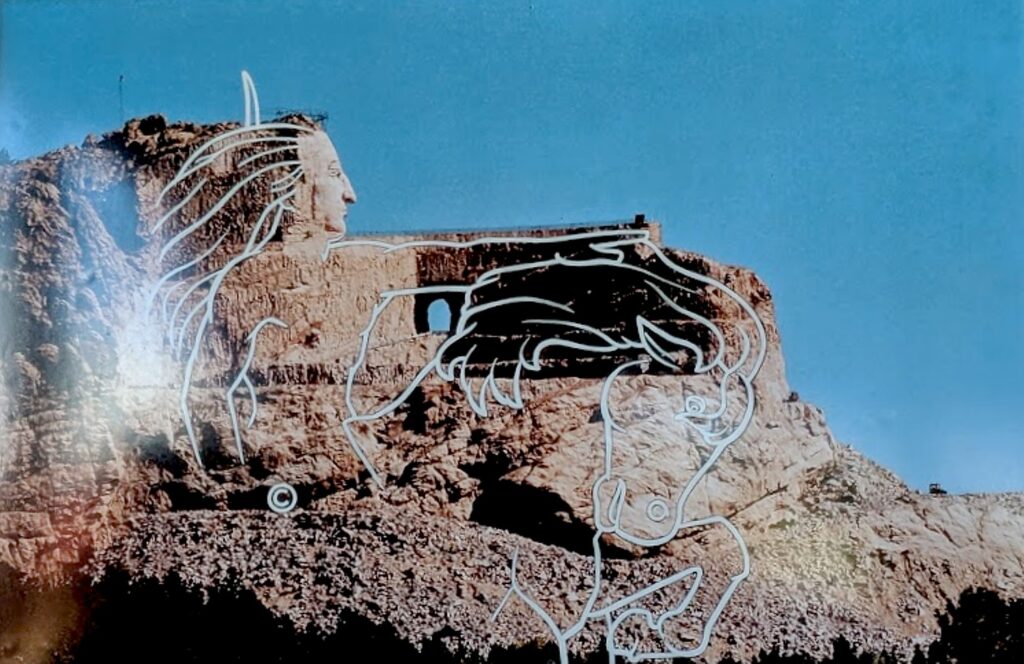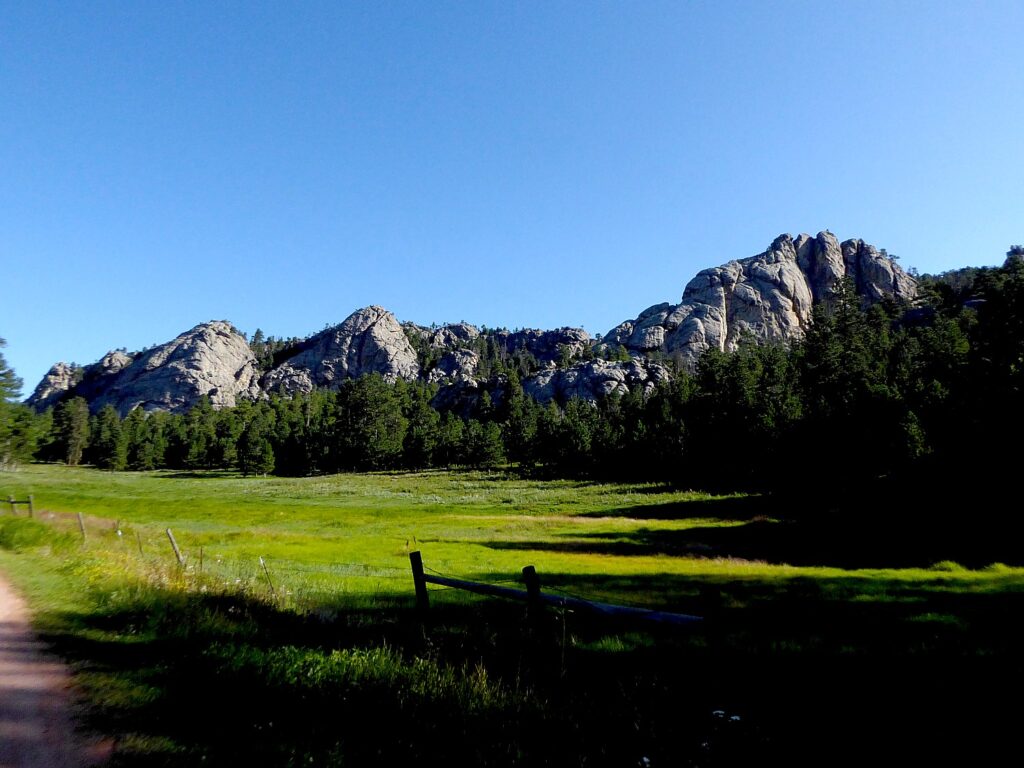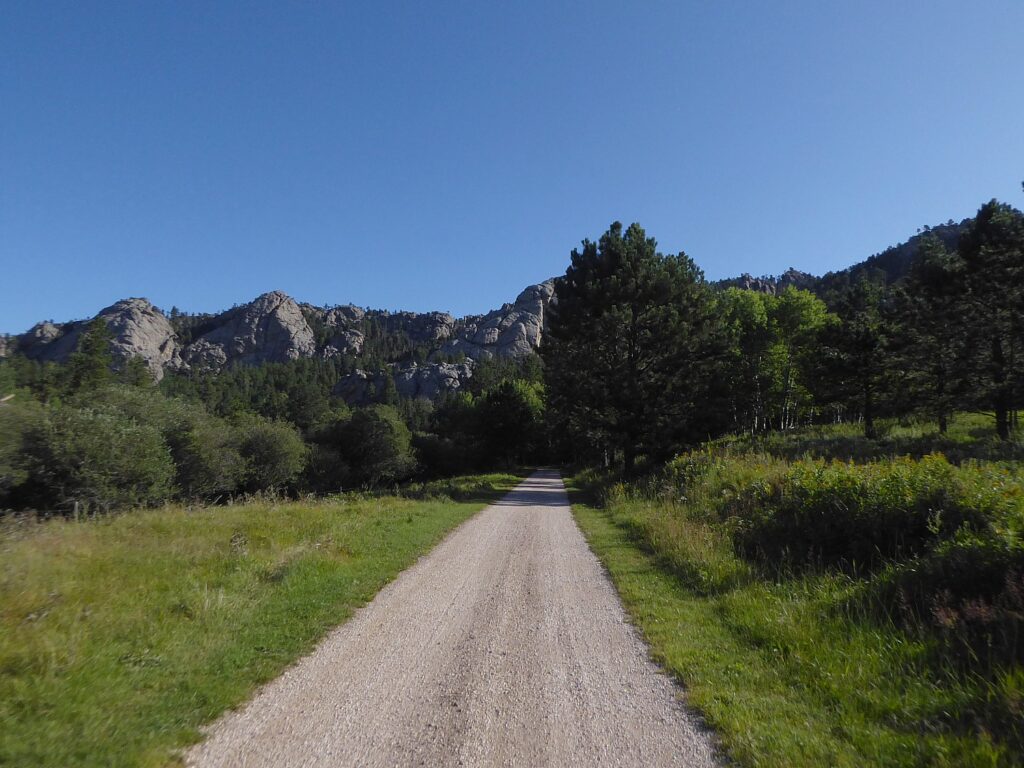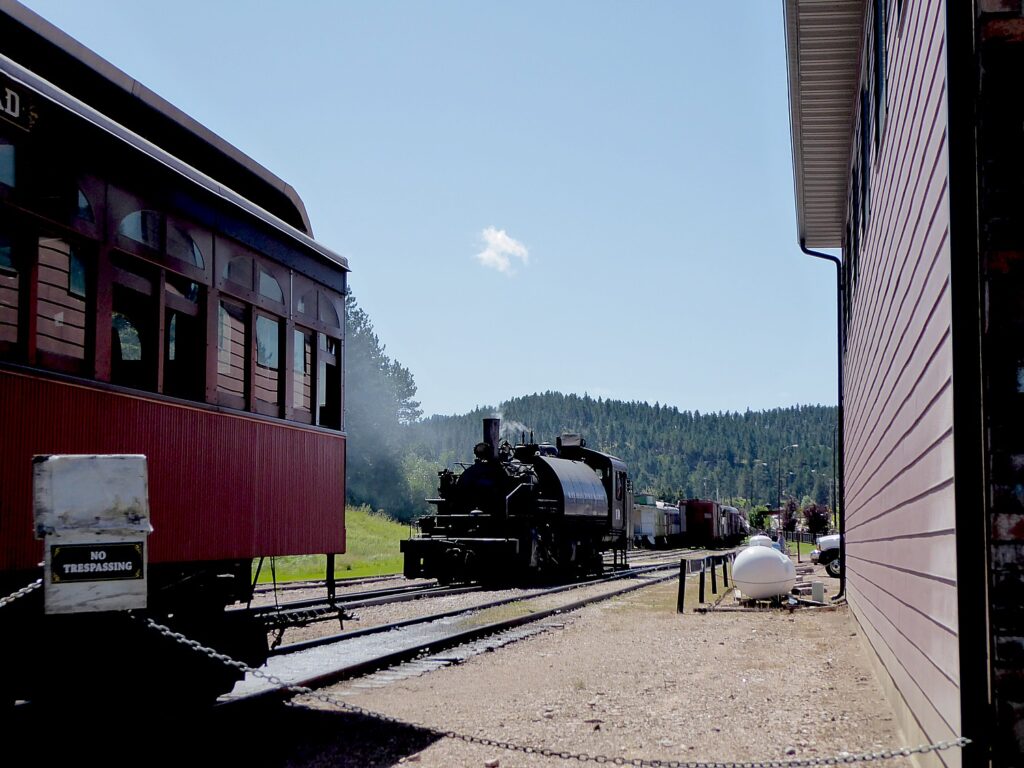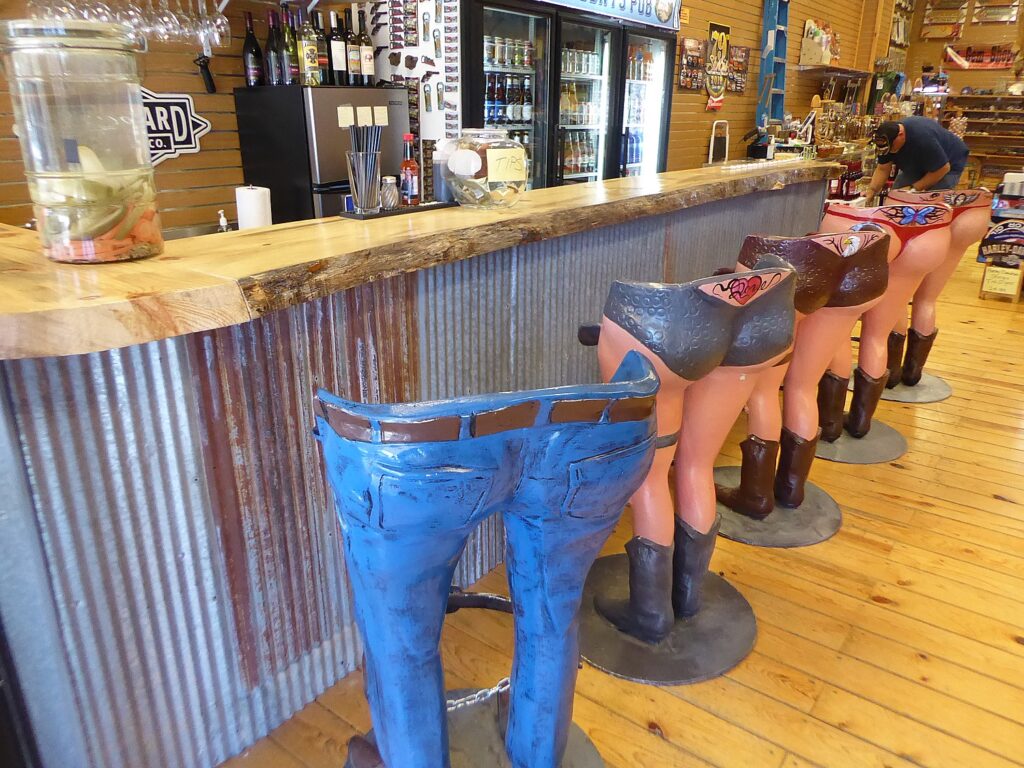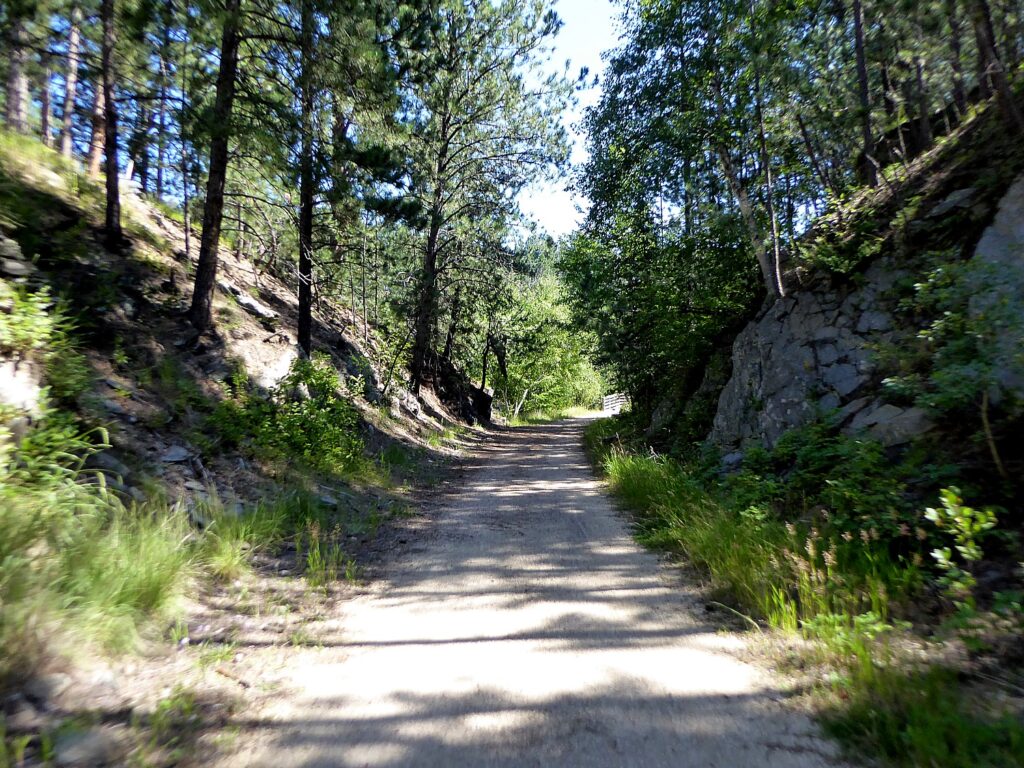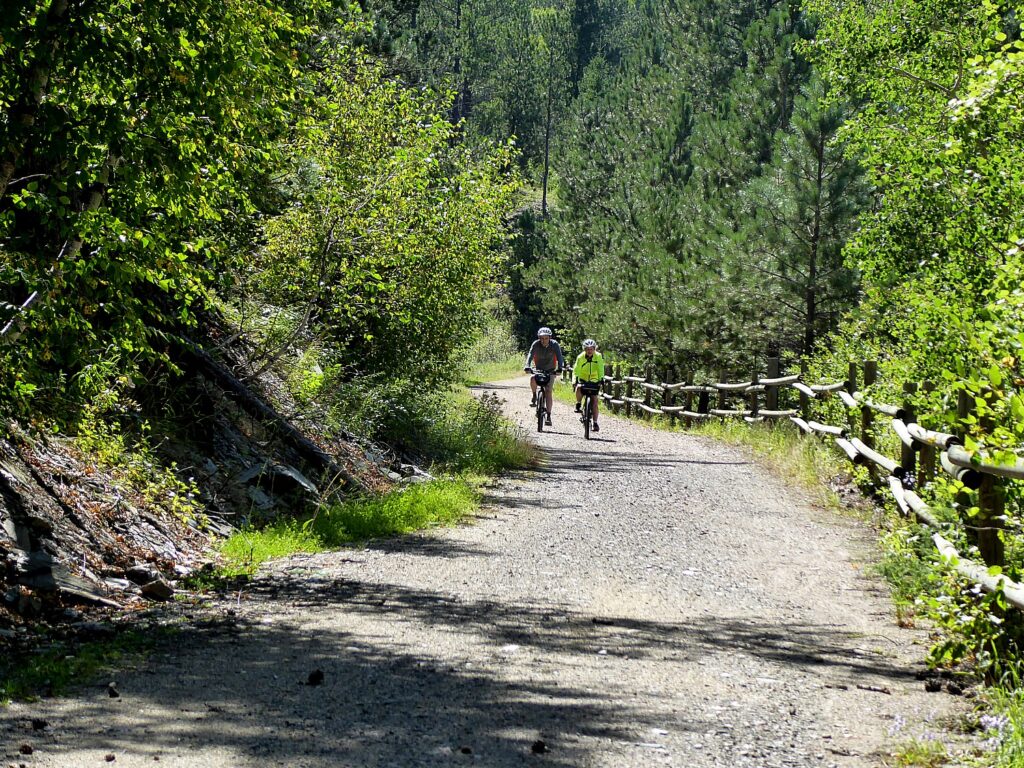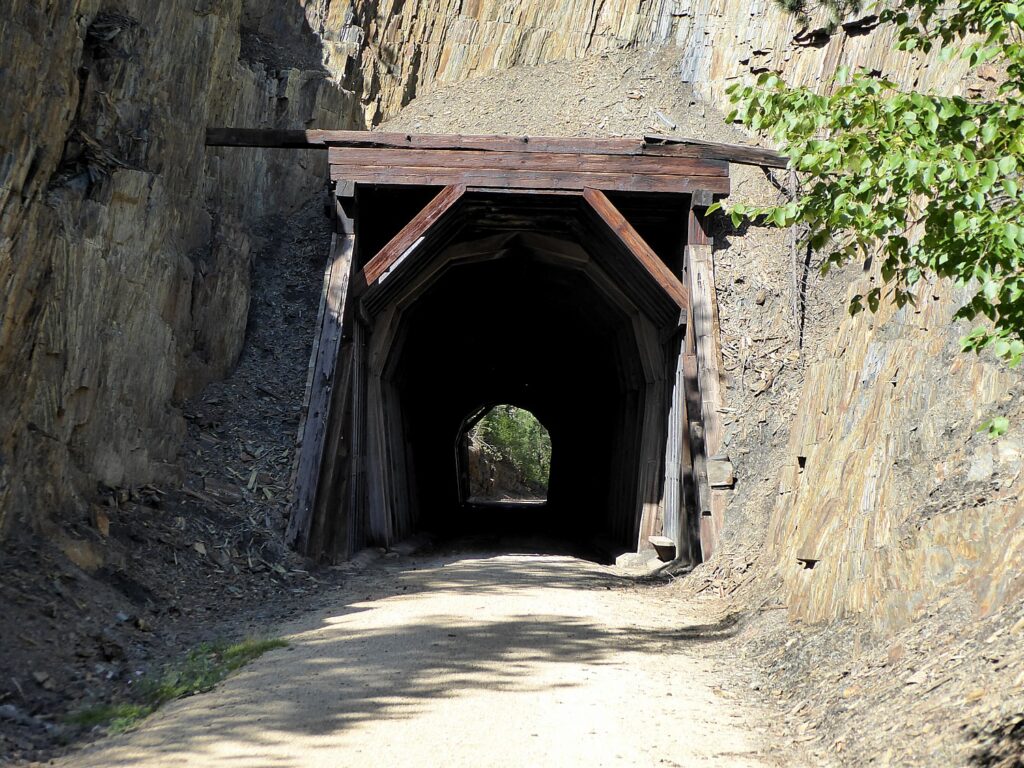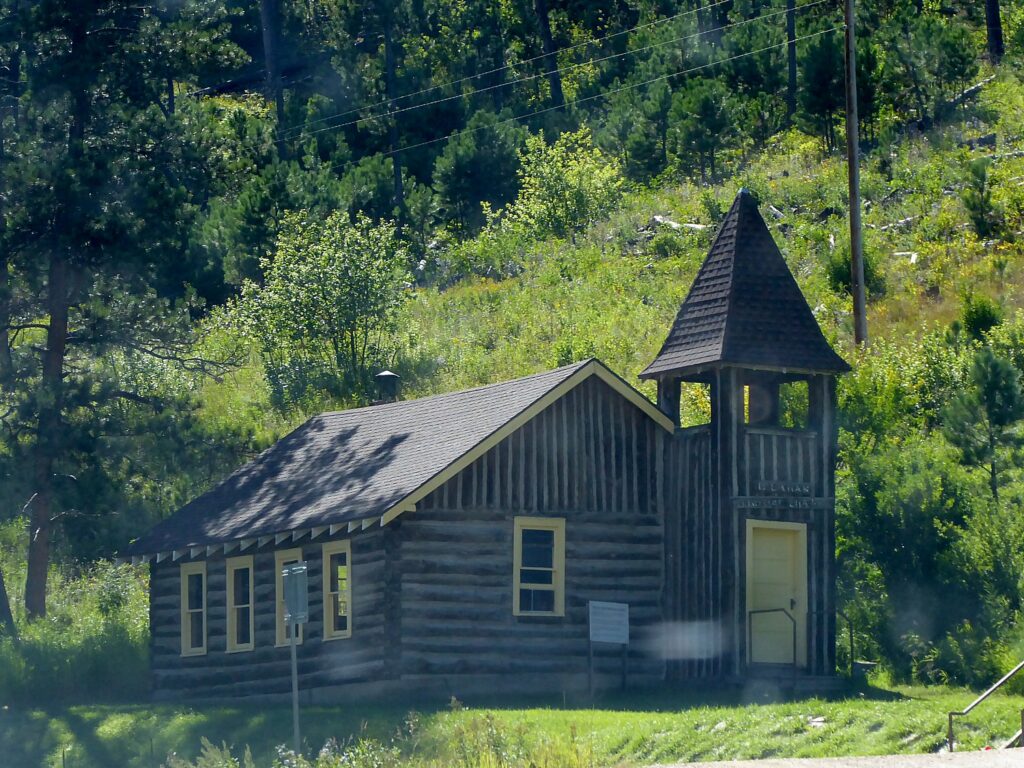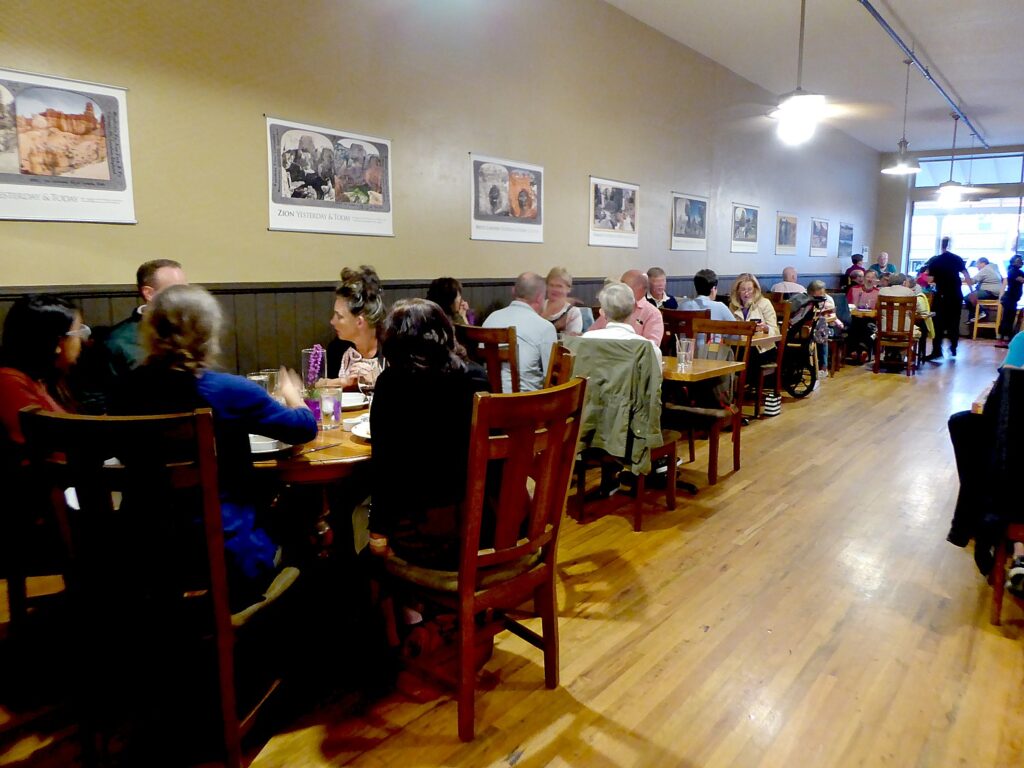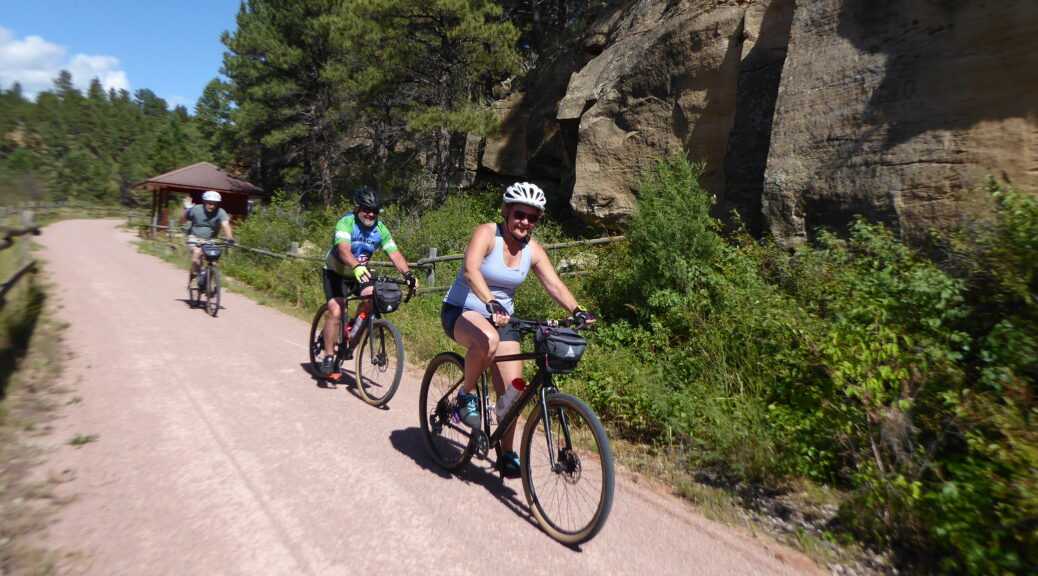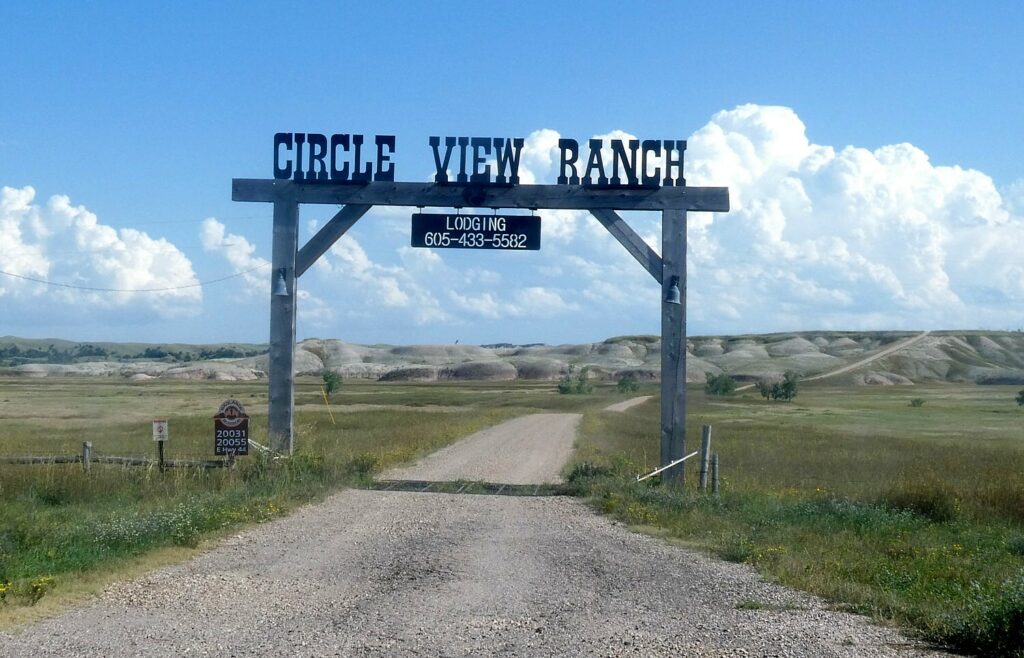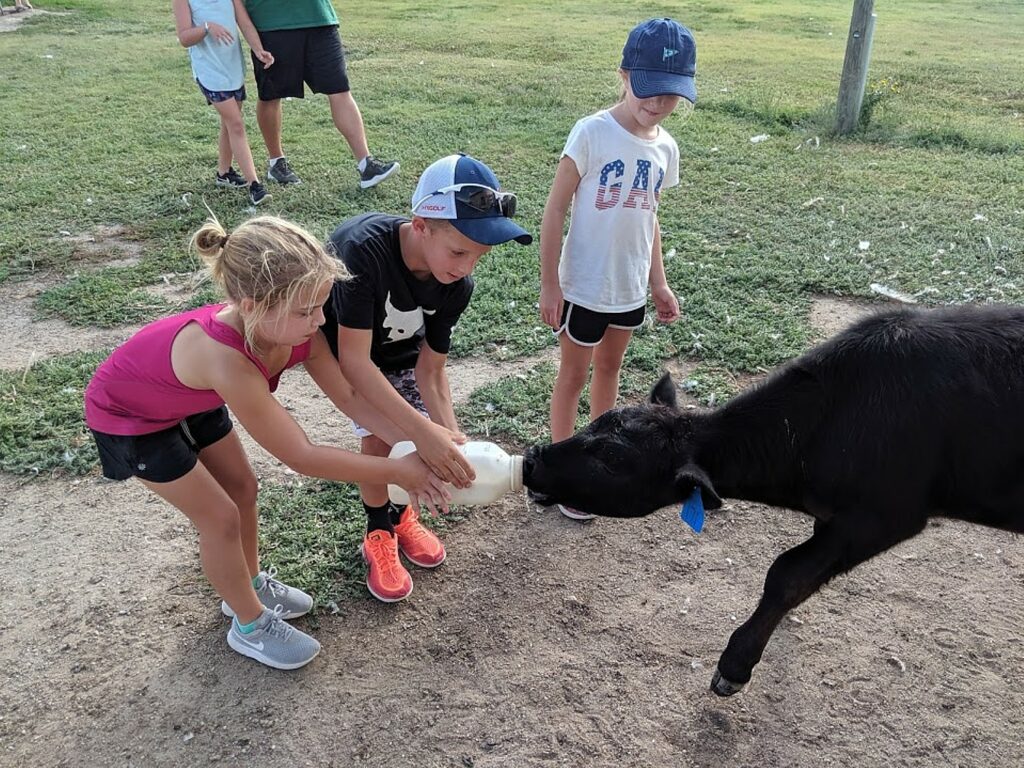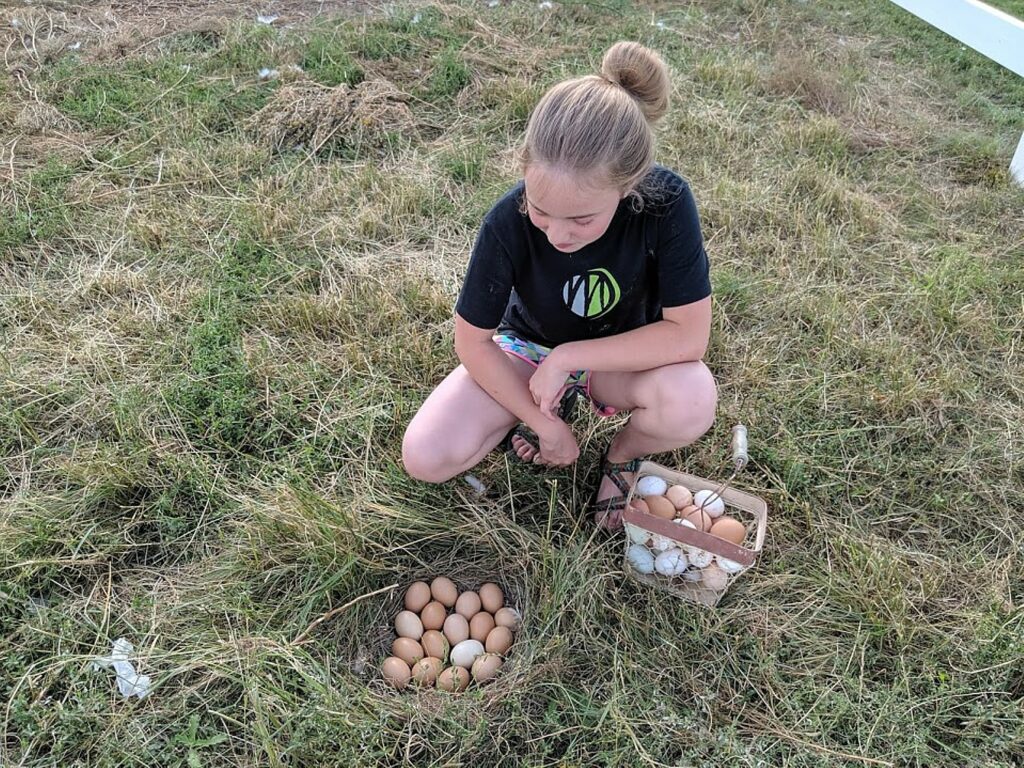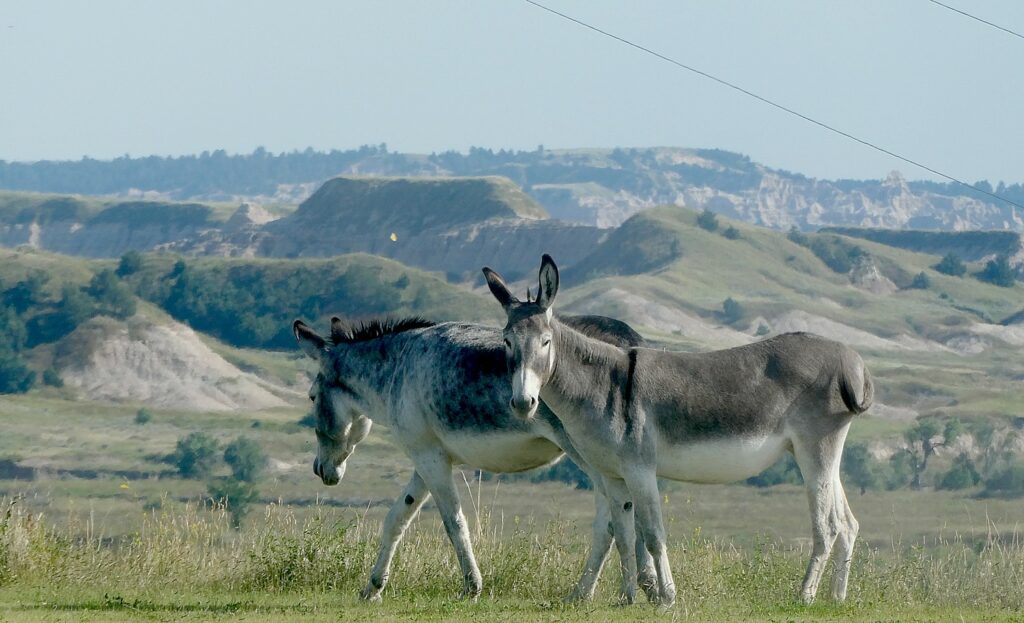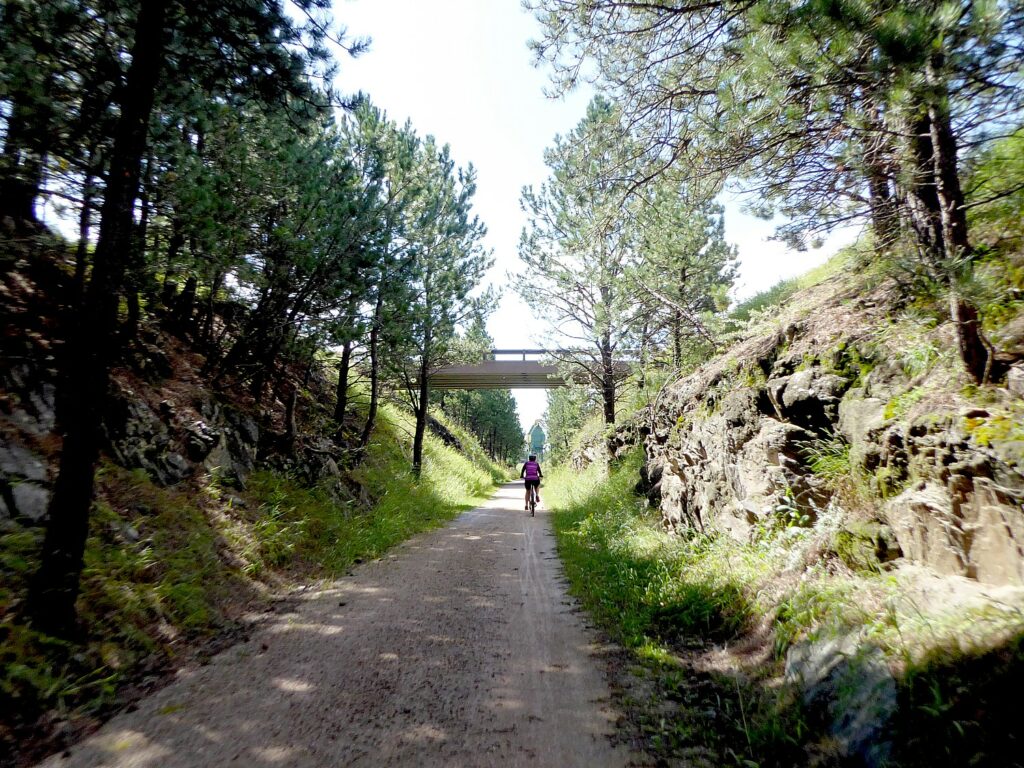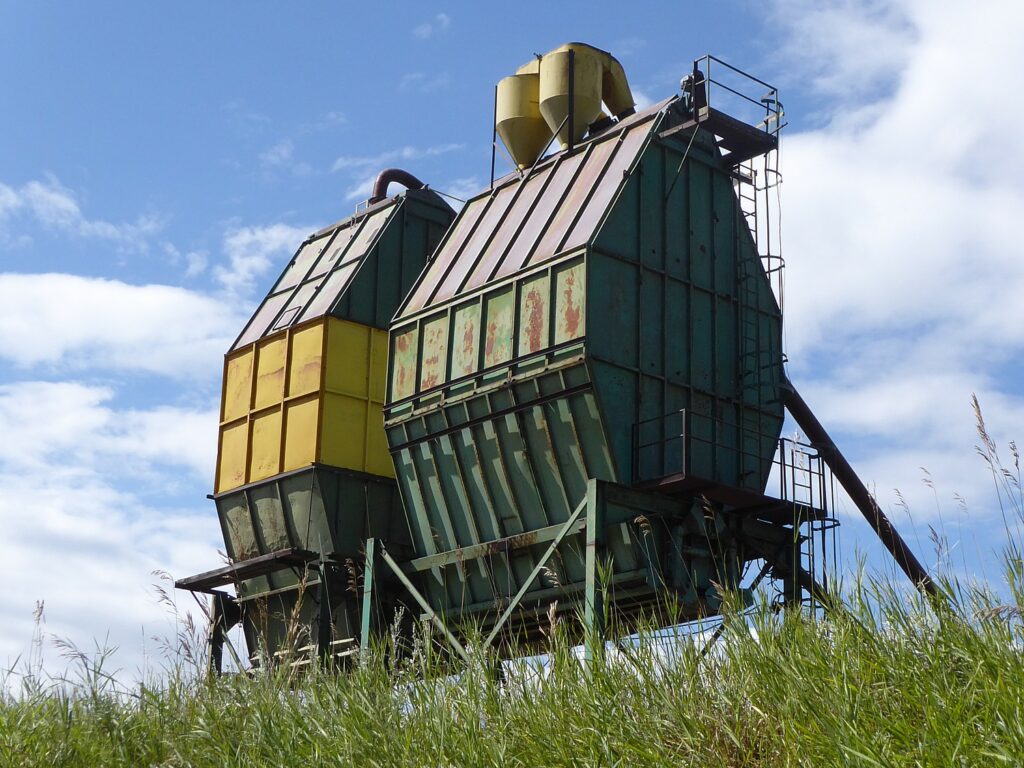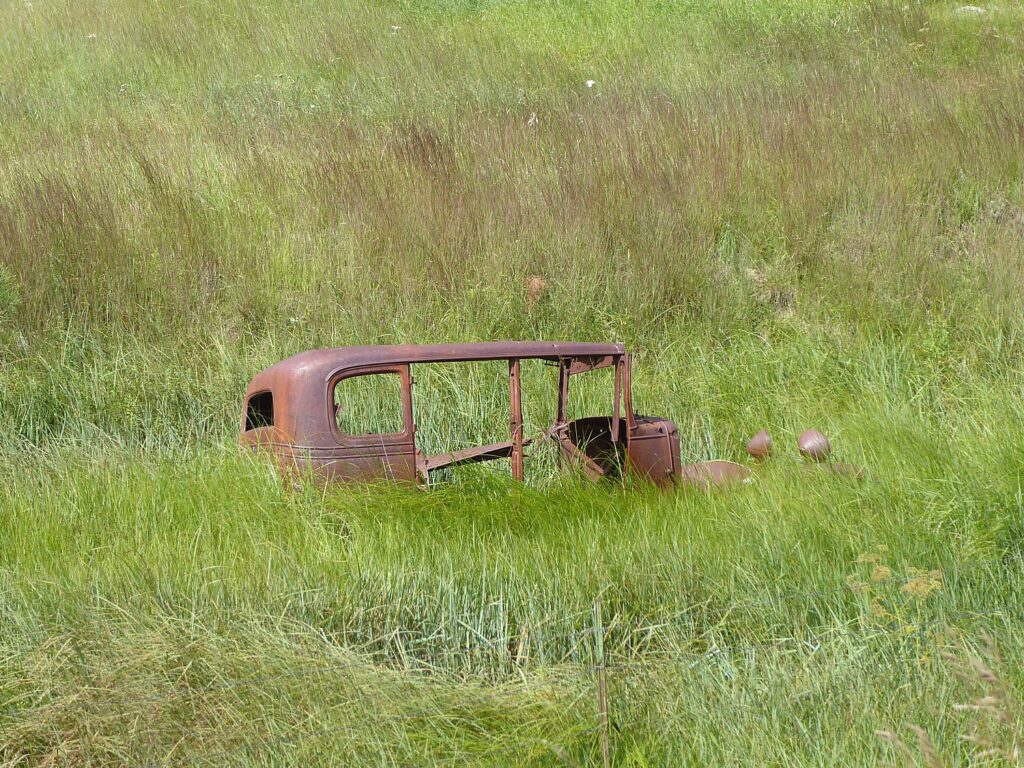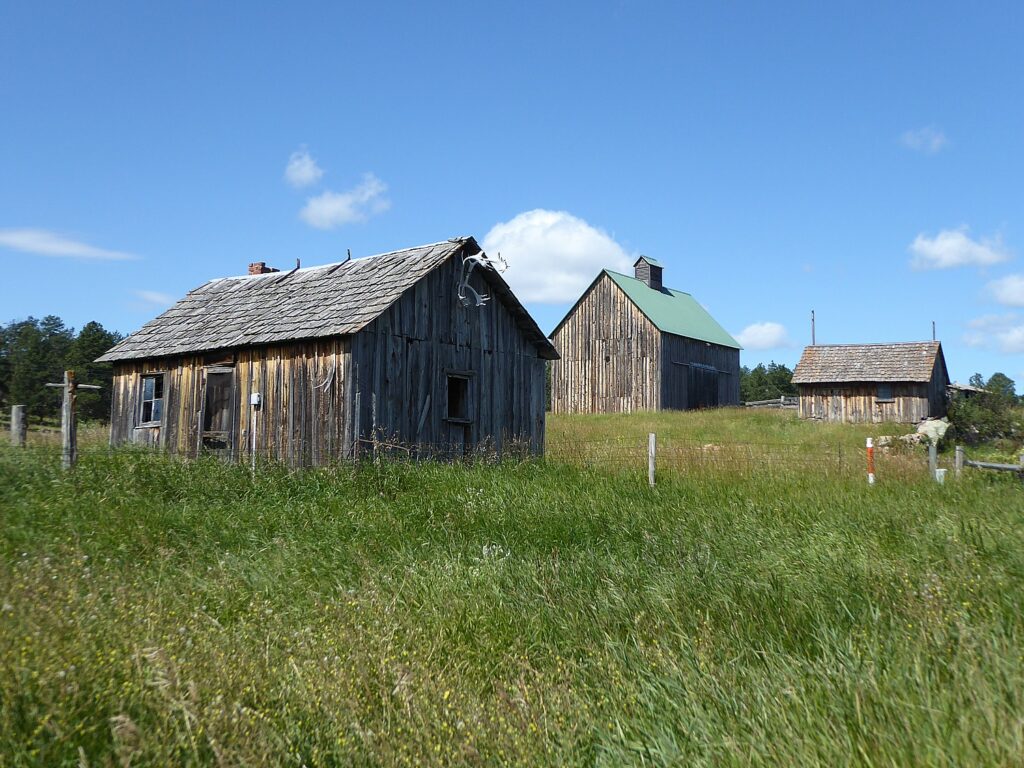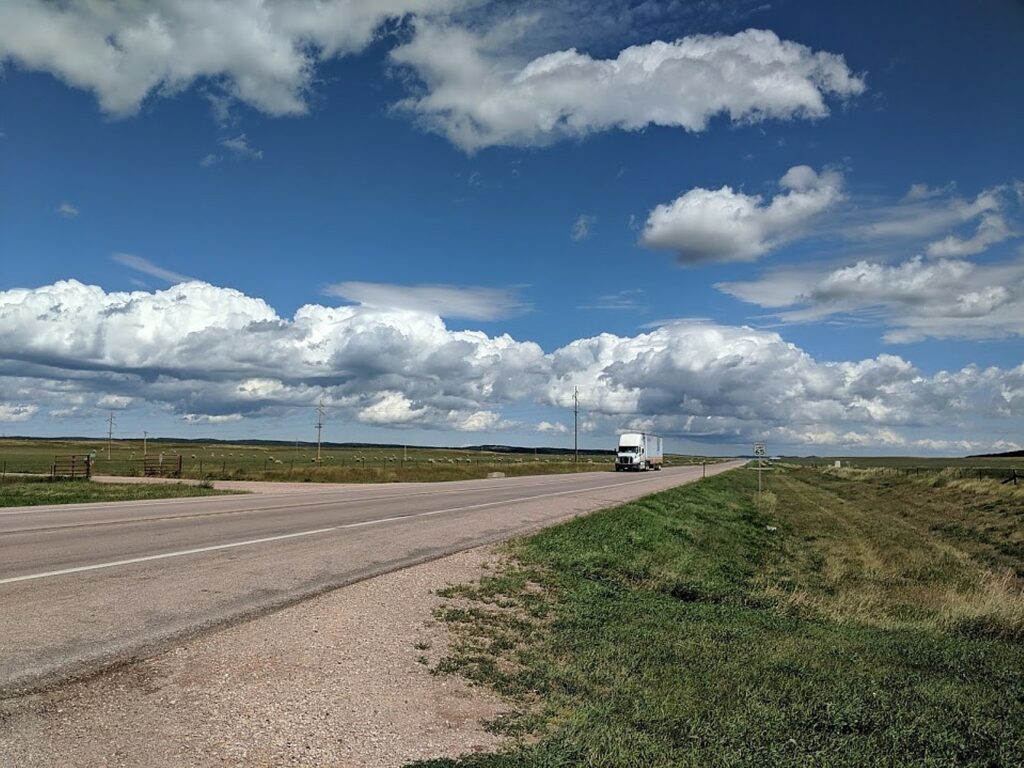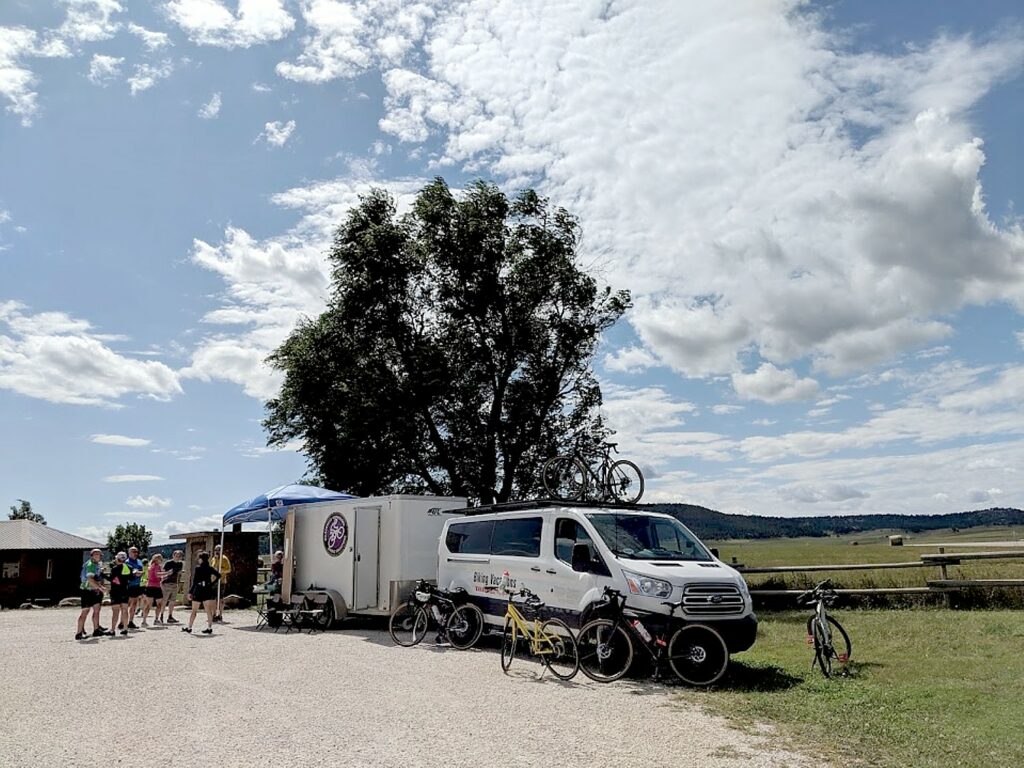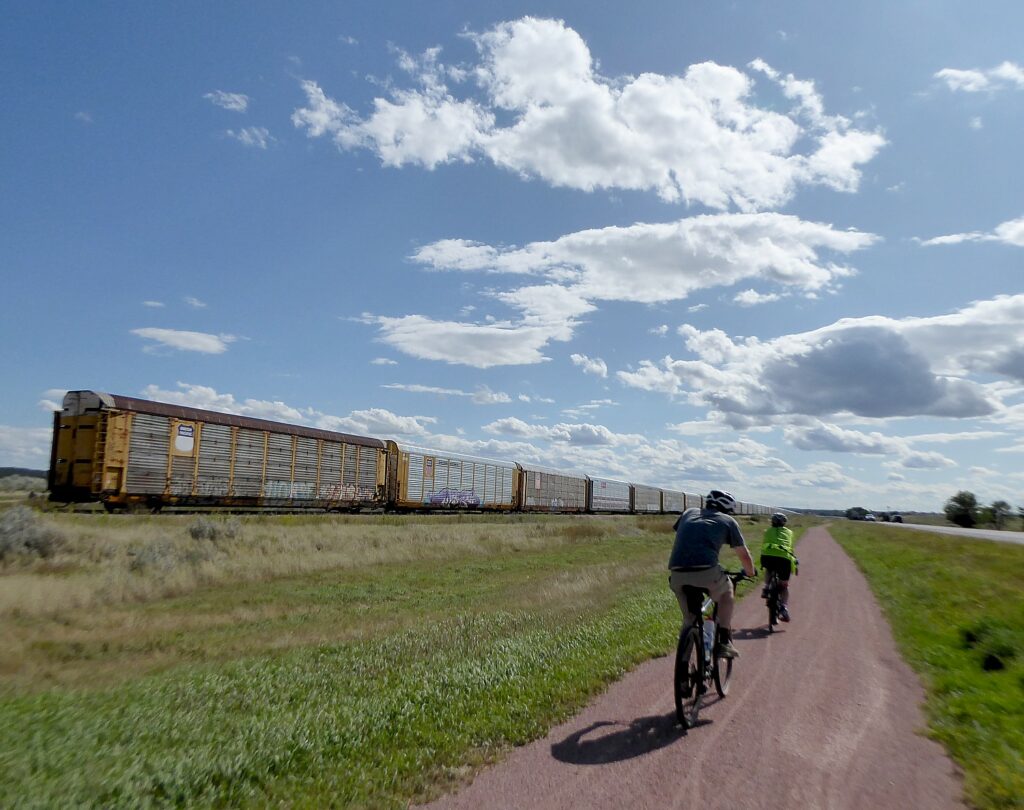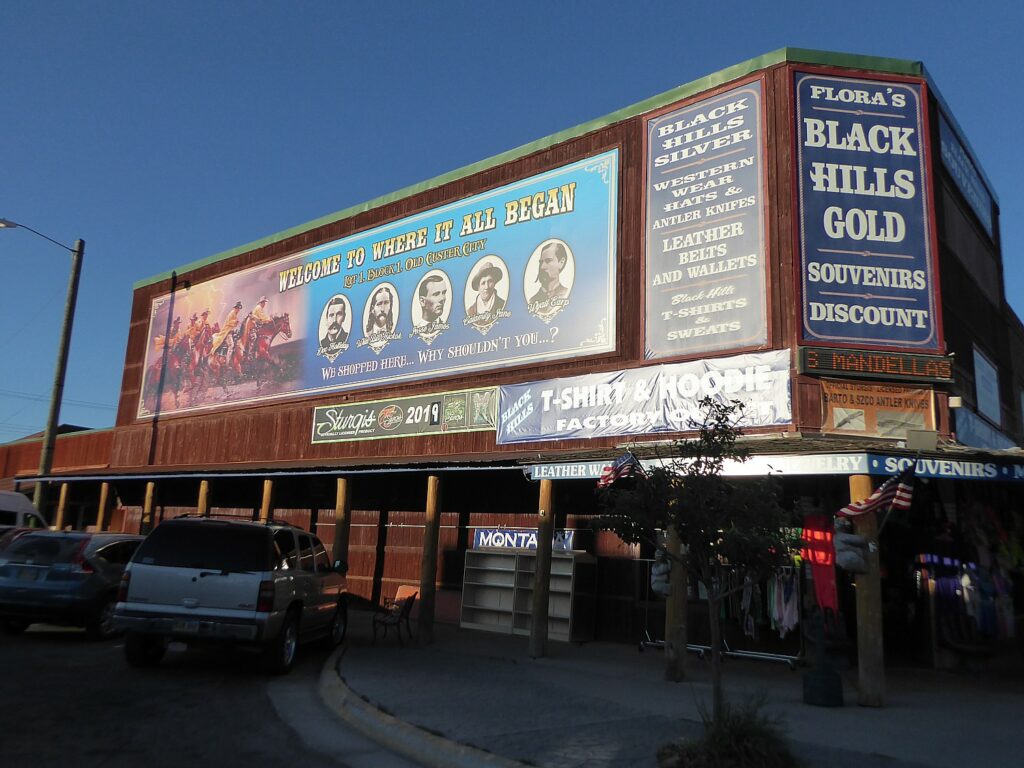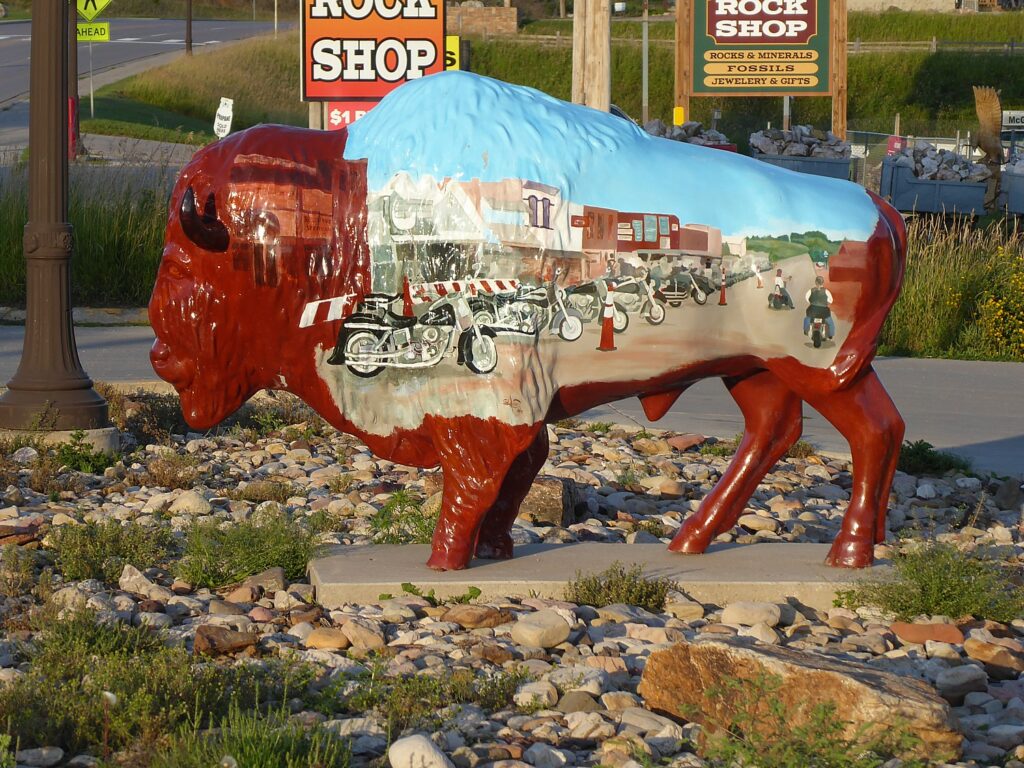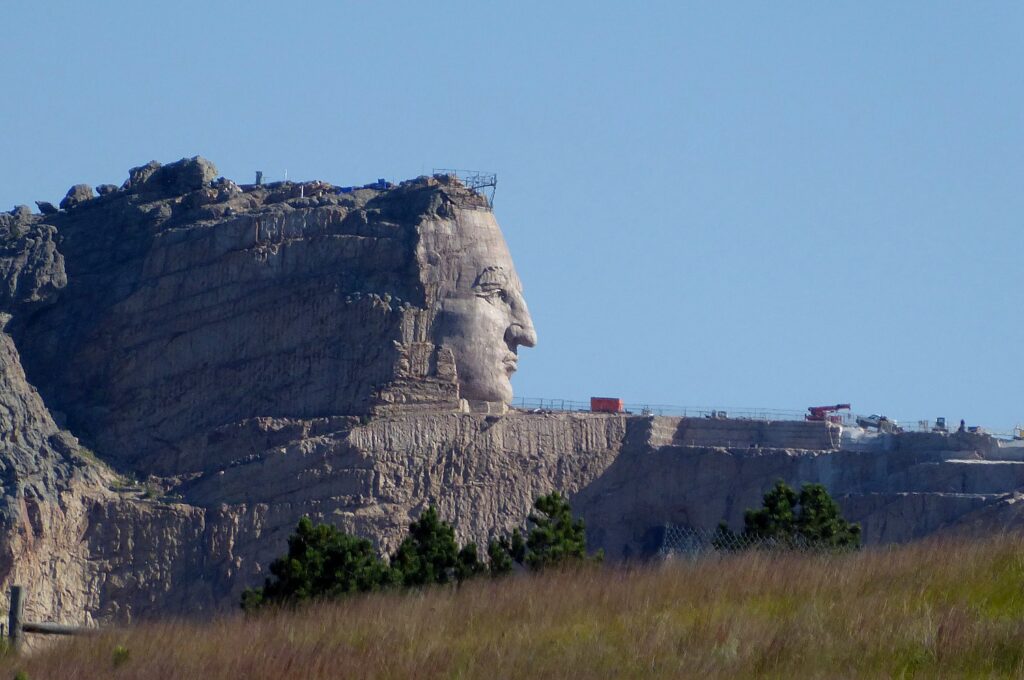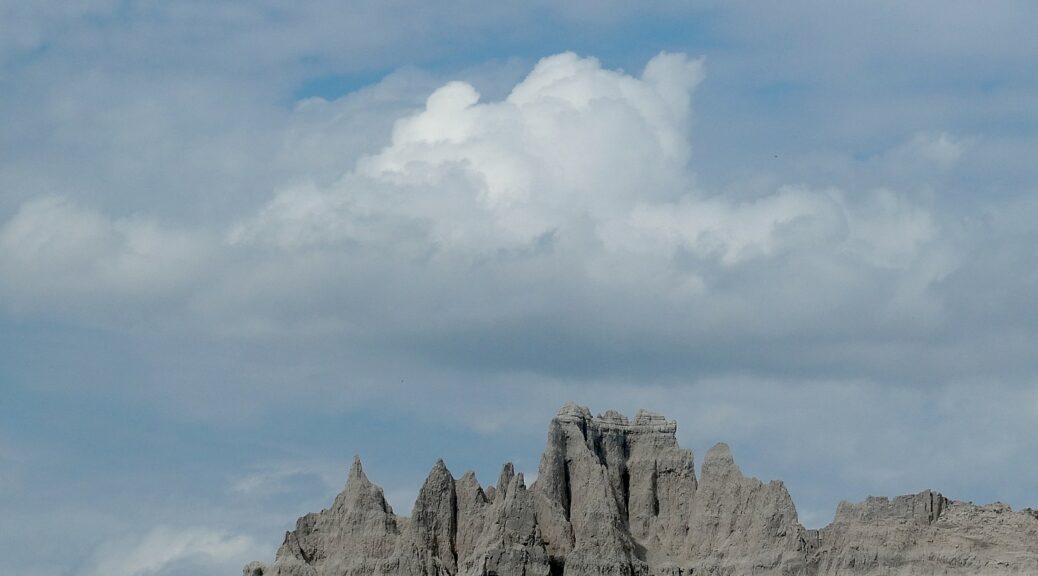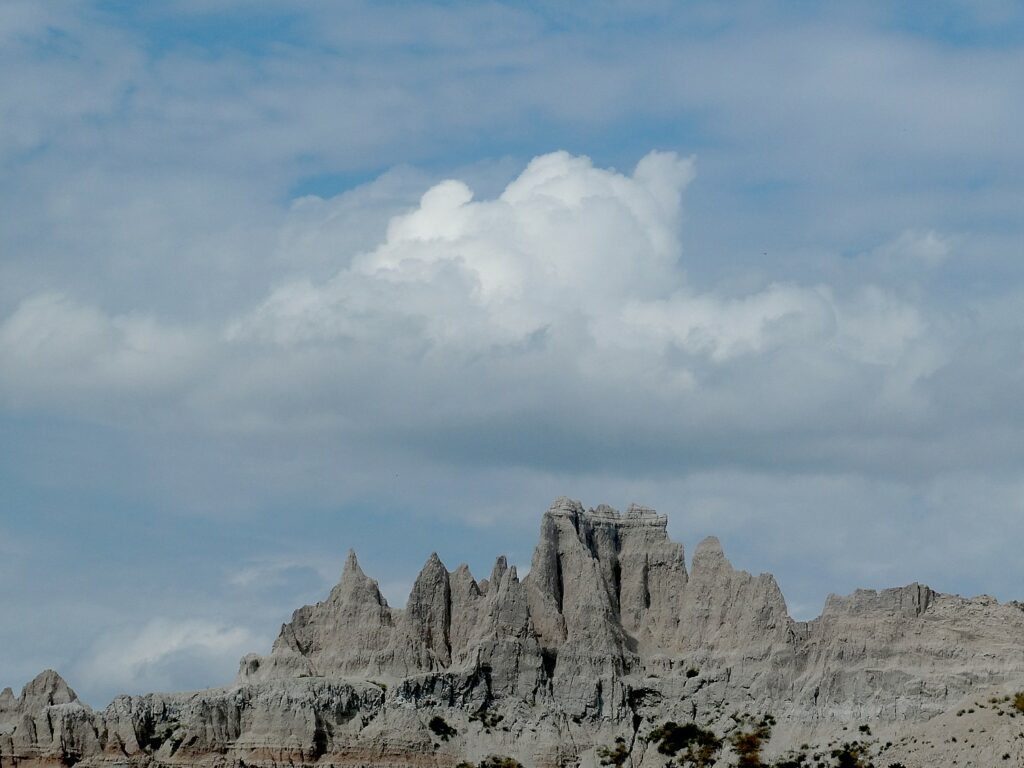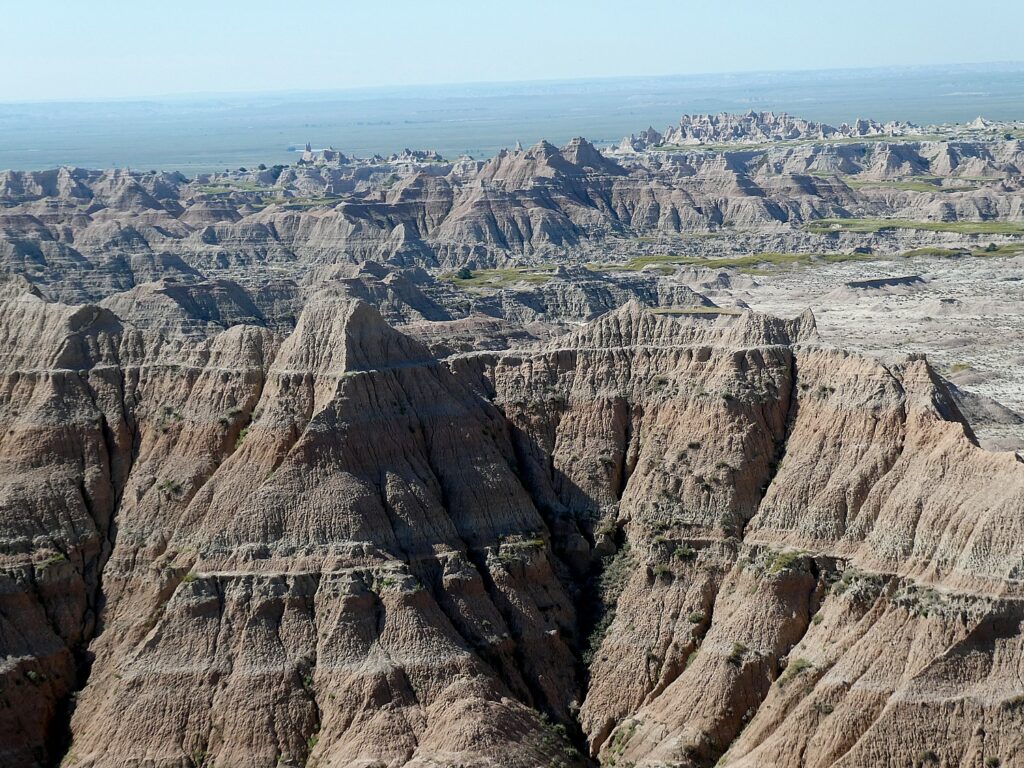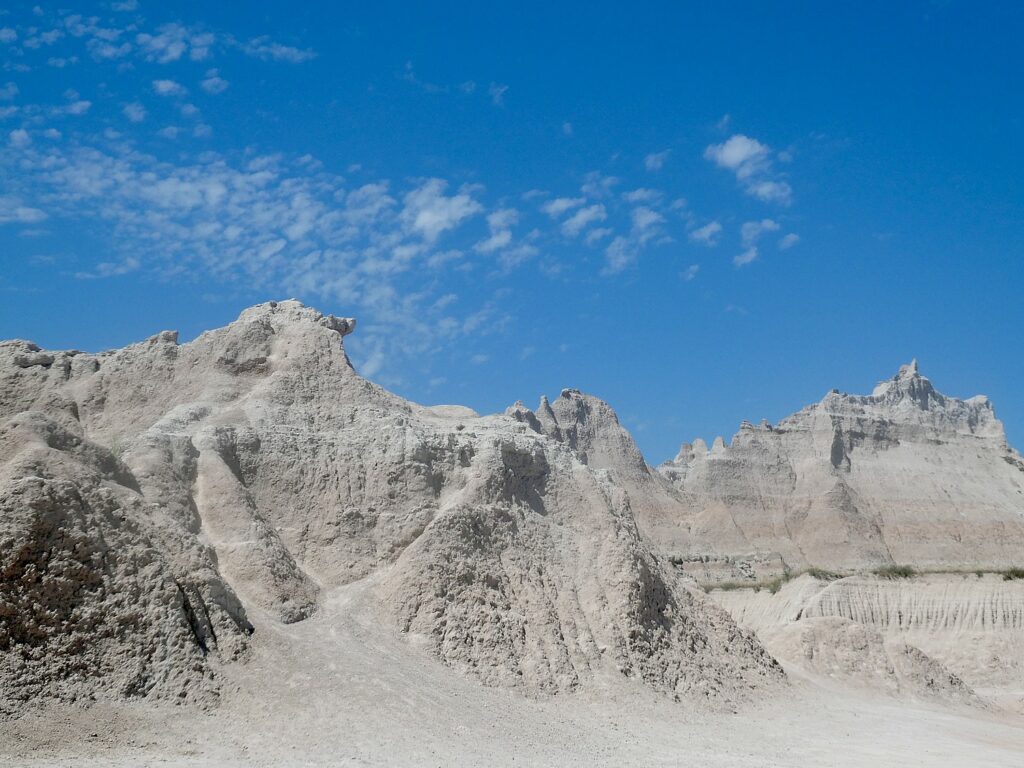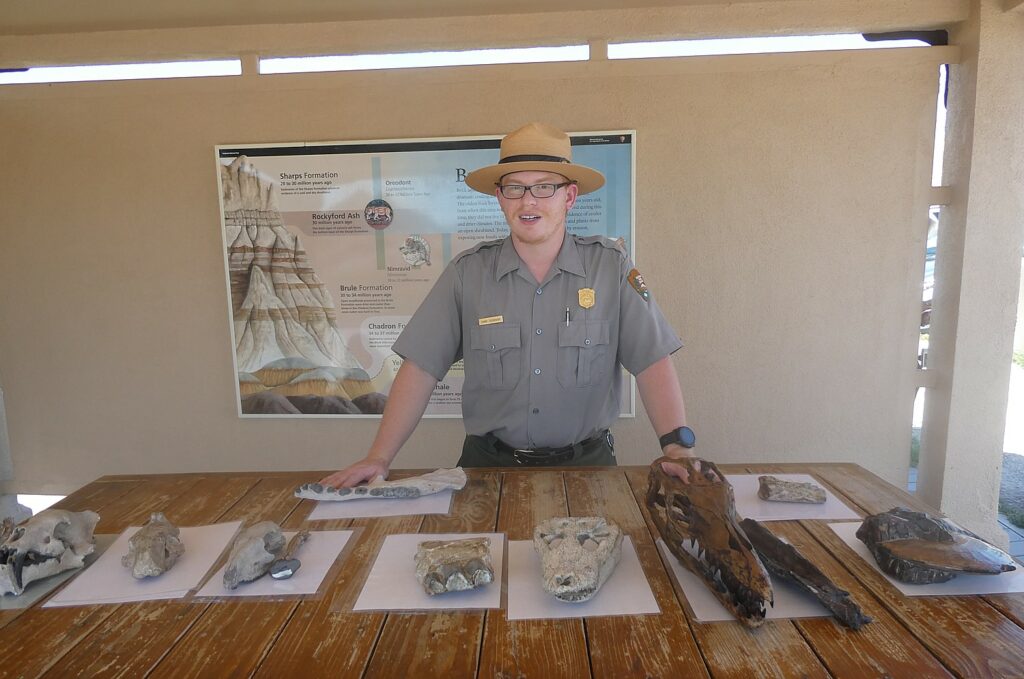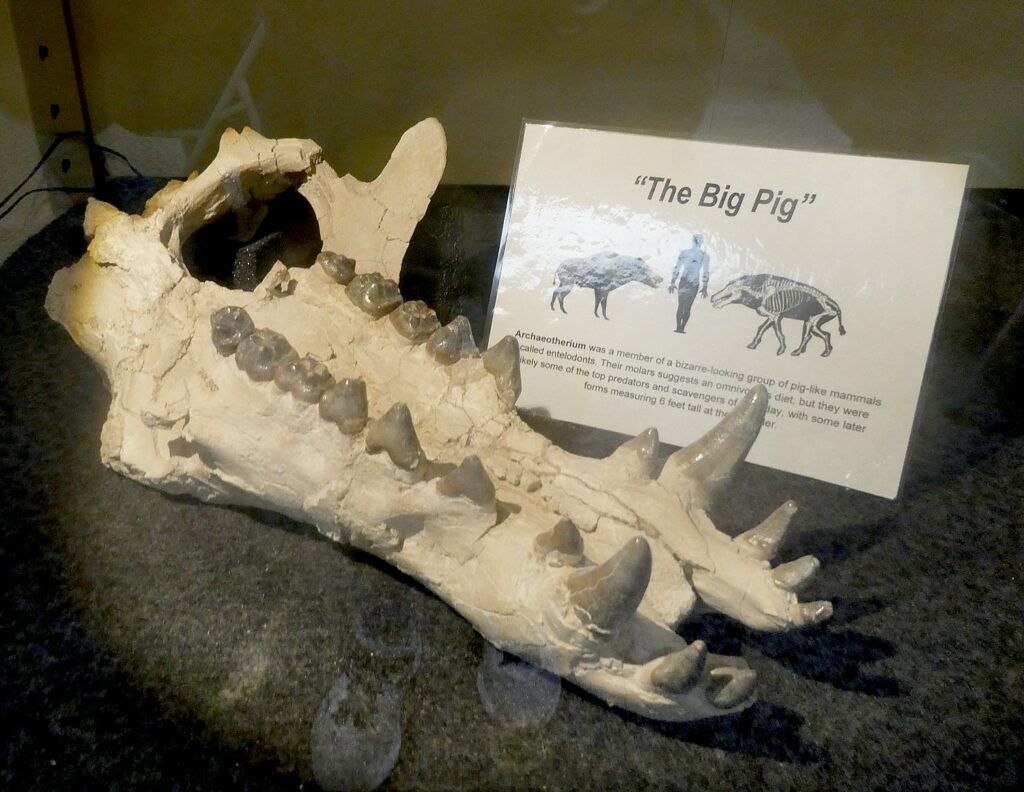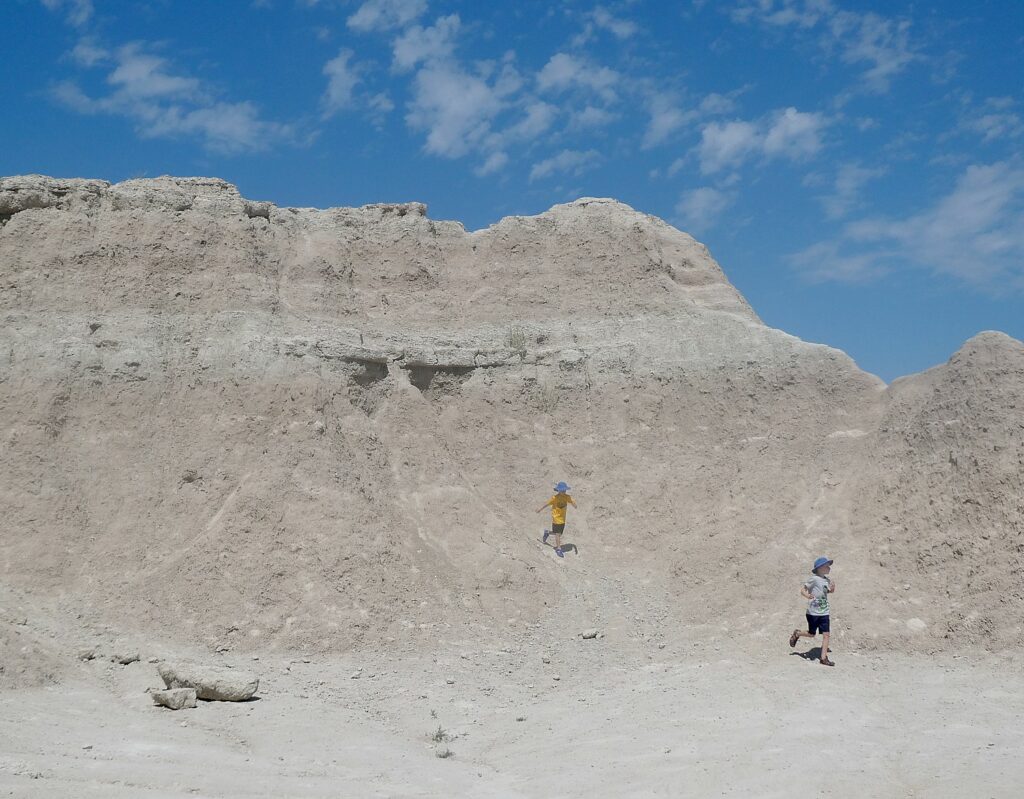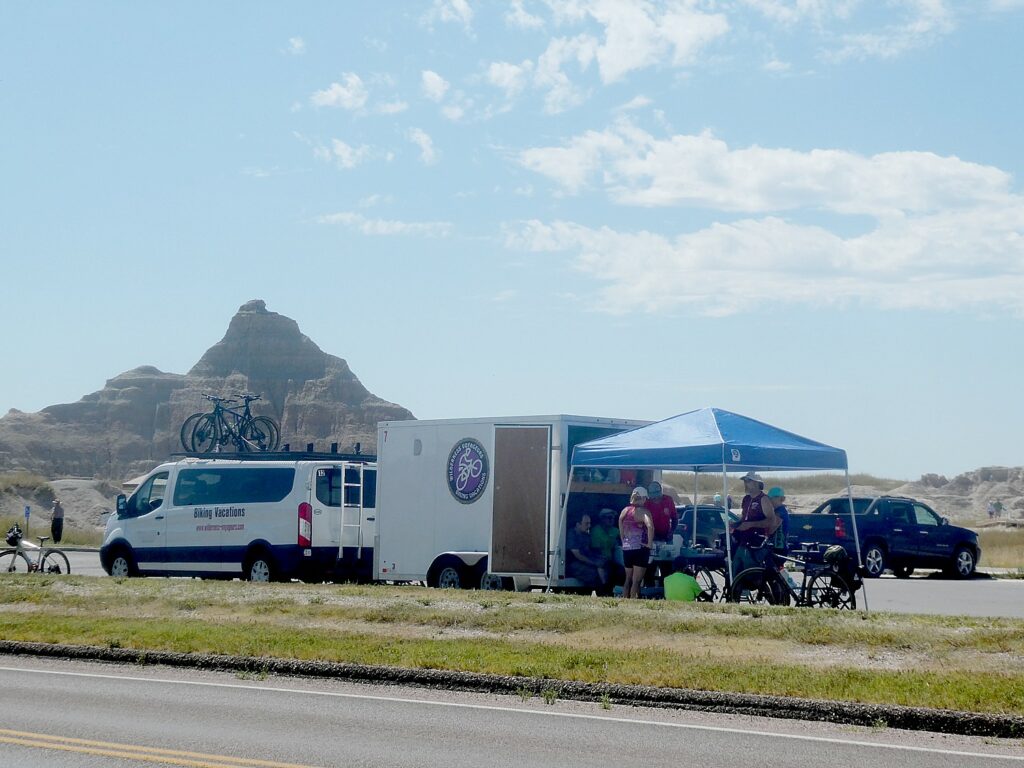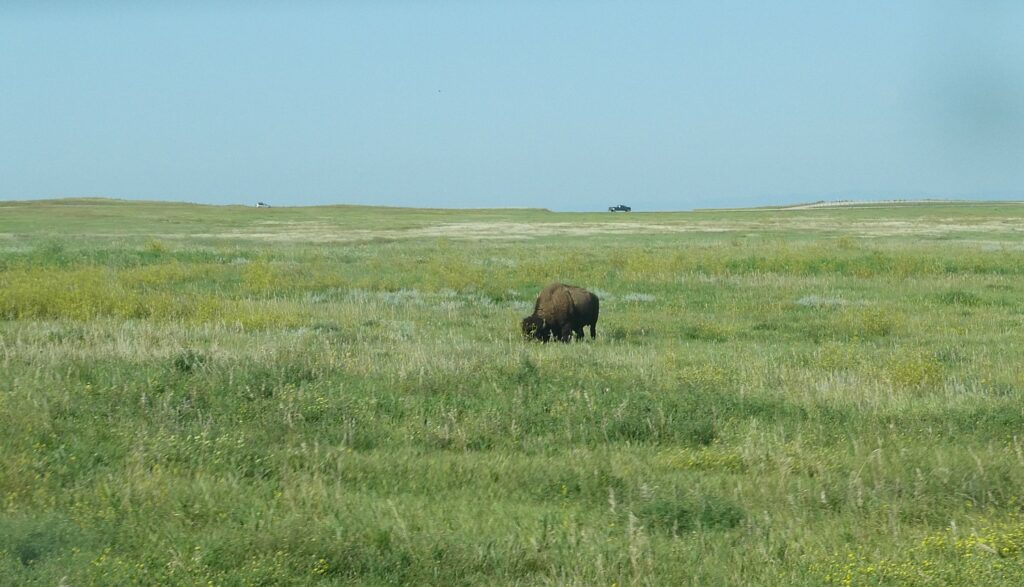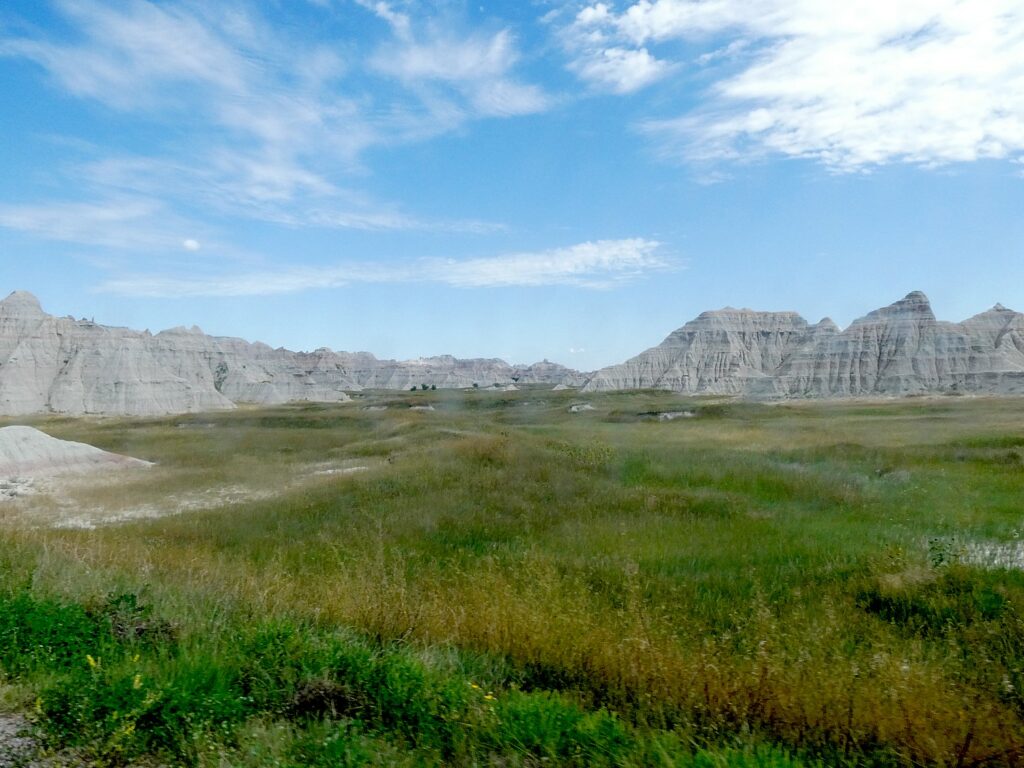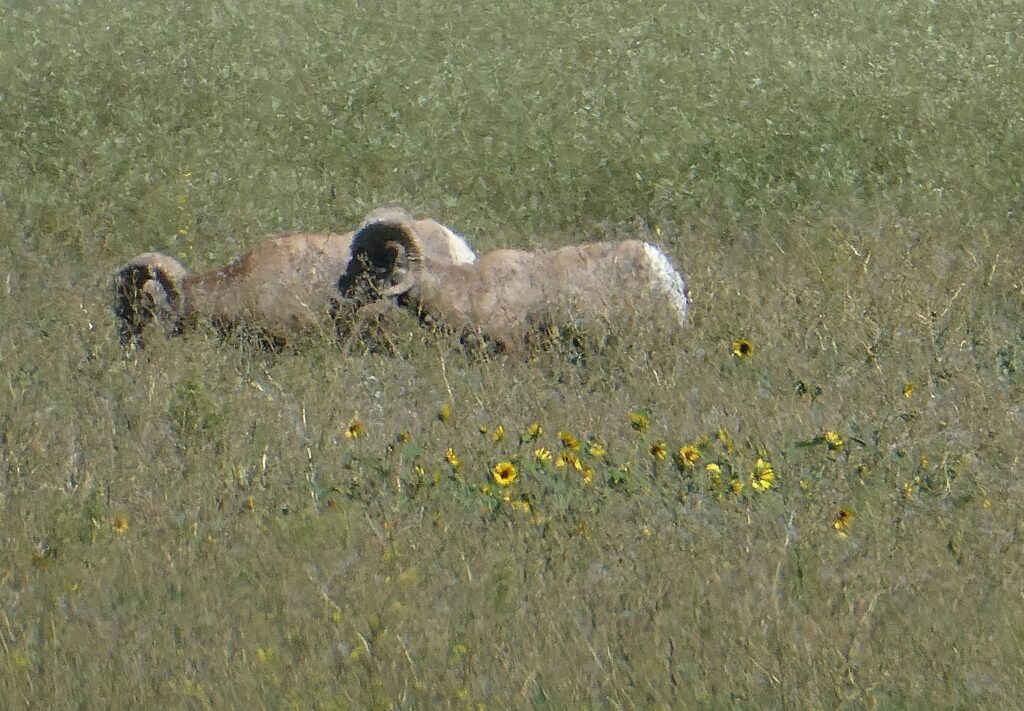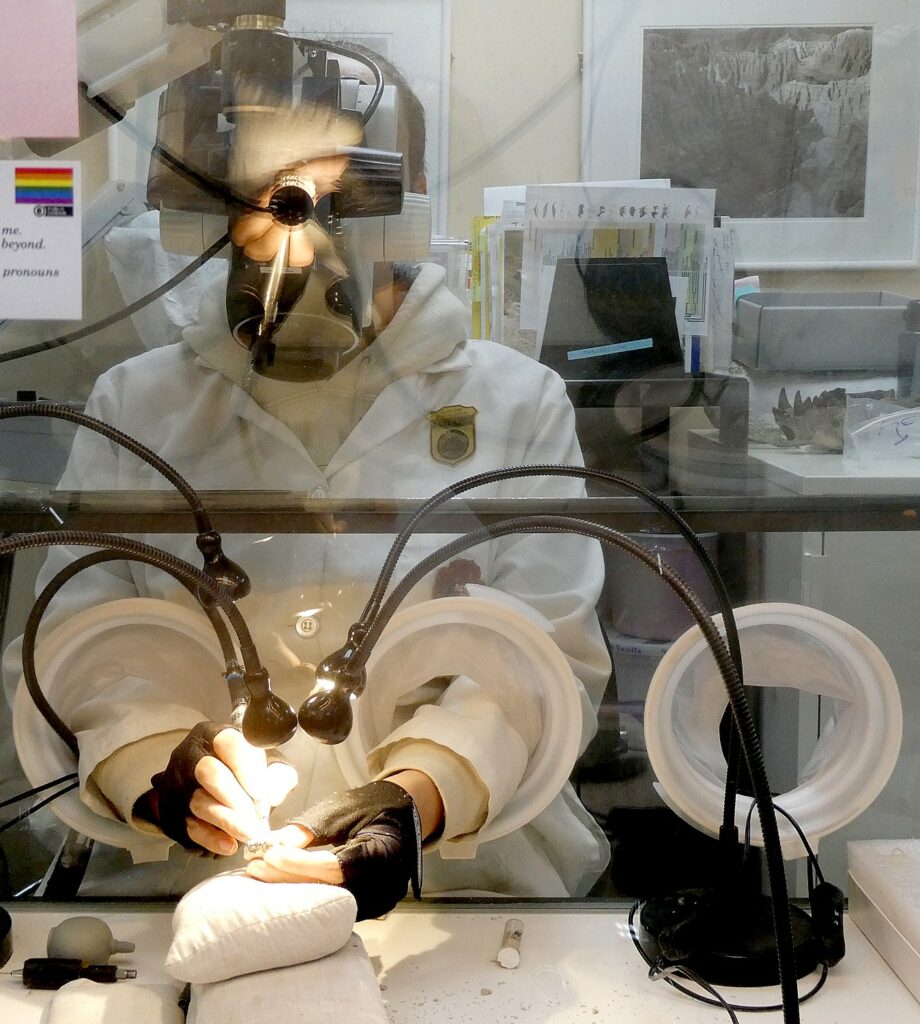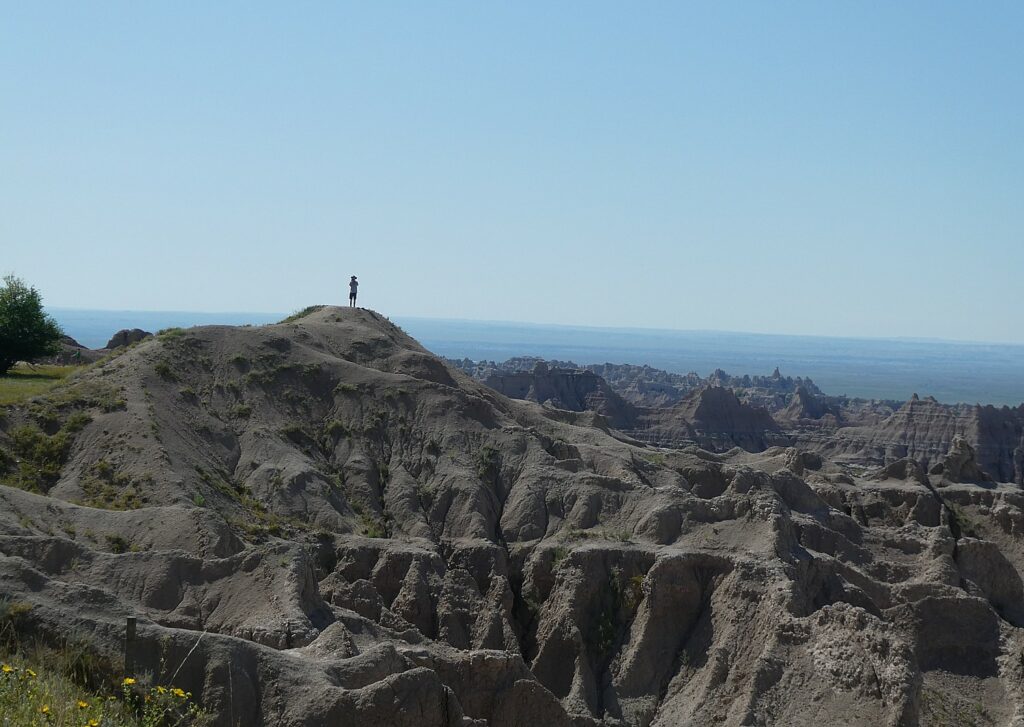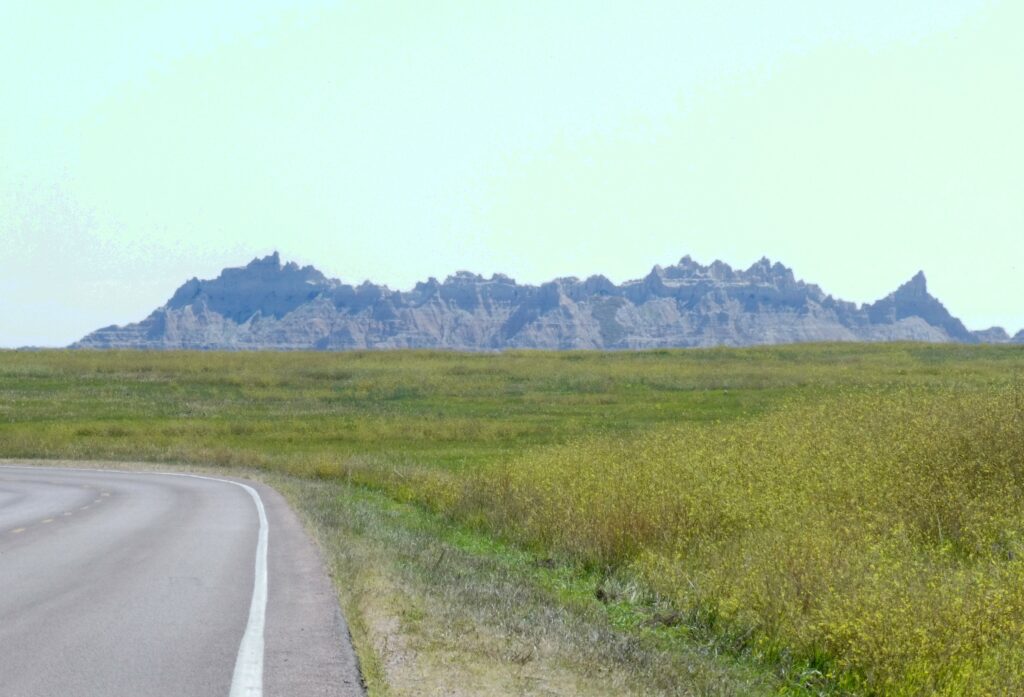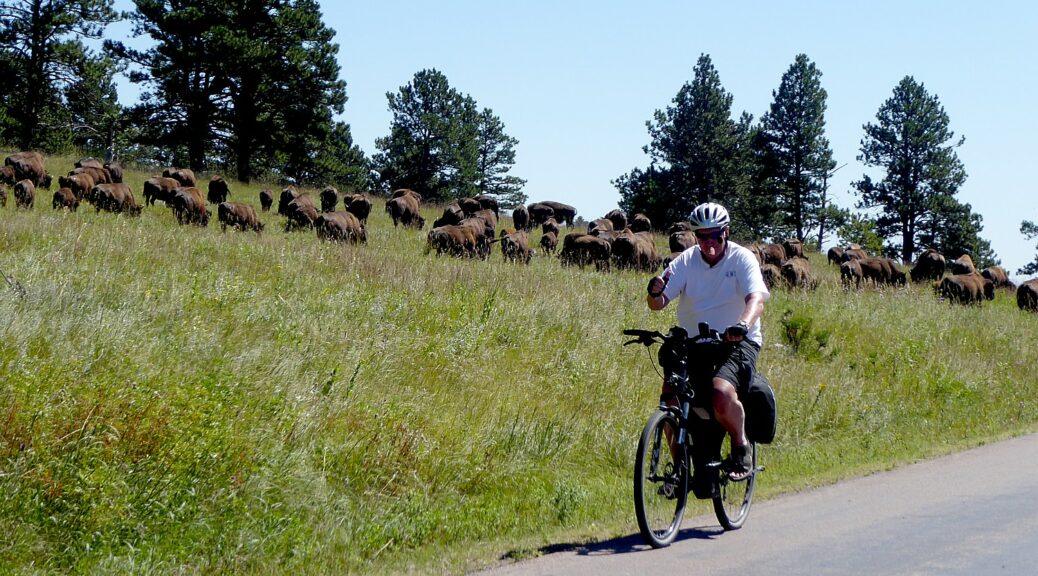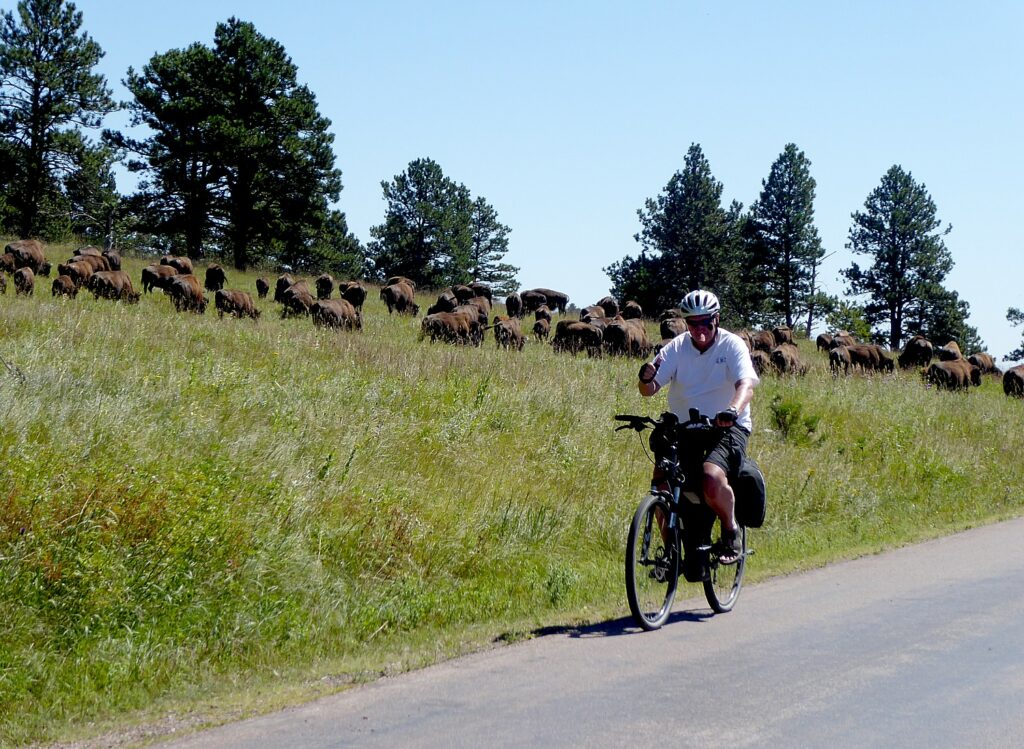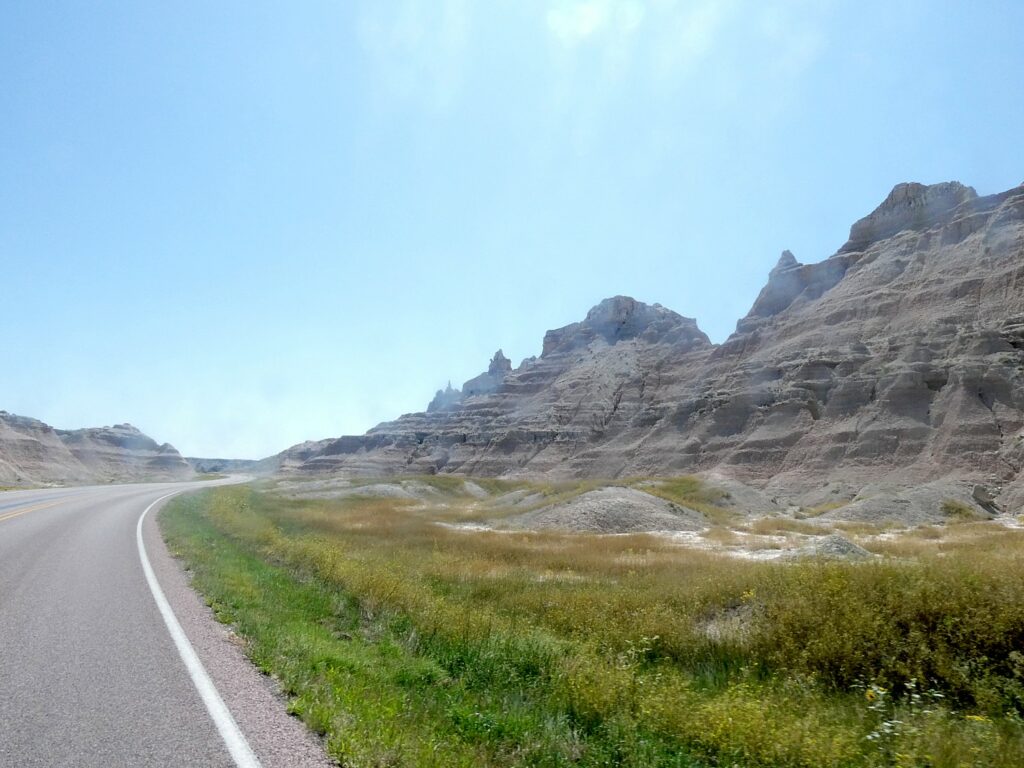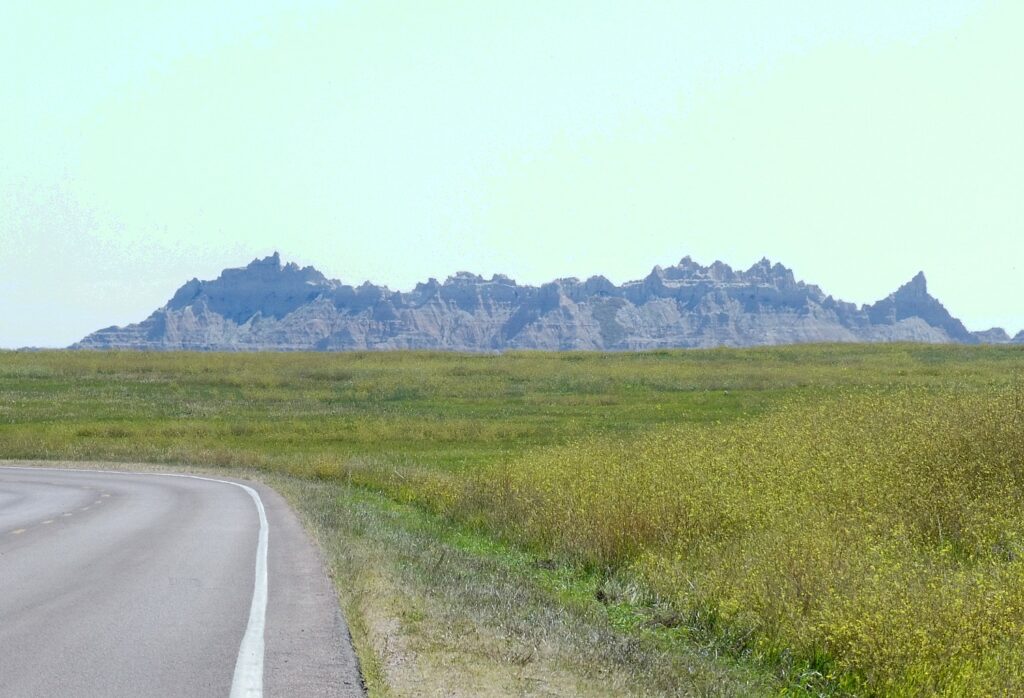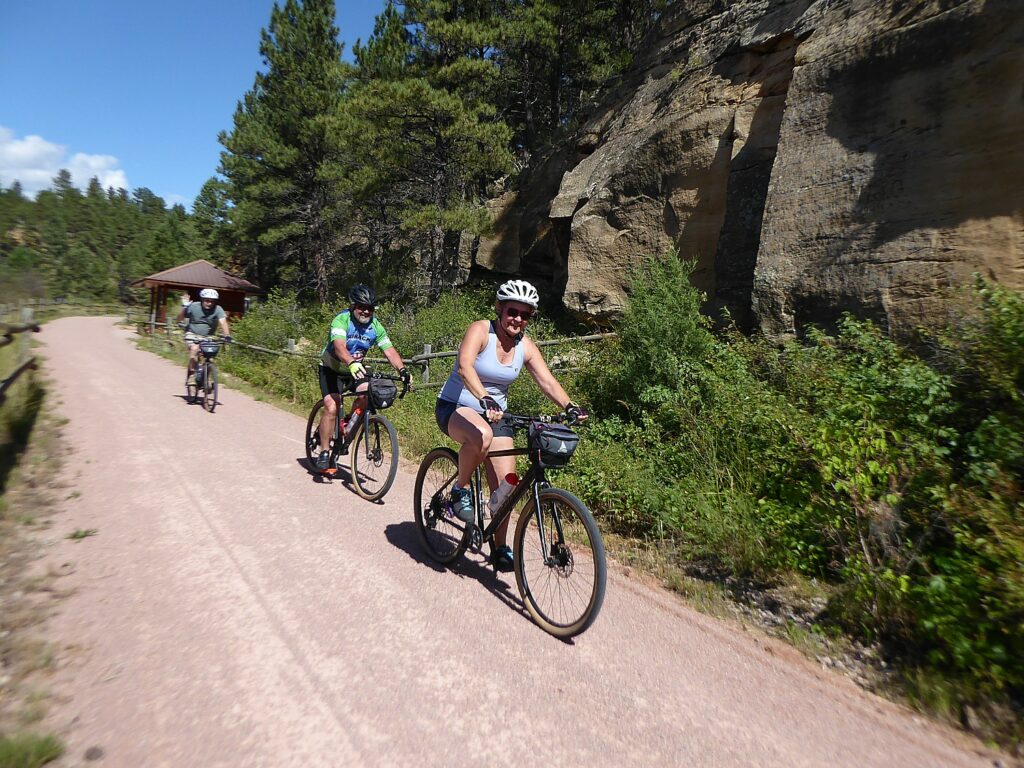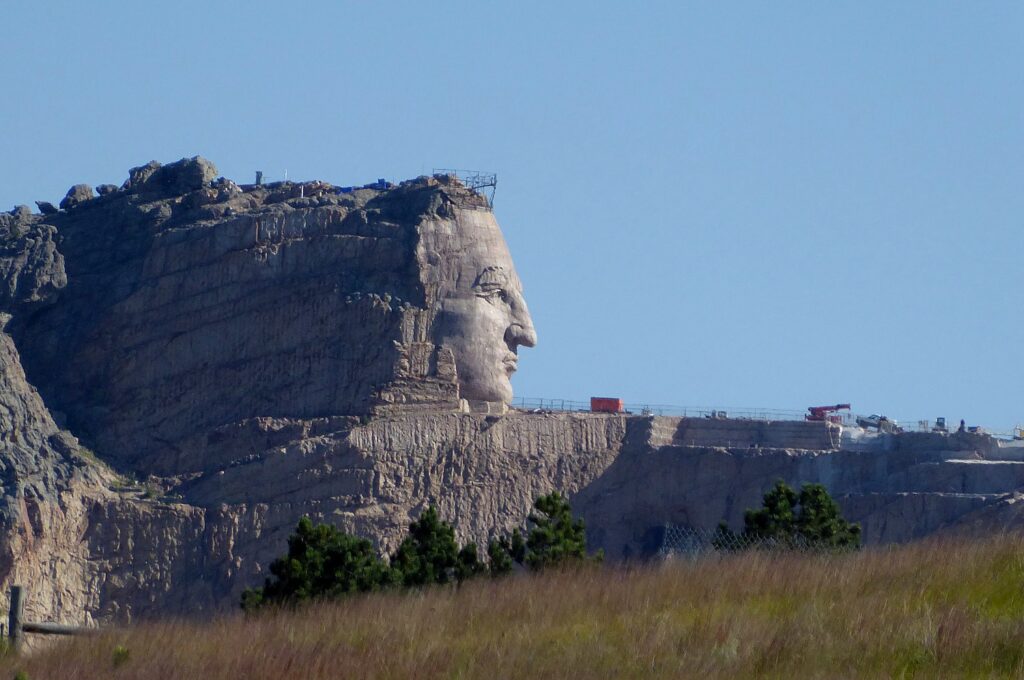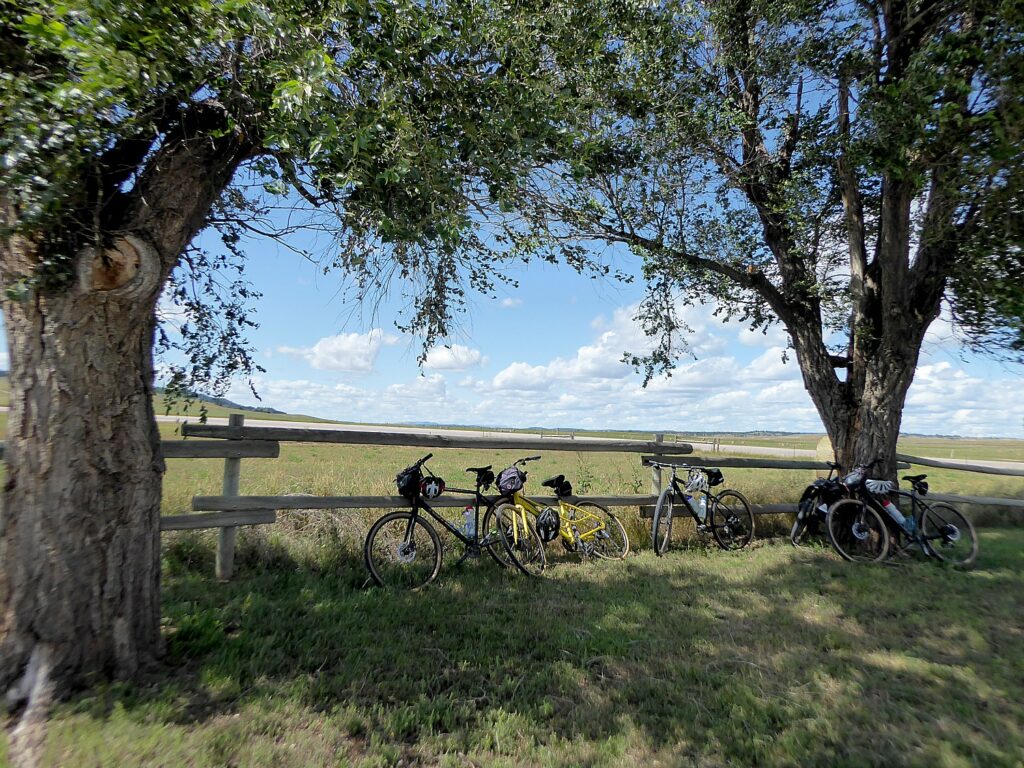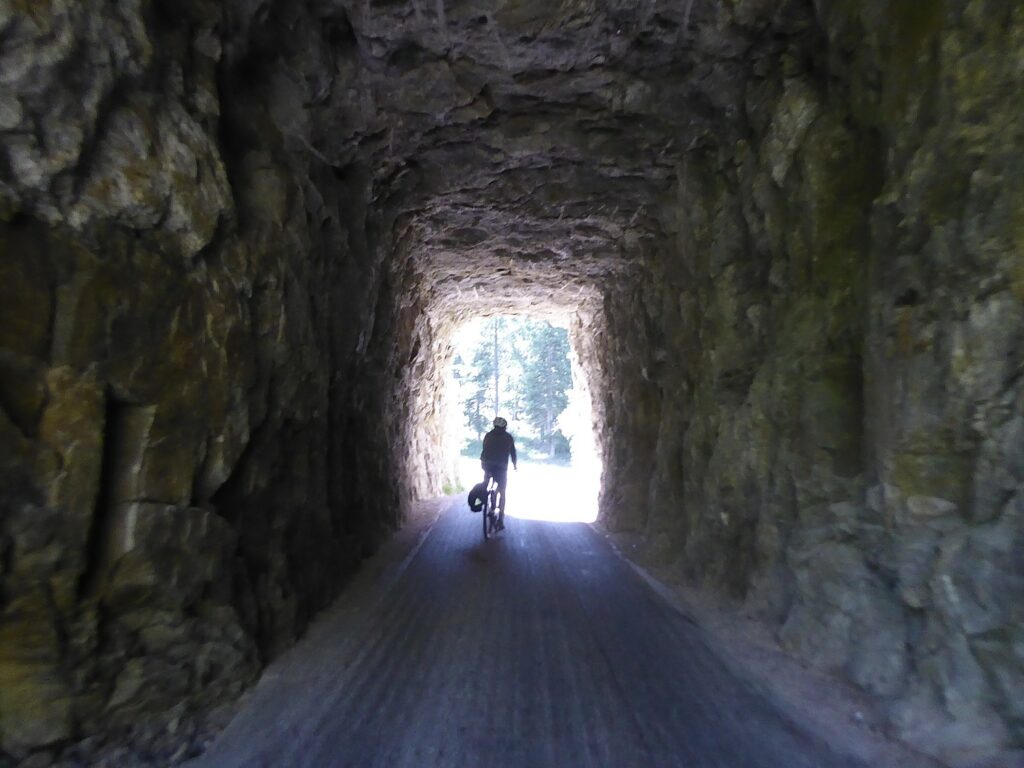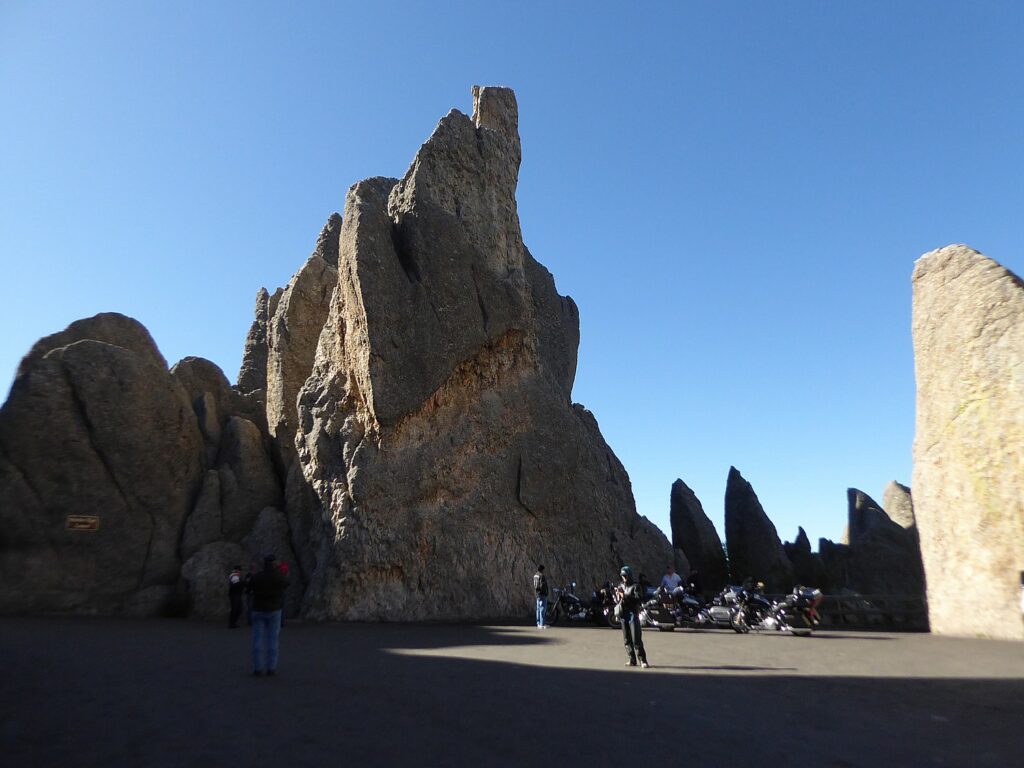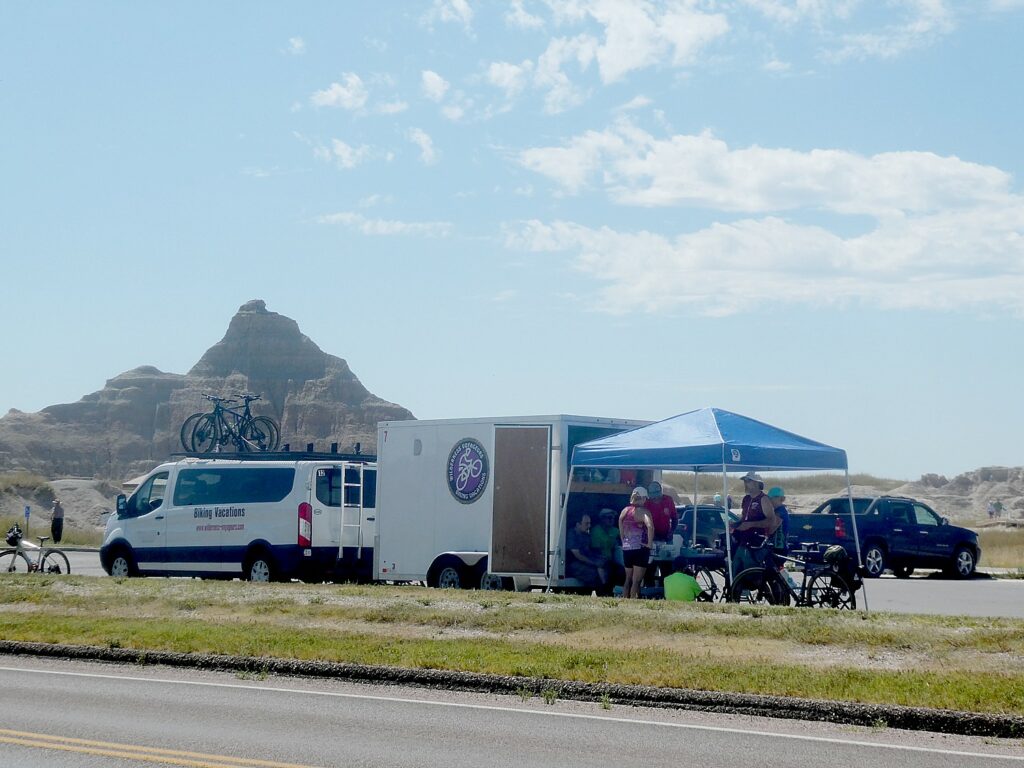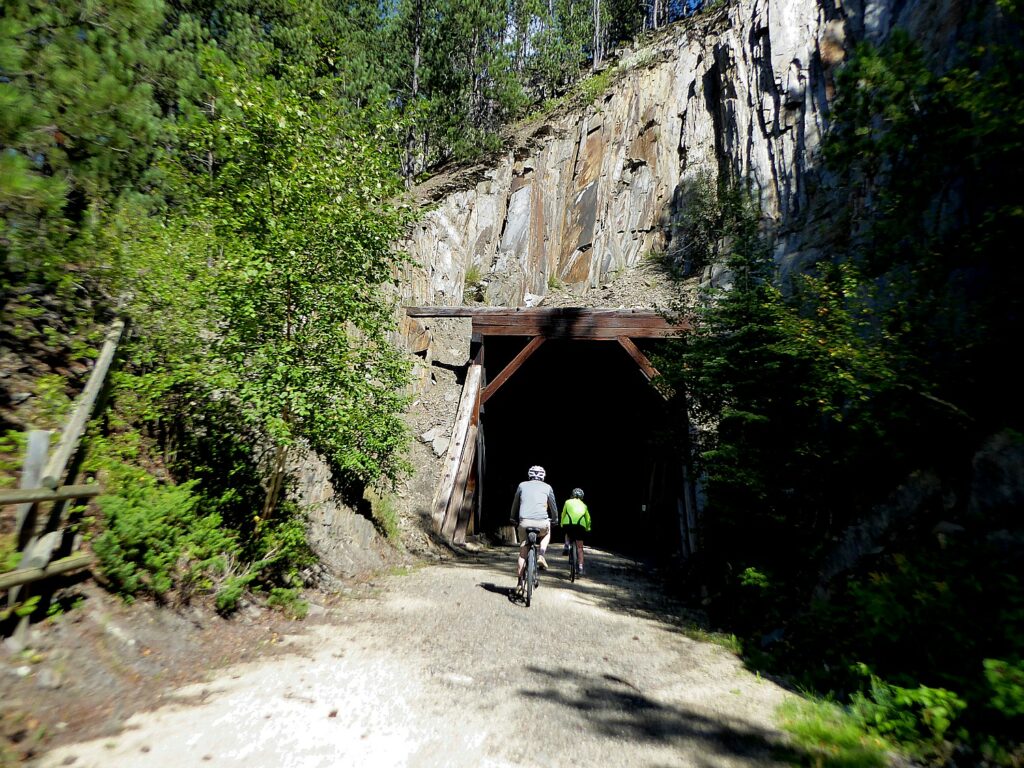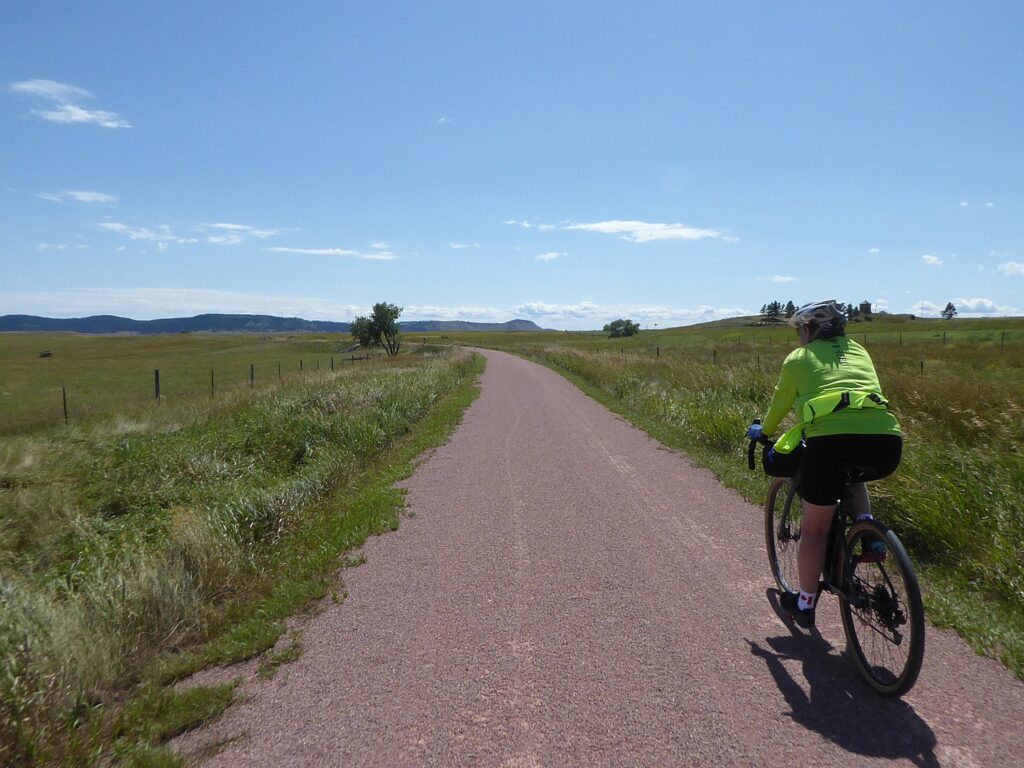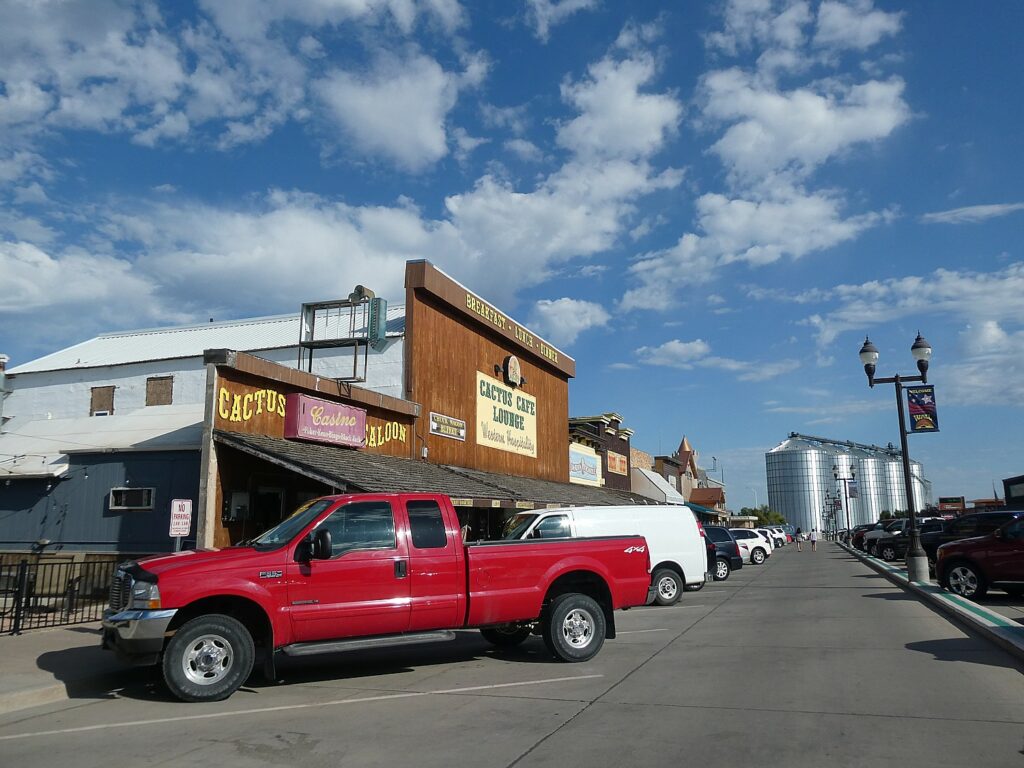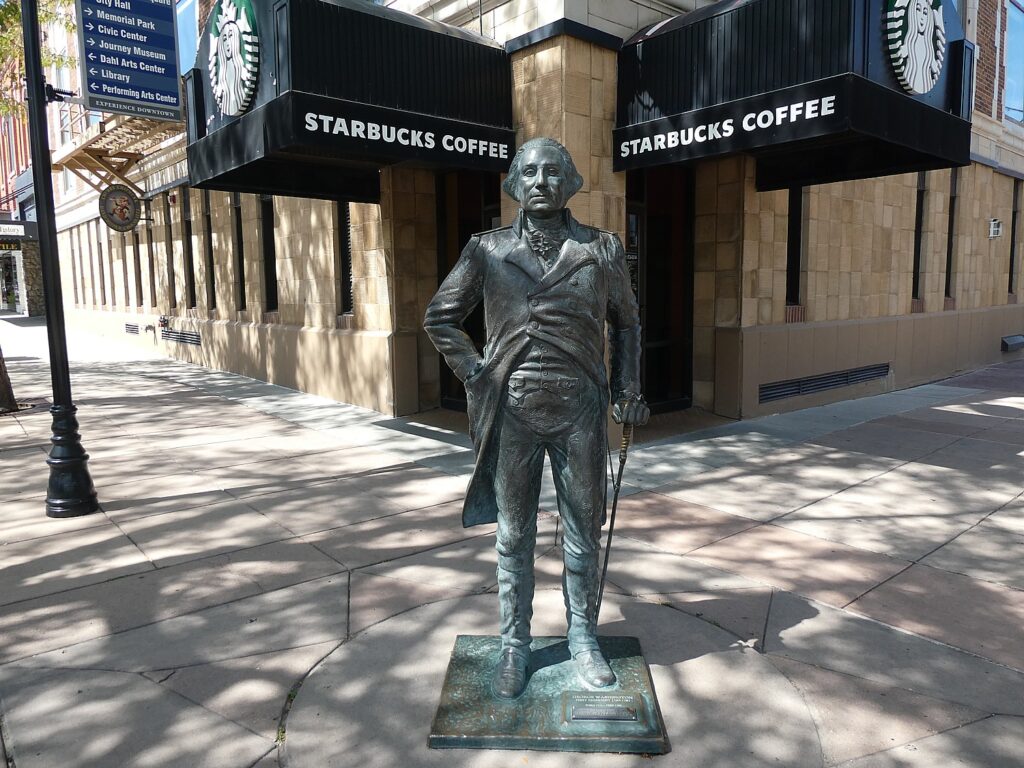
by Karen Rubin, Travel Features Syndicate, goingplacesfarandnear.com
If Deadwood, South Dakota – the endpoint of the 109-mile Mickelson Trail on the Wilderness Voyageurs’ six-day “Badlands and Mickelson Trail” bike tour – is a shrine to the Old Wild West, Rapid City is what the American West is today.
The Wilderness-Voyageurs Badlands trip (800-272-4141, Wilderness-Voyageurs.com) starts in Rapid City where I cleverly organize my trip to arrive the day before, staying at the famous, historic Alex Johnson Hotel (famous on its own, but made eternally famous for the part it played in Alfred Hitchcock’s classic film, “North by Northwest” – an autographed caricature of Hitchcock is behind the front desk).

Indeed, the Alex Johnson Hotel is a major attraction in itself (it’s red and white sign atop the building is iconic symbol of the city) – the hotel, still the third tallest in South Dakota, even provides a walking tour of many artifacts and architectural features that in their own way tell the story of Rapid City.
The Alex Johnson Hotel is listed on the National Register of Historic Places and a member of Historic Hotels of America, which means that successive owners have recognized their responsibility as stewards of these place-making hotels that harbor the story of their respective destination. To be accepted into the prestigious HHA program, which has nearly 300 members, a hotel has to faithfully maintain authenticity, sense of place and architectural integrity, be at least 50 years old; designated by the U.S. Secretary of the Interior as a National Historic Landmark or listed in or eligible for listing in the National Register of Historic Places; and recognized as having historic significance. (More information at HistoricHotels.org)
The Alex Johnson Hotel is all of these things and more. The hotel was built by Alex Carlton Johnson (1861-1938), who was vice president of the Chicago and Northwestern Railroad. Johnson was unusual for his time in that he respected and admired the Native Americans who lived in the area and developed his hotel as a tribute to the Sioux Indian Nation and honor its heritage. The structural design of the hotel integrates the heritage of the Plains Indians and the Germanic Tudor architecture representing German immigration into the Dakotas.
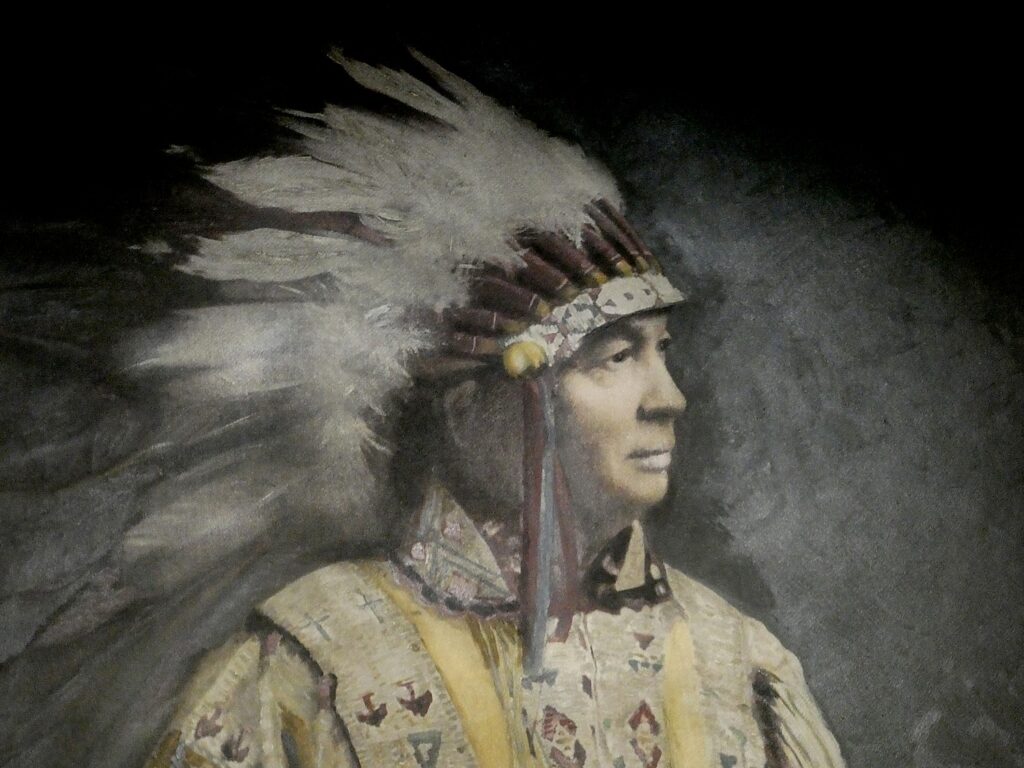
Construction began in 1927, coincidentally, just the day before work began on nearby Mount Rushmore. The hotel opened less than a year later, on July 1, 1928.
I follow the walking tour:
At the entrance of the hotel are sculpted Indian heads, taken from the design of Indian-head nickels and pennies.
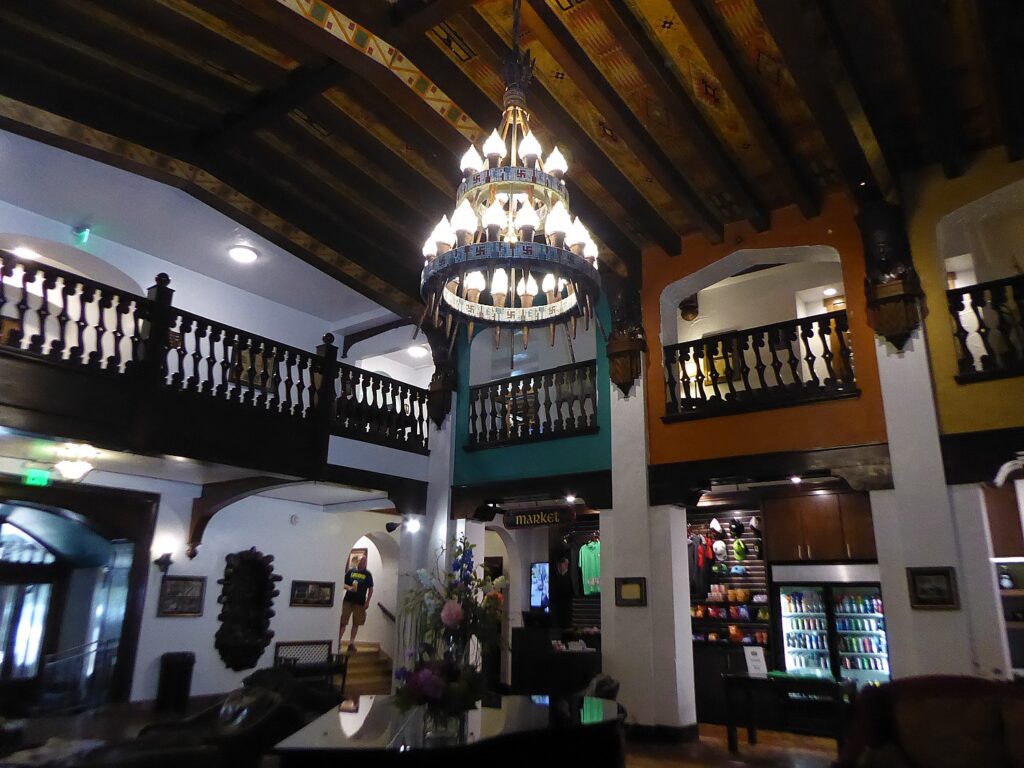
The entrance has an “AJ” tepee symbol embedded in the entry walkway. The lobby itself is designed in Native American tradition with “Sacred Four Directions” integrated in the lobby tiles. The Lakota Sioux people believed their four sacred powers were derived from the four directions: north (white) a symbol for the “Cleansing Snow.”; east (red), the “Morning Star” which gives “Daybreak Knowledge”; south (yellow) is “Warm Winds” which replenishes the land; west (black) is “Thunder Being,” giving strength and power in times of trouble. Among the signs is a symbol that resembles a swastika, but was long used by Native Americans since prehistoric times.
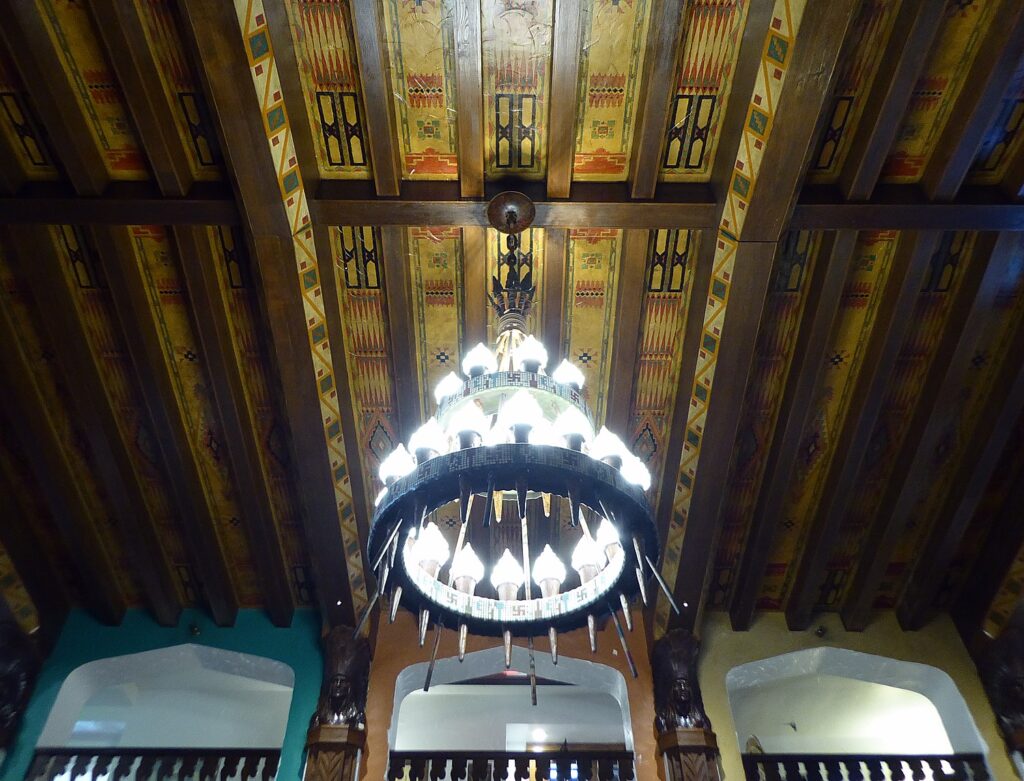
Suspended with chains, the chandelier that dominates the center is actually formed of war lances. It is in the shape of a teepee and made of concentric, decreasing-sized copper-clad wooden rings. The rings are decorated in authentic Sioux patterns.
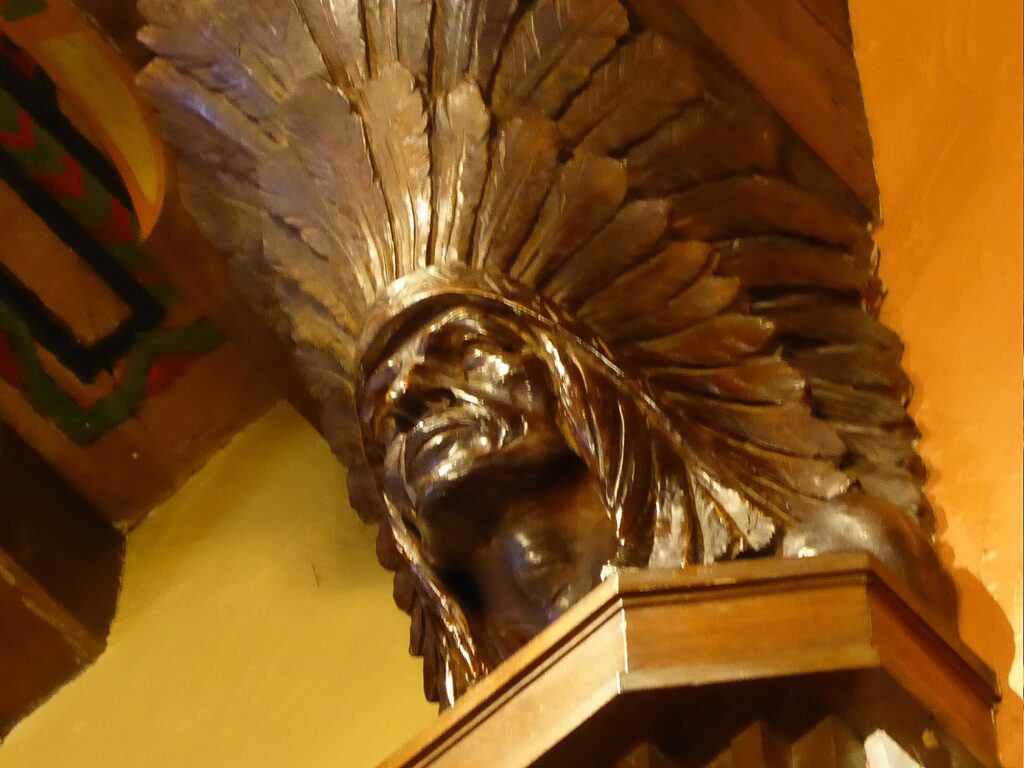
The exquisite ceiling incorporates stenciled Sioux designs between open beams. The brightly-colored patterns, originally painted with natural materials, are in the traditional “box and border” design. There are eight plaster-cast busts of Indian men that hold the beams.
The fireplace is formed of Black Hills stones. A huge rock in the keystone was selected for its resemblance to a buffalo head. The mantle is decorated with brands of local ranchers. Above the fireplace is a striking portrait of Alex Johnson in Sioux attire. Johnson was made an honorary blood brother of Chief Iron Horse in 1933, and named “Chief Red Star.” Another portrait of Johnson, in a more typical businessman pose, was commissioned by the 580 members of the Chicago Rotary Club in appreciation for his service as president (1924-25).
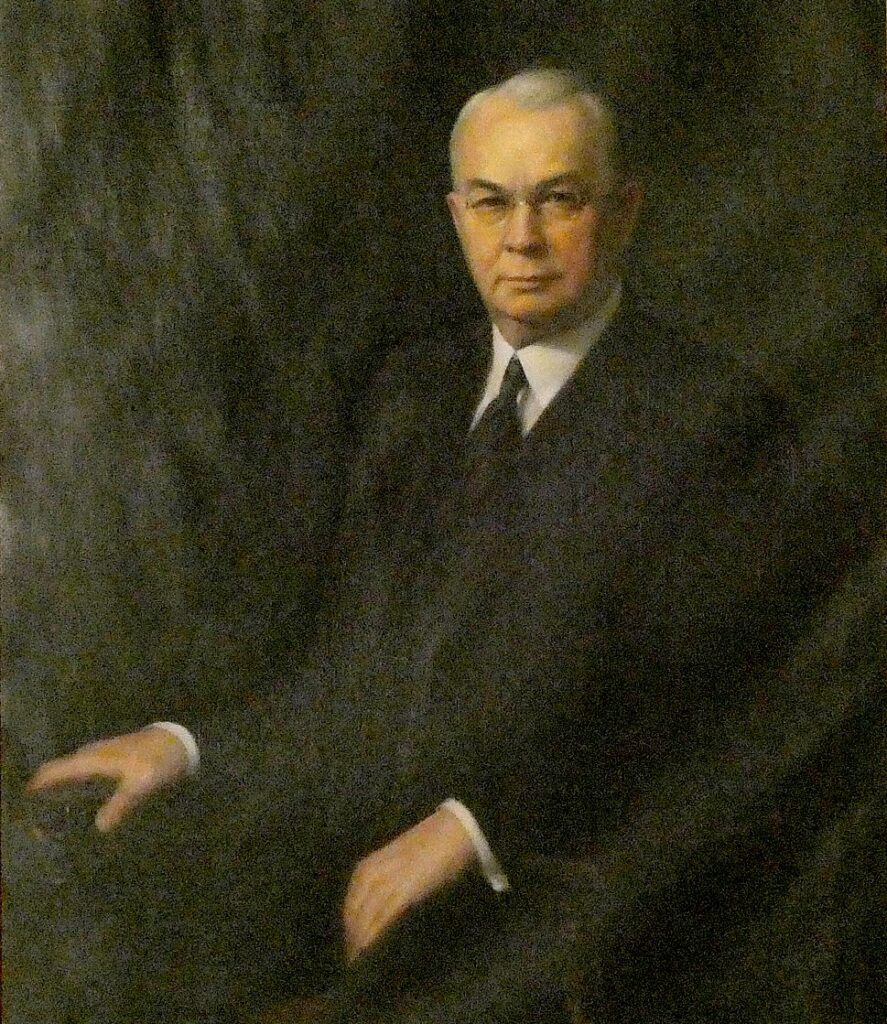
There are two bison heads mounted over the southwest entrance of the AJ’s Mercantile shop (American buffalo are apparently not buffalo at all, but one of two species of bison). I learn that “buffalo” was a corruption of “boeuf,” the name the French explorers used for the animal.
The mezzanine and second floor are graced with carved wood railings and provide a gorgeous vantage point to appreciate the Indian busts, ceiling painting and chandelier,
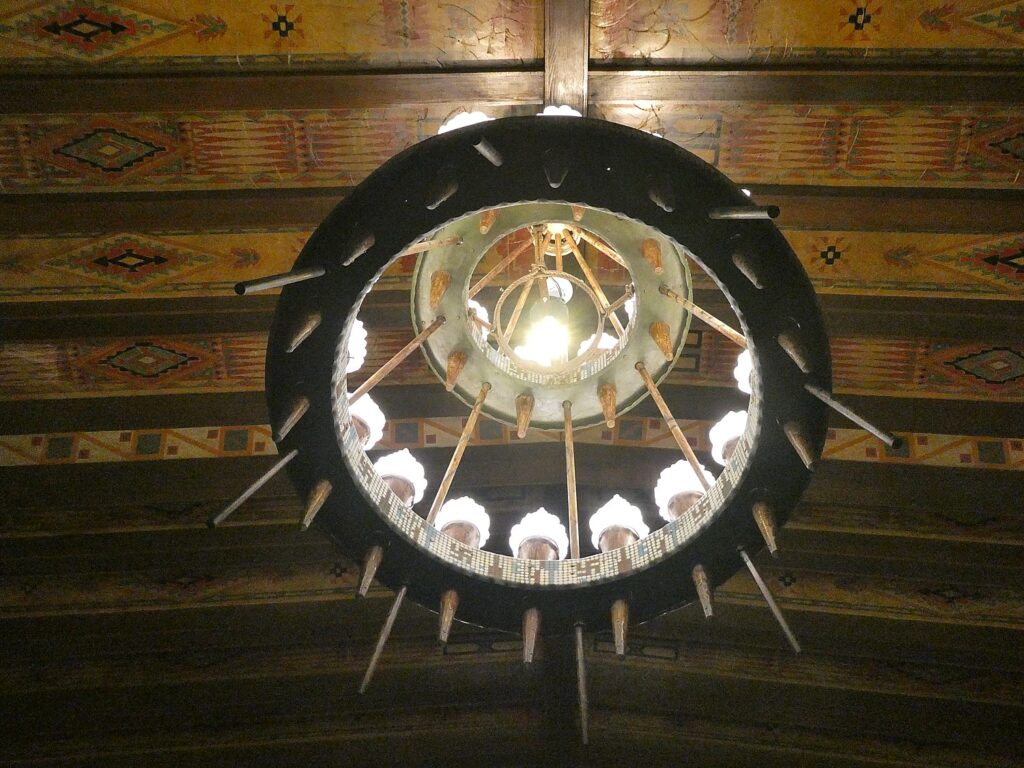
The ballroom, which also served as a nightclub back in the day, has four murals painted by Max Rheiner, an artist from Chicago, that realistically depict four well known areas of the region: Harney Peak, the Needles (which we will soon visit on the bike tour), the Badlands (we will soon visit) and Spearfish Canyon.
The Lincoln Room, the site of the original restaurant, has been restored to its original elegance. The ceiling lights are original. The wallpaper custom, hand-printed paper and the same design used in Abraham Lincoln’s home in Springfield Illinois. An original 19th century Lincoln print is on the wall. Meeting rooms are named after the four presidents on Mount Rushmore.
The hotel also offers Paddy O’Neill’s Irish Pub and Grill, named after the hotel’s first guest.
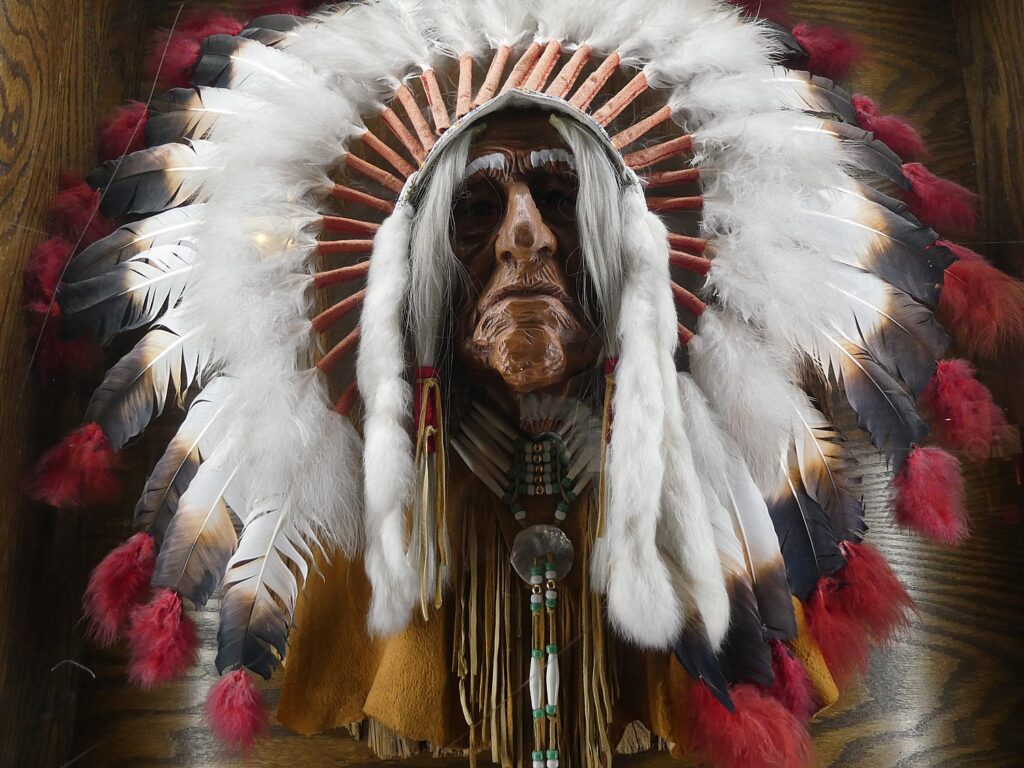
There is a kind of museum of exhibits – you can see Johnson’s actual headdress and other artifacts.
But that is not all. I learn that the Alex Johnson hotel is haunted – there is an entire book of testimonials from guests who have had sightings, and recently.
Ross Goldman, the front-desk fellow who has been giving me an orientation to the hotel and to Rapid City, points me to an entire Haunting book filled with people’s letters and descriptions of encounters.
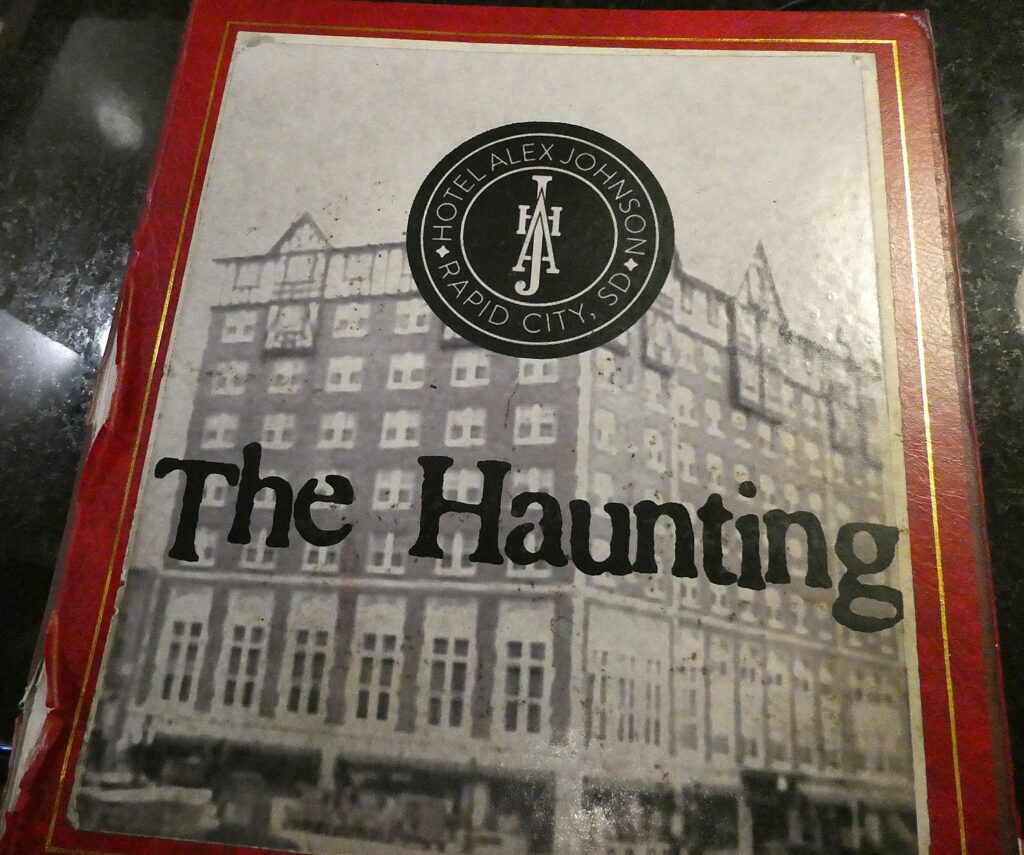
One of the rooms that is supposedly haunted, 304, was Alex Johnson’s private room where he stayed when he was in Rapid City, and where he died at the age of 90. But years before, his young daughter died in that room. People, especially children, say they have seen a child ghost In the Haunting book, I find a drawing by a little girl who stayed in room 304, who drew herself, her brother, and another girl with a dark, long dress you can see through (the ghost), dated July 5 2019. Children say they see ball rolling and that there is a knock on doors all at once.
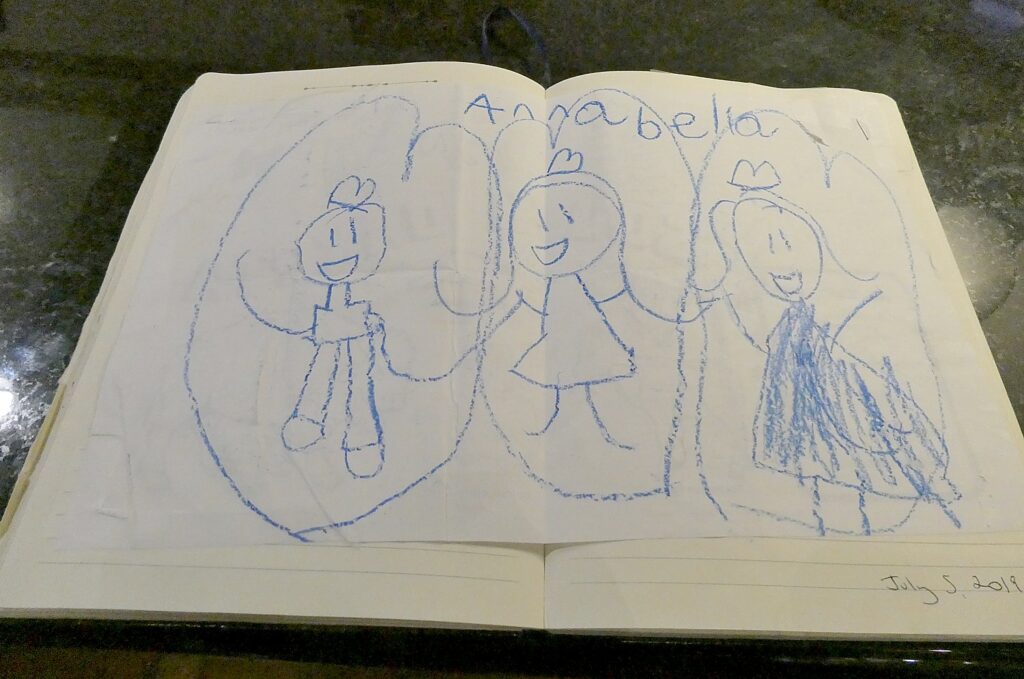
Another haunted room, 812, was where 60 years ago, a bride on her wedding night jumped, was pushed or fell out of window. Guests say that doors open, lights go on and some say when they sleep, they feel something pressing on their chest.
The macabre legends must have appealed to Alfred Hitchcock who used the Alex Johnson Hotel in his iconic thriller, “North by Northwest” and stayed here through the filming of the Mount Rushmore scenes– there is an autographed photo of Hitchcock behind reception desk (the lobby seemed much larger in the movie).
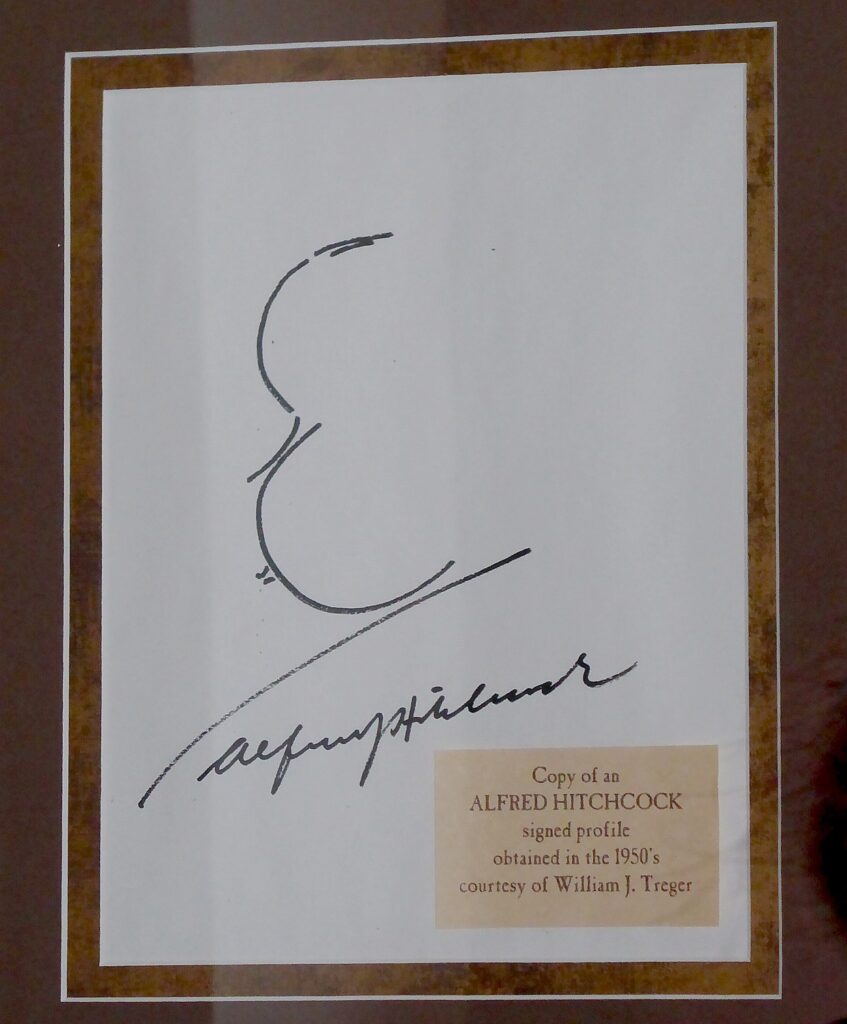
Goldman (the only Goldman in South Dakota, he notes), tells me his father is from Brooklyn, and came to Rapid City for his medical residency and stayed. What a small world: Goldman’s cousins live on my block in Long Island, New York. (He says there are just 300 Jews in the entire state; they hold their Passover seder in the hotel’s ballroom).
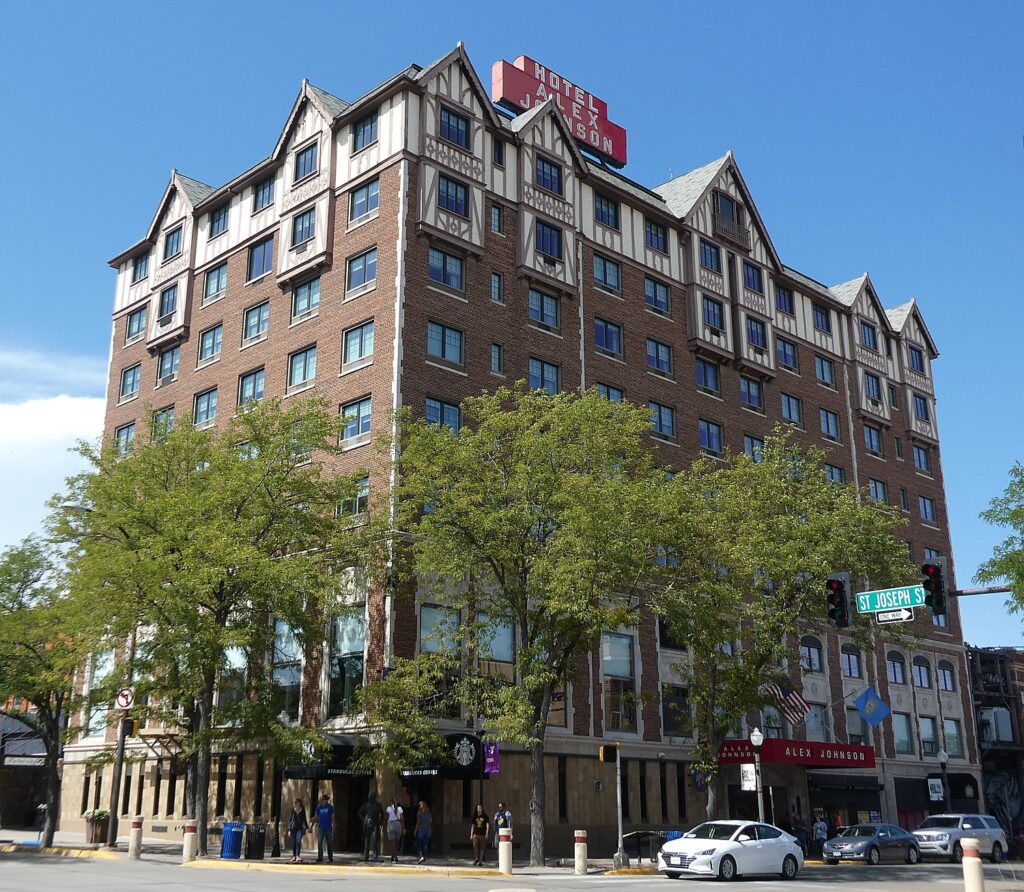
Later, after exploring Rapid City, I get to appreciate the Vertex Sky Bar on the hotel’s tenth floor (the Alex Johnson hotel is the third tallest building in South Dakota). Originally, there was a solarium here and an observation tower that was later used by KOTA radio station. Today, it is an upscale rooftop bar exclusively for members and hotel guests. It provides a wonderful view for the sunset behind the hills.
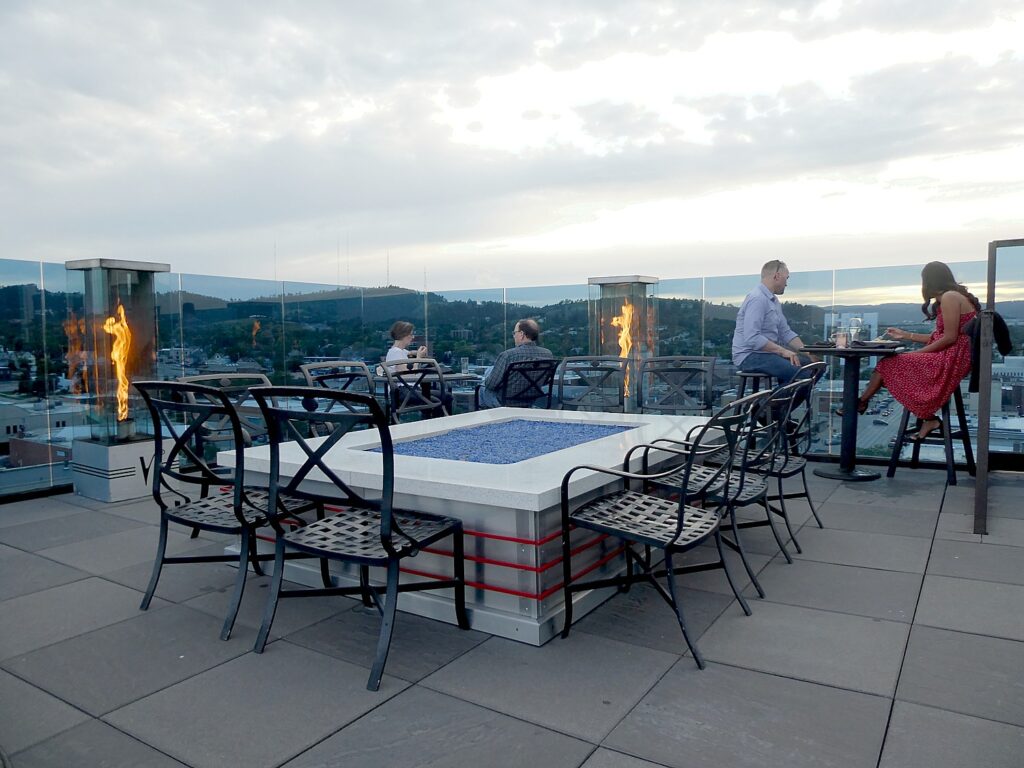
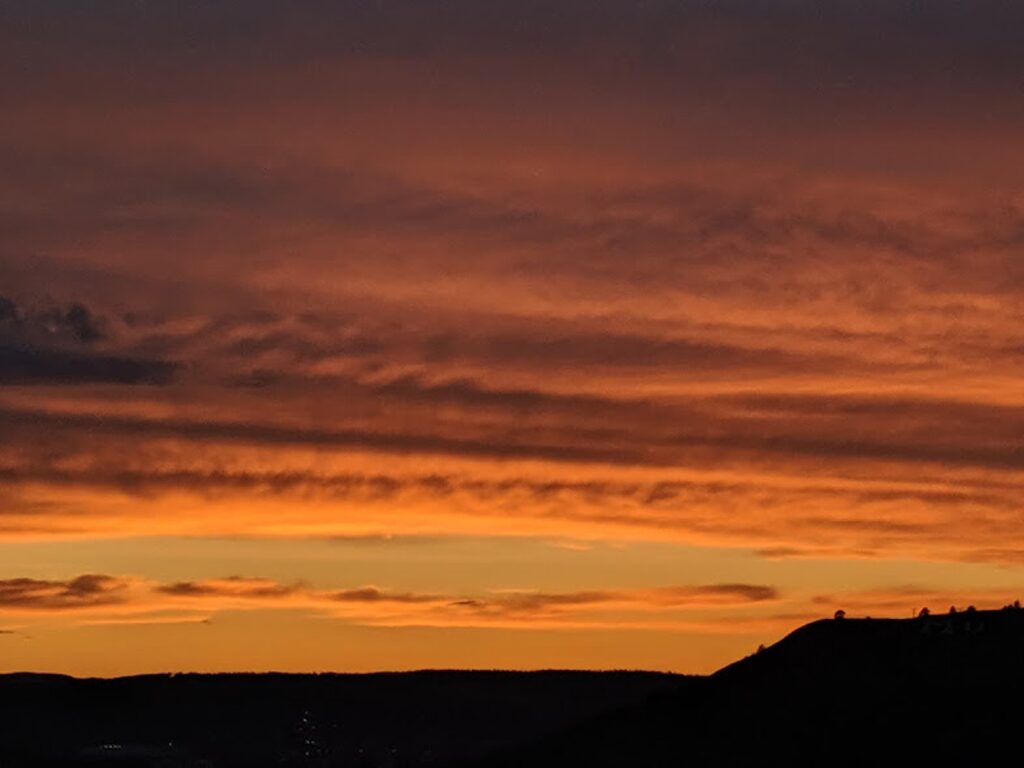
Goldman gives me some great tips for our bike trip – especially in Deadwood City, where he tells me to be sure to visit the cemetery where Wild Bill Hickok and Calamity Jane are buried, and where there is also a Jewish section.
And he orients me to Rapid City: Memorial Park was created after a major flood in 1972 collapsed the dam, in which 238 people died (signs in the park tell the story), leveling the poorest section of city. He tells me where to get the best buffalo burger (Thirsty’s).
And so I am off to discover Rapid City.
Rapid City makes the absolute most of whatever it has. The architecture except for a small historic district is mostly nondescript, but there is sheer brilliance in that 20 years ago, an artist began an ambitious program to have almost life-sized sculptures of every president on every corner of the two downtown boulevards, Main Street and St. Joseph’s Boulevard. This turned Rapid City into “The City of Presidents.”
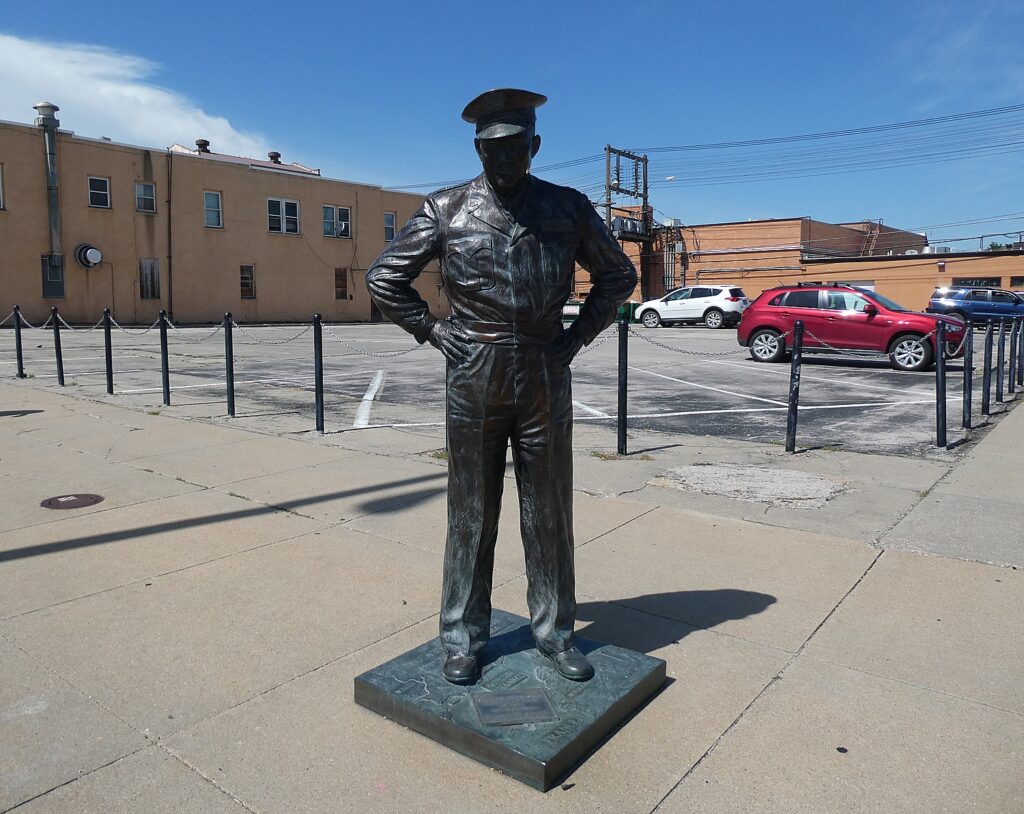
It is fascinating and fun to go in search of them (they aren’t in chronological or alphabetical order). Six artists produced the 43 sculptures, beginning in 2000:Obama’s statue, depicting the Election night scene when he came out holding his daughter’s hand, only went up a couple of months before; Lincoln is also portrayed with his son, Tad; FDR is shown standing at a podium with radio mics; Taft looking amazingly svelte, shown as the first president to throw out the first pitch at a baseball game. There is a self-guided walking tour and a Presidential Scavenger Hunt. It is really fun to try to see all of the presidents. What is most interesting is how these significant personages are set in such ordinary circumstance on nondescript small-town America street corners.
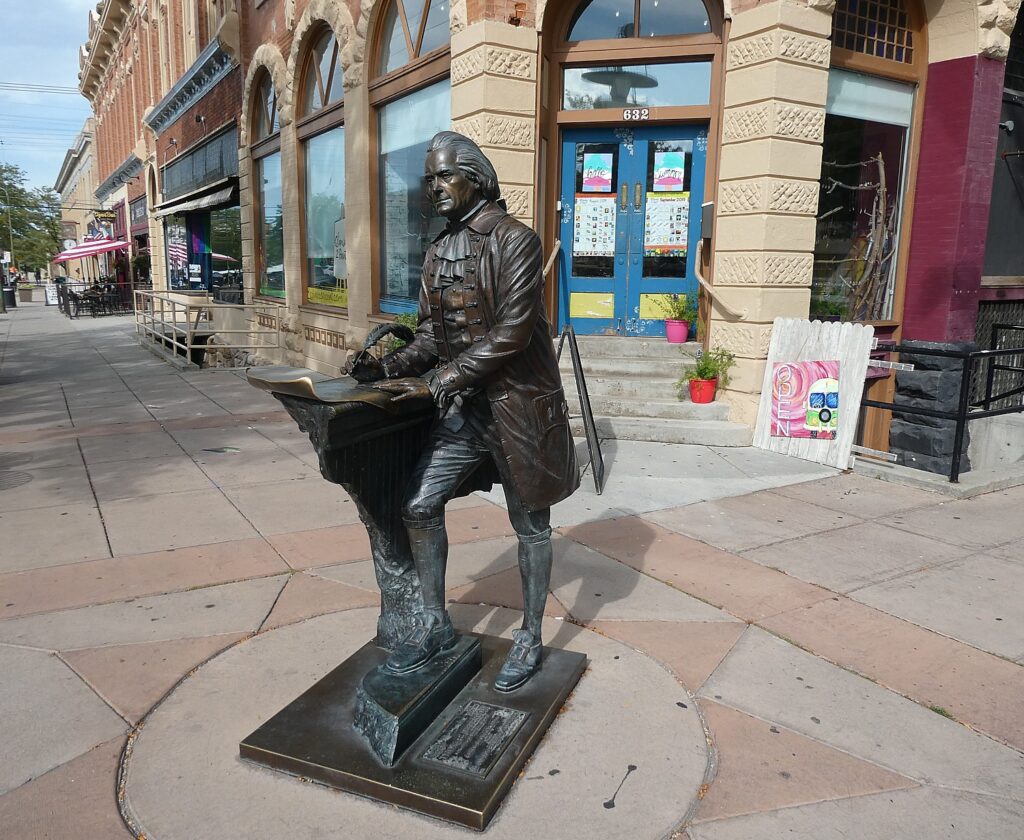
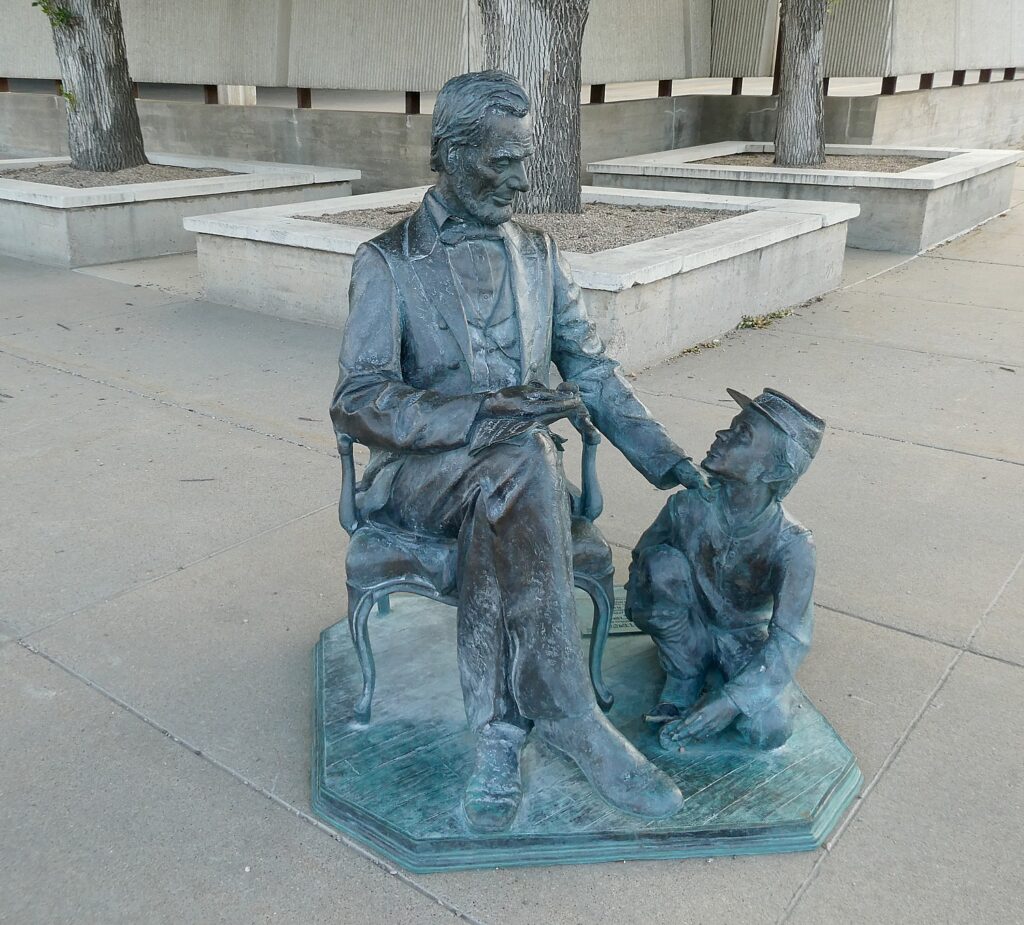
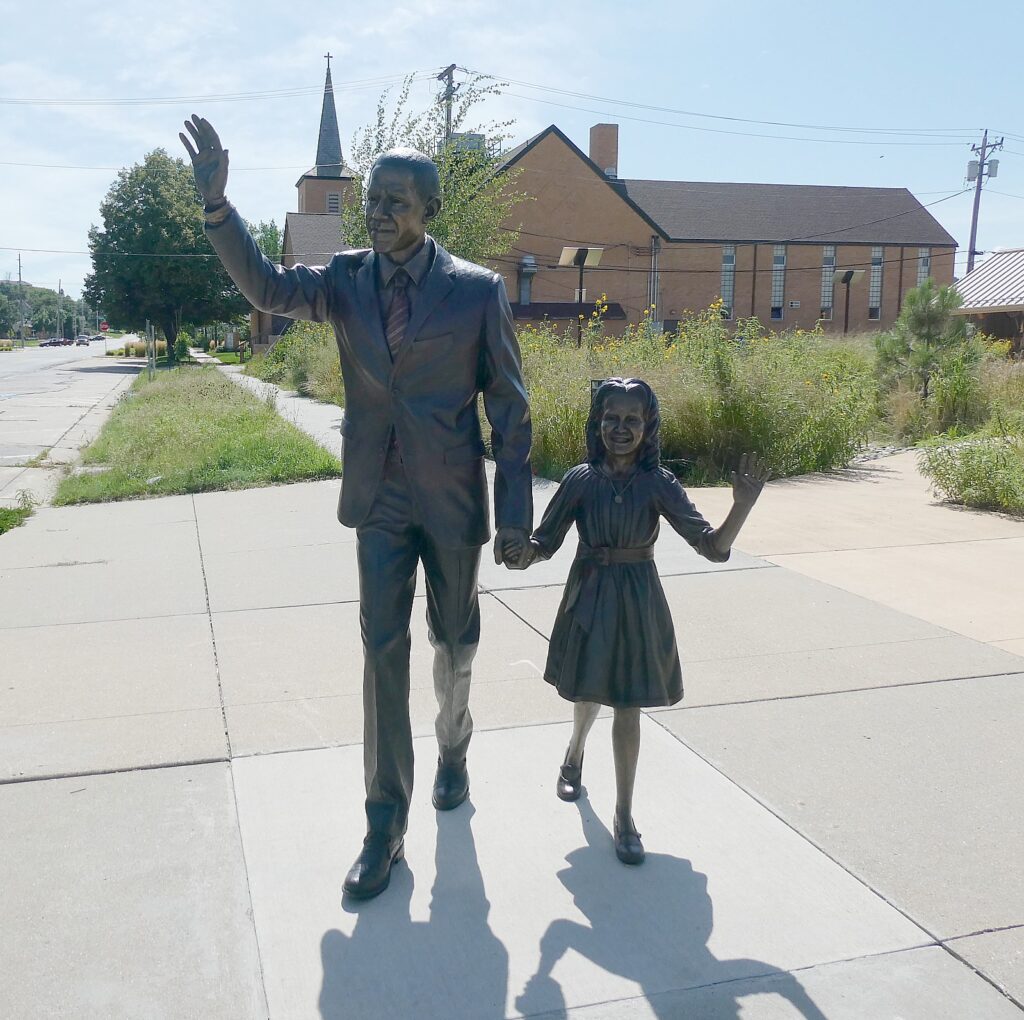
A notable exception to the presidents is a bust, “Mitakuye Oyasin” (“We are all related”) by DC Lamphere, from a drawing by Richard Under Baggage, representing “hope for reconciliation, dignity and respect for all the human race.” The earth is in the shape of a hoop or circle of life; crossed pipes represent world peace; the eagle symbolizes all flying creatures, and communication with Tunka Sila; wisdom and the healing arts are represented by a grizzly bear, and a long and productive life is symbolized by a turtle. “The bison reminds us of our ancestors’ healthy lifestyles, free from famine, and also of the white Buffalo Calf Woman who brought us the pipe.”
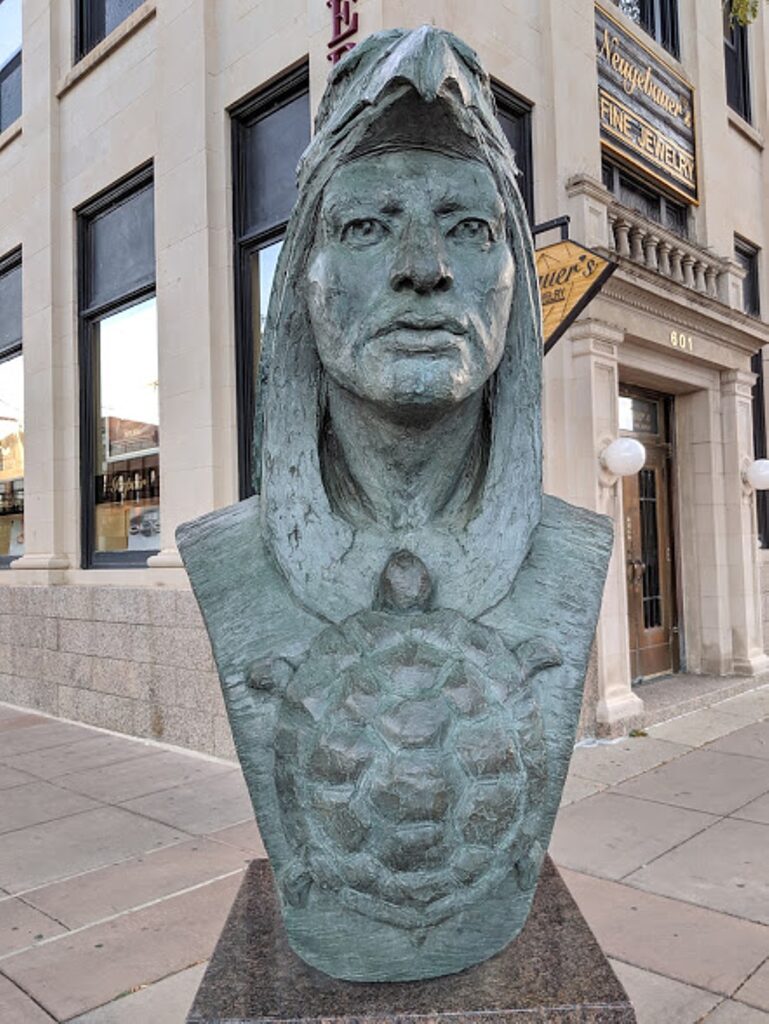
Another marked contrast to the presidents on every other corner is outside a remarkable shop, Prairie Edge: “Hunkayapi” also was created by local artist Dale Lamphere. The statue, depicting a Lakota naming ceremony, is intended to reflect the warmth in Lakota families, the wisdom of a Lakota elder and the teaching of the Lakota heritage to the next generation.
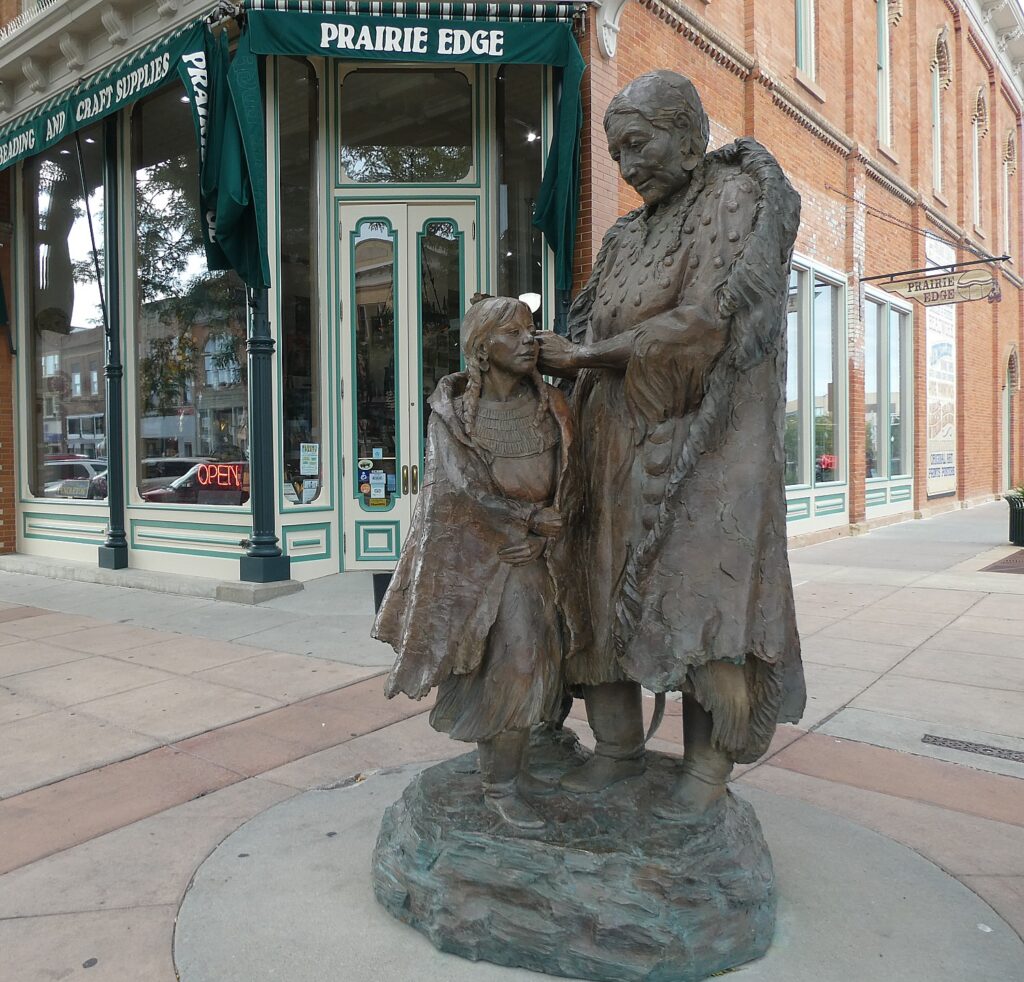
Prairie Edge is one of the most fantastic Native American shops anywhere. It is almost a museum, with numerous contemporary Native artists who have their own displays, biography and museum-quality art (I learn about quillwork). There is also clothing, including Pendleton & Pilson, blankets and housewares, books and music, and a Sioux Trading Post, and tee shirts and souvenirs and yes items popular in tourist shops on sale, like an old-fashioned mercantile store.
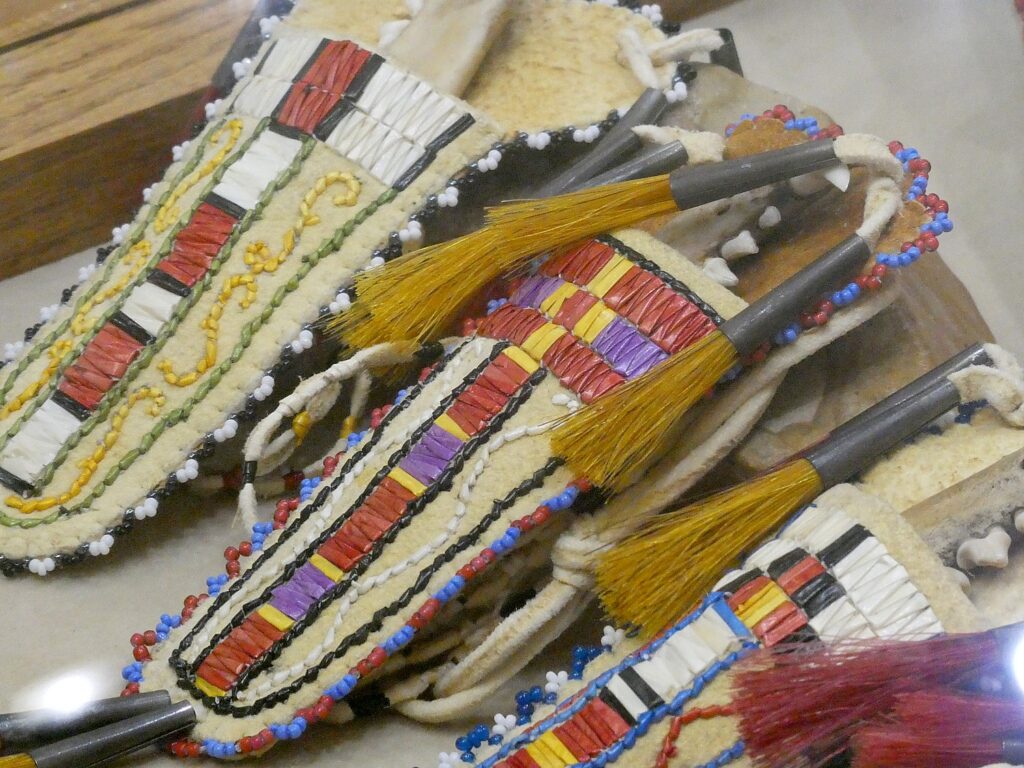

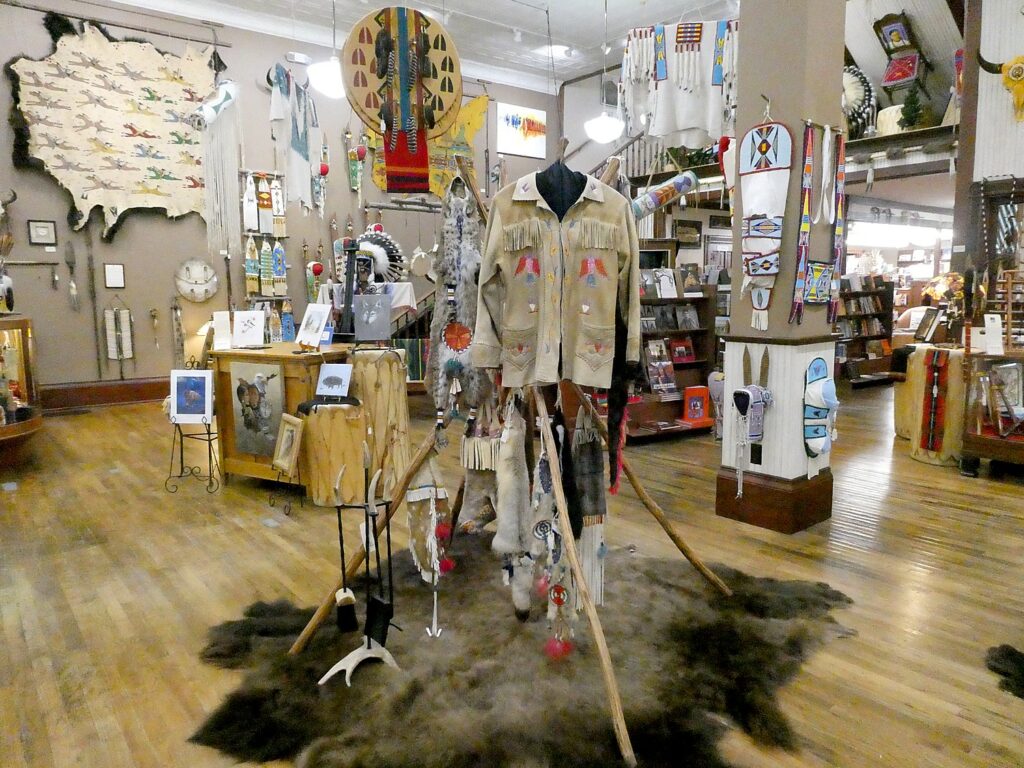
The shop contains a fine art Plains Indian Gallery, a Buffalo Room with bison leather furnishings. There is also the Italian glass bead library boasting the world’s largest selection of glass beads, with over 2,600 different styles and colors, from the same Venetian guild that supplied fur traders in the 19th century used for trade, including used in trade for the island of Manhattan; after the Societa Veneziana Conterie closed in 1992, Prairie Edge bought the remaining inventory of 70 tons of beads. (Prairie Edge, 606 Main Street, Rapid City SD 57701, 800-541-2388, 605-342-3086, www.prairieedge.com).
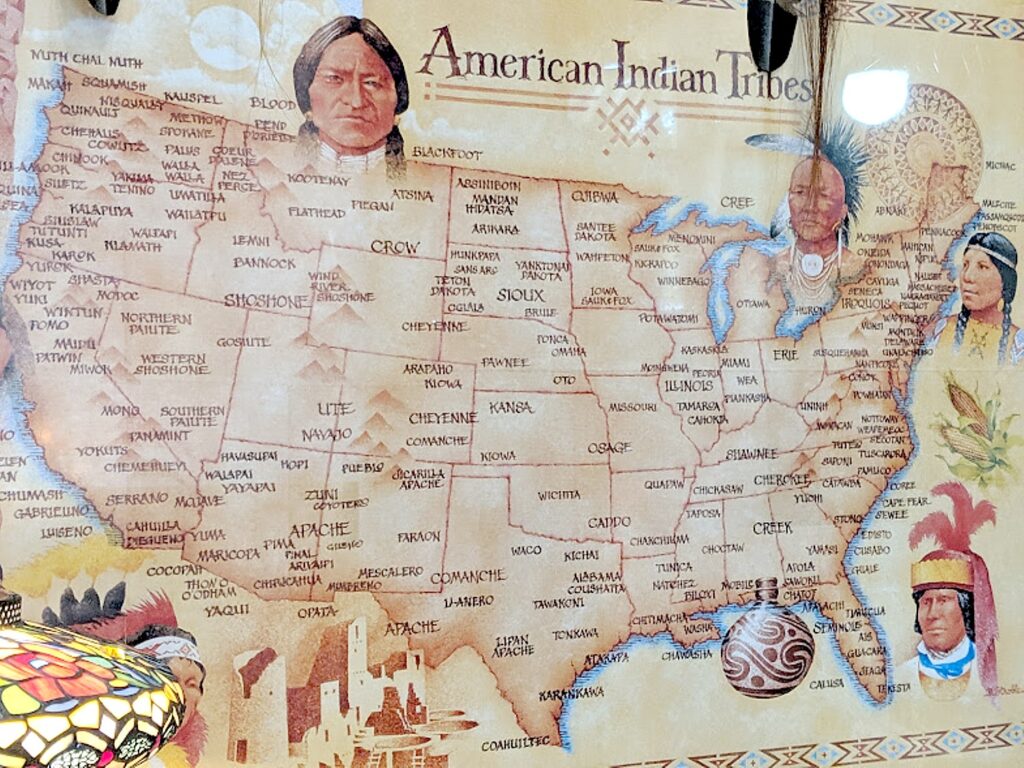
I think about what Goldman told me about continued tension between Native Americans and the “settlers” (for lack of a better word), “Other places are more assimilated. South Dakota has nine Indian reservations. The two largest reservations – Pine Ridge, Rosebud – make Appalachia look like Beverly Hills.,” he told me. And his remarks echo for me later when I visit the Crazy Horse Memorial on our Mickelson Trail ride.
Prairie Edge is housed in an 1886 building in Italianate style that began as the L. Morris Dry Goods and Clothing store with a dentist’s office on the second floor and rooms to rent. Known as the Clower Building, it is most famously remembered as the Jack Clower Saloon (1895-1917), a cowboy bar ion its day. It is one of the most beautiful buildings in Rapid City.
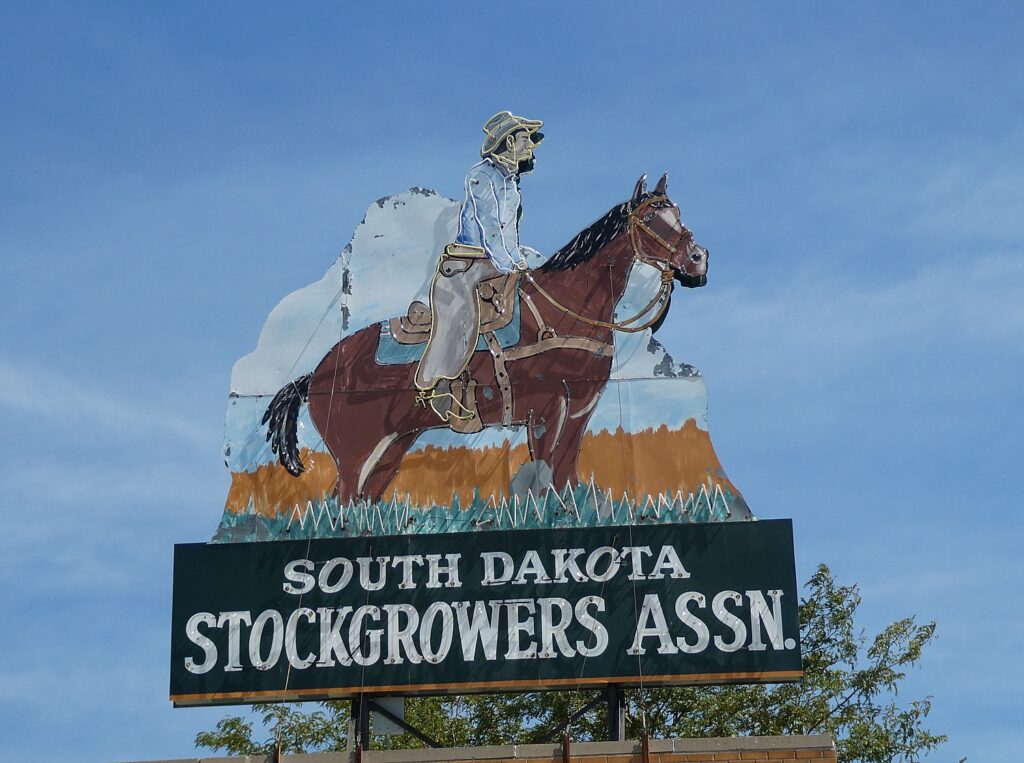
What you do expect in an open-carry state that still prides itself as being the wild west, are the gun shops. There is the biggest gun shop I’ve ever seen, First Stop Gun & Coin. (I am amazed at how heavy rifles are; there are “My First Rifle,” child-sized like starter violins, and some pink and decorated rifles geared for women.
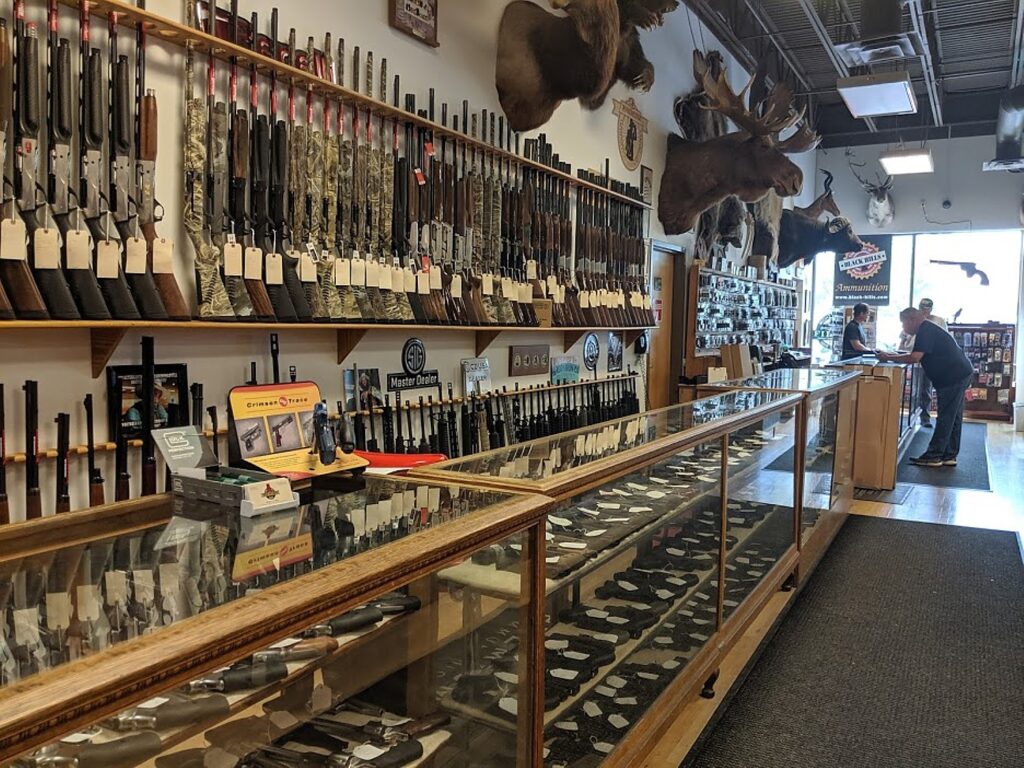
I wander over to Main Street Square, with a spray fountain, Astroturf and stage for performances, and public restroom.
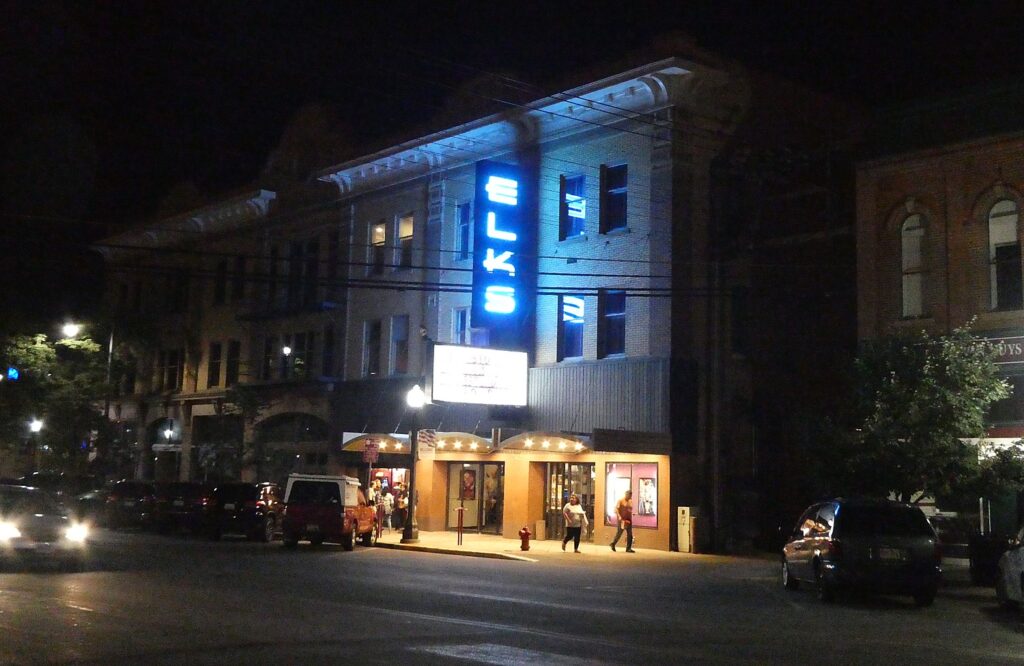

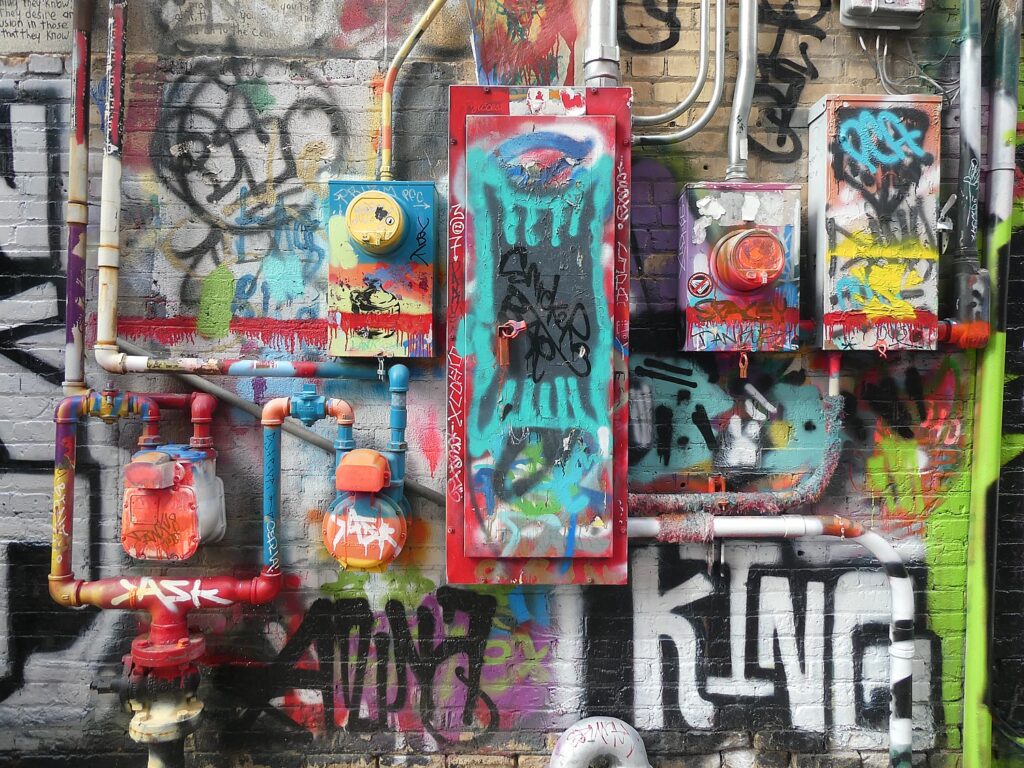
There is a surprising variety of restaurants you wouldn’t expect in a place that calls itself “City of Presidents” – Nepali, Mexican (considering how far from the Mexican border we are). Goldman has recommended Thirsty’s, which looks like a pool hall, as having the best buffalo burger in town. I opt for the Firehouse Brewing Company in the historic firehouse next door to Prairie Edge. I take note of a large 1883 photo mural depicting the store that had stood on the site with store names of Jewish proprietors: Herrmann Treber & Goldberg Groceries, Liquors and Cigars Wholesale.
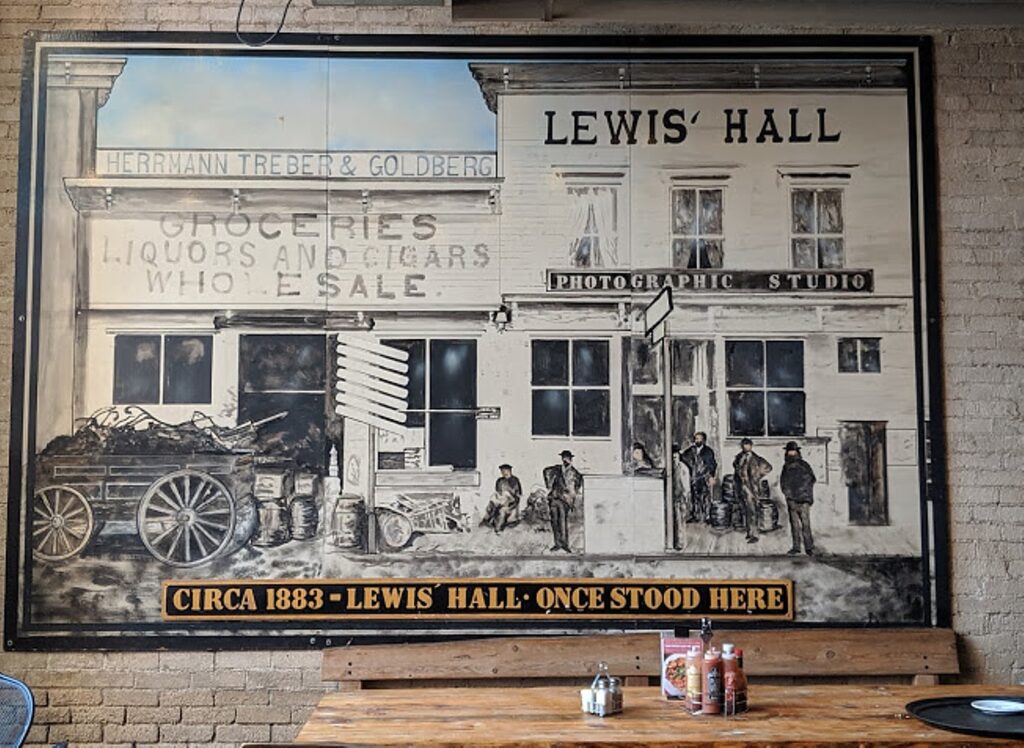
Back at the Alex Johnson Hotel, I go up to the Vertex Sky Bar on the 10th floor to take in the sunset.
The Alex Johnson Hotel today is independently owned by the Bradsky family of Rapid City, acquired in 2008 on the hotel’s 80th anniversary, and refurbished with respect and sense of stewardship for its historic significance and importance to the city. (The family owns several properties, under the Liv Hospitality banner, in Deadwood and Rapid City, including Cadillac Jack’s and Tin Lizzie’s in Deadwood and Watiki water park in Rapid City. (www.LivHotelGroup.com)
Hotel Alex Johnson Rapid City, Curio Collection by Hilton, 523 Sixth Street, Rapid City SD 57701, 605-342-1210, alexjohnson.com.
More information at Visit Rapid City, 512 Main Street, Rapid City SD 57701, 800-487-3223, 605-718-8484, www.VisitRapidCity.com.
Minuteman Missile National Historic Site
With better planning, I would have also plugged into my itinerary a visit to Minuteman Missile National Historic Site. The site provides an opportunity to explore the Minuteman II system’s role as a nuclear deterrent during the Cold War and visit sites rarely seen by civilians while in use, but that nevertheless loomed large on the geo-political landscape, and in these tense times, be reminded about what a threat nuclear weapons are.
I first became aware of the site watching an extraordinary documentary, “The Man who Saved the World,” about Stanislav Petrov, a former lieutenant colonel of the Soviet Air Defense Forces and his role in preventing the 1983 Soviet nuclear false alarm incident from leading to nuclear holocaust. Now, with Trump and Putin at odds over renegotiating a nuclear arms treaty while boasting about new weapons, it is more important than ever to be reminded of how quickly things can go astronomically wrong.
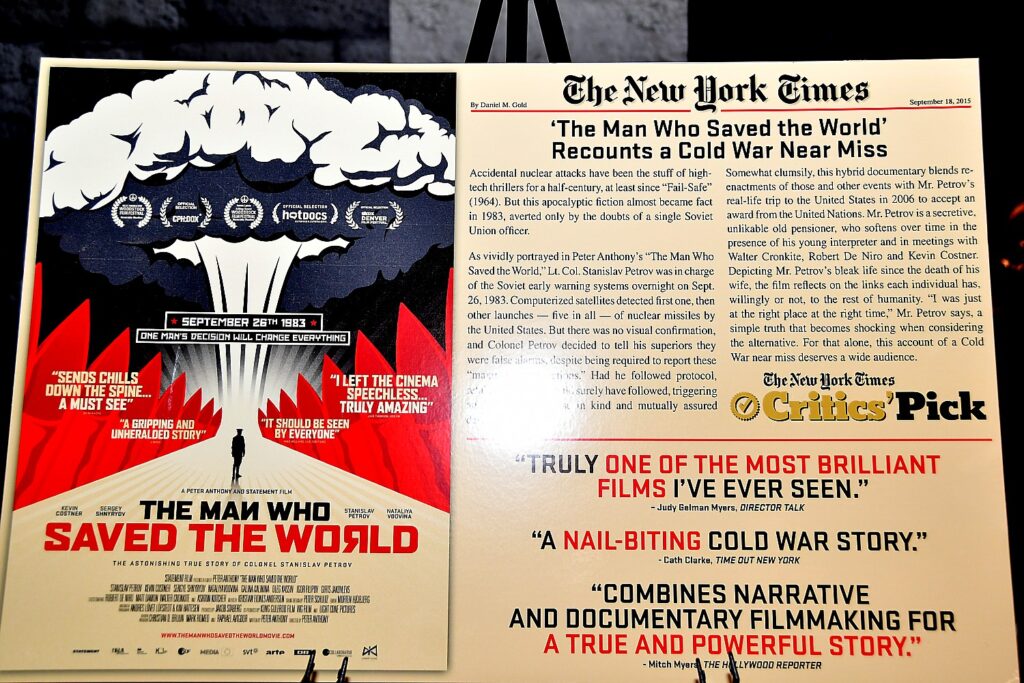
The park consists of three sites along a 15-mile stretch of Interstate 90 in western South Dakota: the Visitor Center, Launch Control Facility Delta-01 and the Delta-09 Missile Silo.The Visitor Center is located immediately north of I-90, exit 131. The two historic sites which make up the park are four miles (Launch Control Facility Delta-01) and 15 miles (Launch Facility Delta-09) from the Visitor Center. No public transportation systems serve the park. A variety of maps are available to assist you visit and historic understanding. – passed Wall on I-90 (visitor center at exit 131). All tours of the Delta-01 Launch Control Facility require advanced reservations. Reservations can be made on-line or by phone at 605-717-7629. (www.nps.gov/mimi/index.htm, https://www.nps.gov/mimi/planyourvisit/directions.htm)
More information from South Dakota Department of Tourism, 605-773-3301, https://www.travelsouthdakota.com/
_________________________
© 2020 Travel Features Syndicate, a division of Workstyles, Inc. All rights reserved. Visit goingplacesfarandnear.com, www.huffingtonpost.com/author/karen-rubin, and travelwritersmagazine.com/TravelFeaturesSyndicate/. Blogging at goingplacesnearandfar.wordpress.com and moralcompasstravel.info. Send comments or questions to FamTravLtr@aol.com. Tweet @TravelFeatures. ‘Like’ us at facebook.com/NewsPhotoFeatures
